Travel Reservation Hotline
Call and book your hotel now.
Domestic Toll-Free for US and Canada: 1-800-997-1438
Worldwide: +1-817-983-0682
- Rio de Janeiro Info
- Parks and Wildlife
- Sightseeing
- Theatre and Dance
- Restaurants
- Exhibitions
- Travel Tips
- Feature Your Business
- Top Things To Do
- Hot Sellers
- Outdoor Activities
- Airport & Ground Transfers
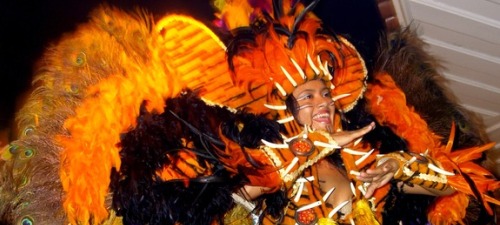

Ginga Tropical - Brazilian Samba and Folklore Show
Duration: 1.5 hours (approx.) Location: Rio de Janeiro, Brazil
On this 1.5-hour live show, discover the Brazilian culture through dance at Leblon theatre, Rio de Janeiro. At the end of the show, you can dance, samba with the artists.
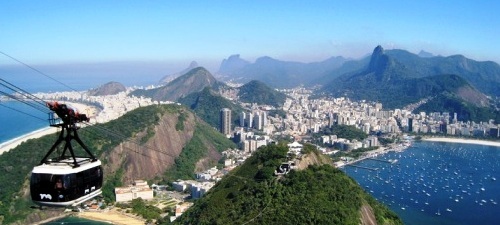
Sugarloaf Cable Car Ticket
Duration: 2 hours (approx.) Location: Rio de Janeiro, Brazil
With this tour, ride the cable car at Praia Vermelha station and enjoy the breathtaking views of the mountains, the Corcovado with Christ the Redeemer; Guanabara Bay...

The Best of Rio in a Full Day Tour
Duration: 8 hours (approx.) Location: Rio de Janeiro, Brazil
This is a full day tour of the city of Rio de Janeiro covering its most famous landmarks. Travel through Tijuca Forest with a professional guide. Head to the top of Corcovado, then ride a cable car to reach at Sugar Loaf Mountain...

Skip the Line Christ the Redeemer Admission Ticket
Christ the Redeemer (Corcovado) is Brazil's most iconic landmark and a trip to Rio is not complete without visiting it! Pre-purchase your skip the line admission ticket and jump on the next available train up to the statue.
Latest Events
Promote your events on riodejaneiro.com.

Untamed Rio: Discover Nature and Wildlife Adventures

Is Crypto Adoption High in Brazil?

Exploring Rio de Janeiro: A First-Time Visitor’s Adventure

From Beaches to Binge-Watching: Combining Rio de Janeiro’s Outdoor Adventures with the Best TV Shows of 2024
Recommended activities.

Sugar Loaf Mountain Half-Day Tour

Rocinha Favela Walking Tour

Rio de Janeiro Helicopter Tour

Experience Hang Gliding or Paragliding in Rio
Activities & tours, travel resources.
- Accommodation
- Rio de Janeiro Map
- Daily Posts
Sign up to our Newsletter

©Raphael Koerich/500px
Rio de Janeiro
Golden beaches and lush mountains, samba-fueled nightlife and spectacular football matches: welcome to the Cidade Maravilhosa (Marvelous City).
Best Time to Visit
Best things to do, attractions, must-see attractions.

Parque Nacional da Tijuca
The Tijuca is all that's left of the Atlantic rainforest that once surrounded Rio de Janeiro. This 39-sq-km tropical-jungle preserve is an exuberant green…

Pão de Açúcar
Seen from the peak of Pão de Açúcar, Rio is undoubtedly a Cidade Maravilhosa (Marvelous City). There are many good times to make the ascent, but sunset on…

Copacabana Beach
A magnificent confluence of land and sea, the long, scalloped beach of Copacabana extends for some 4km, with a flurry of activity along its length: over…

Maracanã Football Stadium
Rio’s Maracanã stadium is hallowed ground among football lovers. The massive arena has been the site of legendary victories and crushing defeats. Maracanã…

Museu de Arte do Rio
Looming large over Praça Mauá, the MAR is an icon for the rebirth of Rio's once derelict port. The huge museum hosts wide-ranging exhibitions that focus…

Museu Histórico Nacional
Housed in the colonial arsenal, which dates from 1764, the impressive Museu Histórico Nacional contains relics relating to the history of Brazil from its…

Boulevard Olímpico
Rio's formerly derelict port district has been reborn as a wide promenade lined with massive street art. A handful of renowned artists have painted…

Sítio Burle Marx
This 35-hectare estate was once the home of Brazil's most famous landscape architect, Roberto Burle Marx. The estate's lush vegetation includes thousands…
Planning Tools
Expert guidance to help you plan your trip.
Things to Know
Leave your worries at home and embrace the Carioca way of living with these top tips from a local.
Best Neighborhoods
Rio de Janeiro is a thriving, multicultural city and this is especially evident in its distinct and unique neighborhoods. Here's our picks of the best.
See the wilderness-backed beaches, ancient sites and smaller-scale cities of Rio de Janeiro state on these top day trips from Rio de Janeiro.
Money and Costs
Rio may not be the most budget friendly destination in South America, but these tips will help you make your reais go farther in the Marvelous City.
Transportation
As the second largest city in Brazil, Rio's size can be intimidating to visitors. Here's everything you need to know about getting around Rio de Janeiro.
Free Things to Do
From world-famous beaches and generous green spaces to cultural centers and museums, there's plenty to do in Rio without spending a single centavo.
Traveling with Kids
Brazil is home to a family-centric culture, and Rio de Janeiro is no exception – here's our guide to help you plan a great trip to Rio with kids.
Plan with a local
Experience the real Brazil
Let a local expert craft your dream trip.

Latest stories from Rio de Janeiro

Festivals & Events
Jan 16, 2024 • 7 min read
The world’s largest street party changed my life. As I visit for a third time, here is everything you need to know to make sense of Carnaval 2024.

Dec 2, 2023 • 8 min read

Nov 13, 2023 • 6 min read

Nov 12, 2023 • 5 min read

Nov 10, 2023 • 5 min read

Nov 10, 2023 • 4 min read

Nov 8, 2023 • 4 min read

Oct 6, 2023 • 4 min read

Oct 2, 2023 • 5 min read

Sep 30, 2023 • 5 min read
in partnership with getyourguide
Book popular activities in Rio de Janeiro
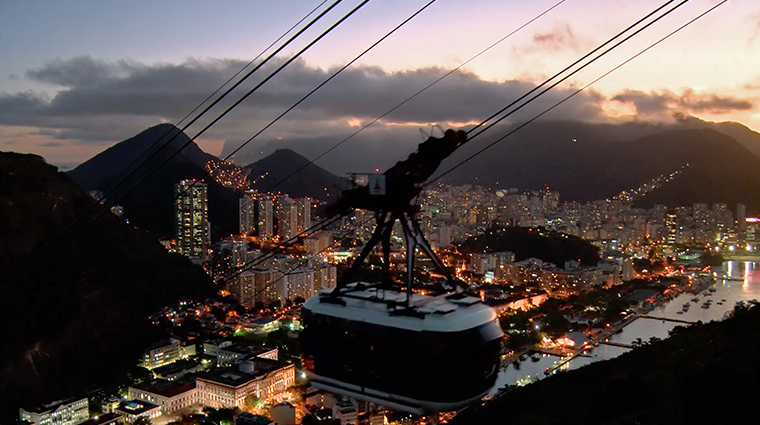
- Food and Wine
- Travel Tips
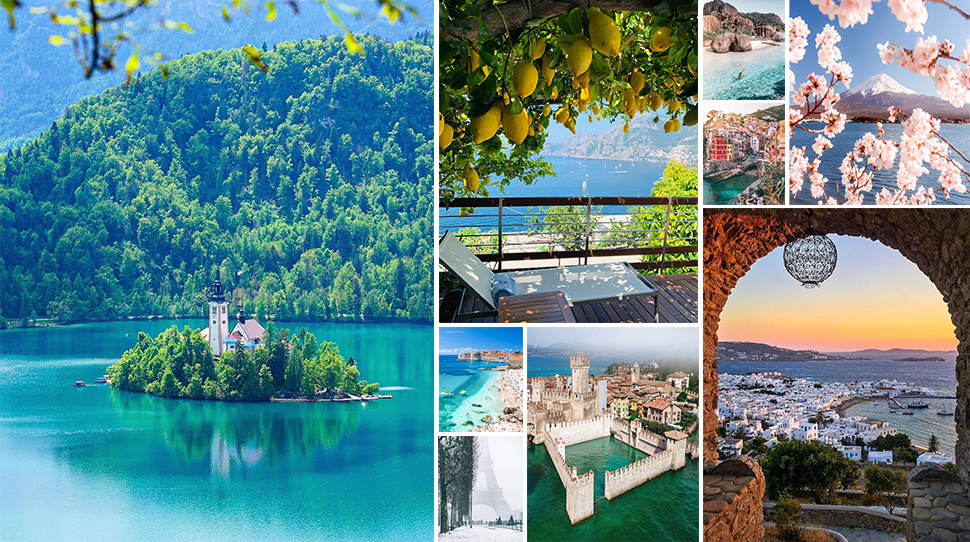
Dreaming of your next trip?
I agree to the Forbes Travel Guide Privacy Policy , Terms , and Cookie Policy . I understand I can withdraw my consent at any time.
Sign up for our newsletter

- All Lodging
- Hotels Motels and B&Bs
- Cabins & Lodges
- Camping & RV Parks
- Vacation Rentals
- All Dining Options
- South Fork Dining
- Del Norte Dining
- Monte Vista Dining
- Breweries Taphouses & Distilleries
- Equipment & Rentals
- Fly Fishing
- Rio Grande River
- Guides & Tours
- Fish The Upper Rio
- Golf Courses
- Mountain Biking & Hiking
- Rio Grande NF Trails
- Rock Climbing
- Equipment Rentals
- Guides/Tours
- ATV/UTV/Motorcycle Trails
- Festivals & Events
- Weddings & Events
- Bring Your Event Here!
- Event Submission Form
- Summitville Historic Mine District
- Bachelor Loop Mine Tour
- The Six Journey Tours
- Old Spanish Trail
- Cumbres & Toltec Scenic Railroad
- Monte Vista National Wildlife Refuge
- Great Sand Dunes Nat’l Park
- Creede Repertory Theatre
- Area Attractions
- Historic Mining Camp Driving Tours
- Fall Foliage Car Tours
- The Cradle of Colorado – Six Heritage Journeys
- Wheeler Geologic Area

Stay Here! …. Visit & Play Everywhere!
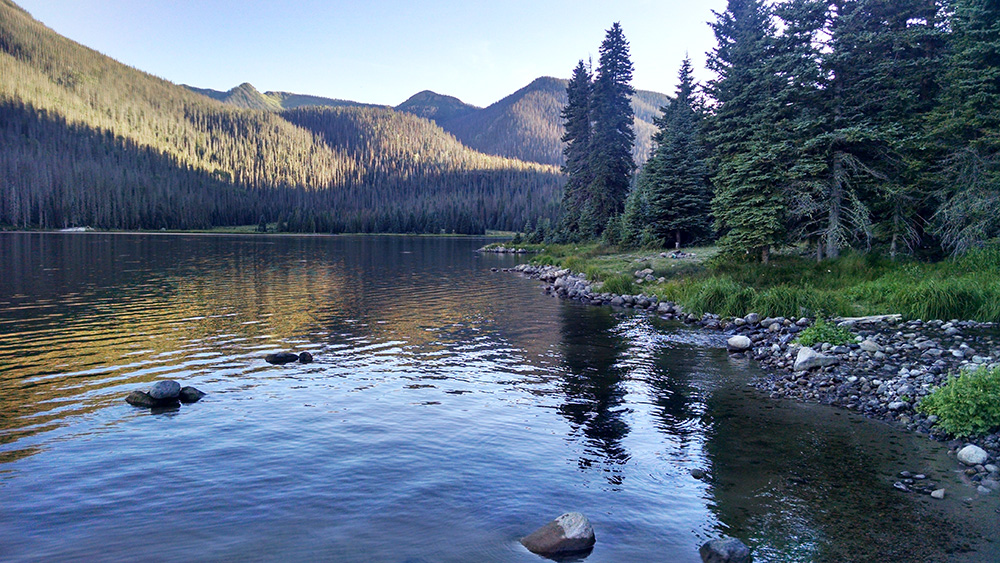
Rio Grande County
Just Imagine… your days in Rio Grande County enjoying Colorado’s bluebird sky sunshine, where you can spend the morning taking photographs of waterfowl at the Monte Vista Wildlife Refuge, visit Alligators at Colorado Gator Farm. experience the heart pounding thrill Mountain Biking and Hiking the trail systems like Del Norte Trails , Penitente Canyon , Rock Canyon and Stone Quarry just to name a few. You Aren’t done yet….Some of the best trout Fly Fishing in the world can be found here on the gold medal waters stretch of the Rio Grande River. Not to be outclassed by the many Rock Climbing routes available, a plethora of Lakes to paddleboard, kayak and fish, plus hundreds of miles of ATV/ UTV roads & trails to play on. Last but not least, include two centuries of mining & logging history with a visit to Rio Grande County Museum & the historic driving tour to Summitville Mining Camp & more. Make Rio Grande County your perfect base camp for your summer fun! It’s a GRANDE place to VISIT!
– Hiking, Fishing & Skiing – Learn More
– Biking & Hiking – Learn More
Monte Vista
– Sandhill Cranes – Learn More
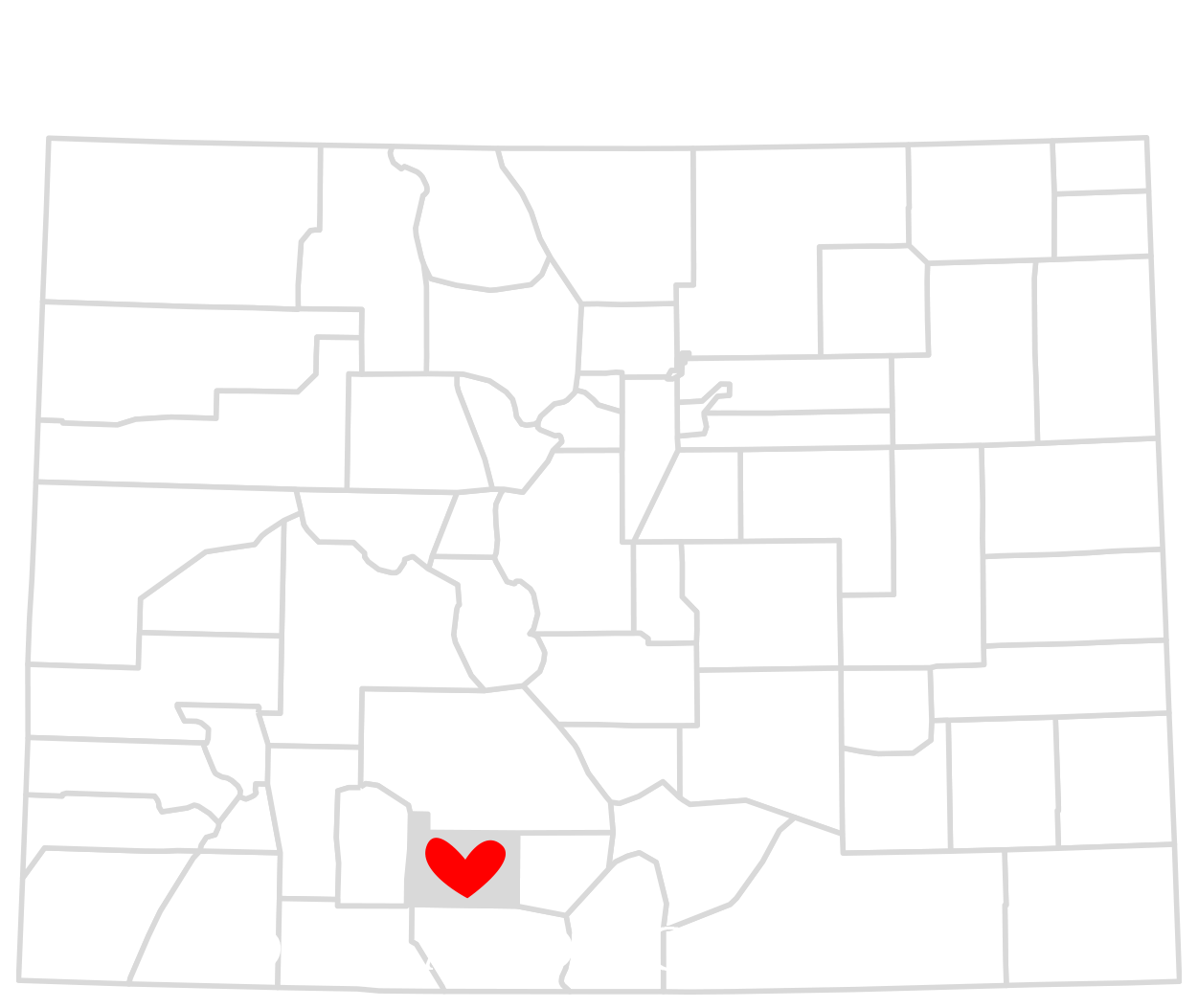
Outdoor Paradise

Places to Dine

Where to Stay

Scenic Drives
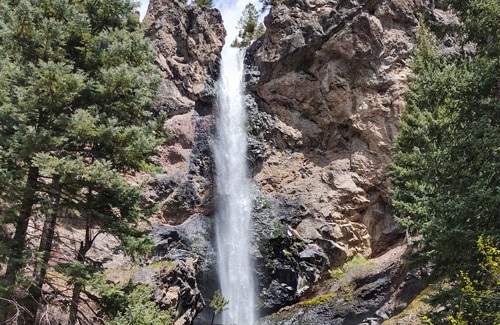
Rich History
Share Your Adventure at #VISITRIOGRANDECOUNTY
It’s a GRANDE Place to VISIT!

Practical Rio
Learn how to enjoy rio like a carioca.
Rio de Janeiro is a 10-million inhabited metropolis by the sea. To help you out with some practical aspects of the daily life in the marvelous city, RIO.com has put at your fingertips a bunch of tips and useful information you might want to read before exploring the city.
Rio Beaches
The beaches of Rio you are most likely to explore during your visit to Rio are Leme , a quieter and more visited by families, Copacabana , mostly frequented by tourists, Ipanema , Leblon and Barra . The most popular beaches are Copacabana and Ipanema, but there are other beaches you should consider such as Recreio and Praia da Reserva . Learn about them all on our Rio Beaches Guide.
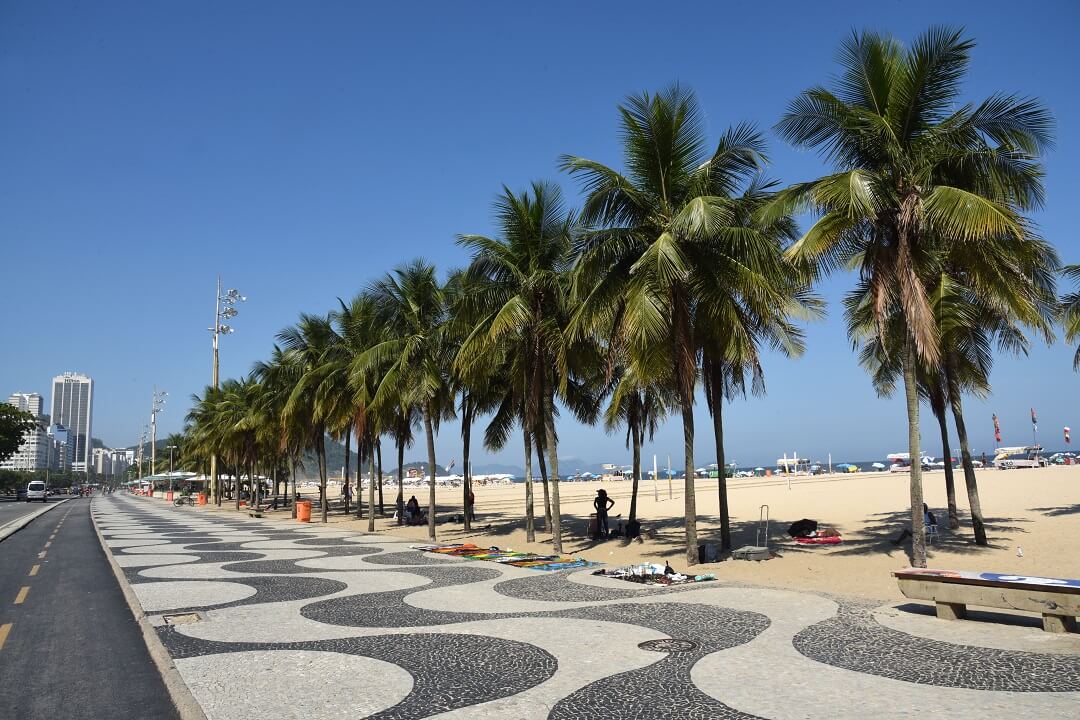
Neighborhoods of Rio
The parts of Rio you will probably visit stretch along the Baia de Guanabara and Atlantic Ocean. Lapa , Flamengo , Santa Teresa , Downtown , Urca , Copacabana , Ipanema and Leblon are some of the neighborhood set in this area. Read our Rio Neighborhoods section, learn about the most important neighborhoods, and do optimize your time, so you can get more of the best Rio has to offer.
While in Rio
Given Rio’s gifted landscape, with mountains, beaches, the lake and forests, cariocas and visitors are an active bunch. Ruled by the sun, Rio de Janeiro offers much more than the beaches, the Sugar Loaf and the Statue of the Christ . Jogging, hiking, cycling and other active sports can all be a big part of your time. But you can also learn how to strike the Brazilian rhythms with dancing classes, master the culinary with a Brazilian chef or even be initiated with the famous Capoeira or Surfing.
Buy HERE your Carnival Tickets Package
It's Carnival Time
Enjoy specials deals for Rio Carnival 2025
Copacabana Palace Magic Ball
BUY Your Rio Carnival Tickets 2025
How to Book Your Tickets Safely Online
Have Questions? Our experts are here to help you!
Rio de Janeiro

- 1 Districts
- 2.1 History
- 2.2 Climate
- 2.3 Visitor information
- 3.1.1 Public transport from the airports of Rio
- 3.1.2 Taxis
- 3.1.3 Money
- 3.1.4 Destinations
- 3.2 By train
- 3.4 By boat
- 4.1 By boat
- 4.2 By light rails/tram
- 4.3 By cable car
- 4.5 By Bus Rapid Transit (BRT)
- 4.6 By subway
- 4.7 By SuperVia suburban trains
- 4.8 By taxi
- 4.9 By e-hailing
- 4.10 By car
- 4.11 By bicycle
- 5.1 Beaches
- 5.3 Buildings
- 5.4 Museums
- 6.1 Carnaval
- 6.3 New Year's Eve celebrations
- 6.4 Gay Travel
- 6.5 Hang gliding and paragliding
- 6.6 Hiking and Trekking
- 6.7 Panoramic flights
- 6.8 Favela (Shantytown) tours
- 6.9 Out of town trips
- 10.3 Samba clubs
- 10.4 Clubbing
- 12 Stay healthy
- 13 Stay safe
- 14.1 Consulates General
- 15.1 Grande Rio
- 15.2 On the southeastern coast of Rio State
- 15.3 In the northwest
- 15.4 In the north
- 15.5 In the west
<a href=\"https://tools.wmflabs.org/wikivoyage/w/poi2gpx.php?print=gpx&lang=en&name=Rio_de_Janeiro\" title=\"Download GPX file for this article\" data-parsoid=\"{}\"><img alt=\"Download GPX file for this article\" resource=\"./File:GPX_Document_rev3-20x20.png\" src=\"//upload.wikimedia.org/wikipedia/commons/f/f7/GPX_Document_rev3-20x20.png\" decoding=\"async\" data-file-width=\"20\" data-file-height=\"20\" data-file-type=\"bitmap\" height=\"20\" width=\"20\" class=\"mw-file-element\" data-parsoid='{\"a\":{\"resource\":\"./File:GPX_Document_rev3-20x20.png\",\"height\":\"20\",\"width\":\"20\"},\"sa\":{\"resource\":\"File:GPX Document rev3-20x20.png\"}}'/></a></span>"}'/>
Rio de Janeiro is the second largest city in Brazil , on the South Atlantic coast. Rio is famous for its breathtaking landscape, its laid-back beach culture and its annual carnival. The "Carioca Landscapes between the Mountain and the Sea" has been inscribed on the UNESCO World Heritage list .
The harbour of Rio de Janeiro is comprised of a unique entry from the ocean that makes it appear as the mouth of a river. Additionally, the harbor is surrounded by spectacular geographic features including Sugarloaf mountain at 395 meters (1,296 feet), Corcovado Peak at 704 meters (2,310 feet), and the hills of Tijuca at 1,021 meters (3,350 feet). These features work together to collectively make the harbor one of the Seven Natural Wonders of the World .
Rio de Janeiro hosted many of the 2014 FIFA World Cup games, including the final. It also hosted the 2016 Summer Olympics and Paralympics, becoming the first South American city to host the Summer Olympics.

It is a common mistake to think of Rio as Brazil 's capital, a distinction it lost on April 21, 1960 when Brasilia became the capital. Beaches such as Copacabana and Ipanema , the Christ The Redeemer ( Cristo Redentor ) statue, the stadium of Maracanã and Sugarloaf Mountain ( Pão de Açúcar ) are all well-known sights of what the inhabitants call the "marvelous city" ( cidade maravilhosa ), and are also among the first images to pop up in travelers´ minds, along with the Carnaval celebration.
The South Zone holds most of Rio's landmarks and world-famous beaches, in an area of only 43.87 square kilometres (16.94 sq mi) . Many of them are within walking distance of each other (for instance, the Sugarloaf lies about 8 km (5.0 mi) from Copacabana beach). Most hotels and hostels are located in this part of the city, which is compressed between the Tijuca Range ( Maciço da Tijuca ) and the sea. There are important places in other regions as well, such as Maracanã stadium in the North Zone and the many fascinating buildings in the centre.
Sadly, most people also know Rio for its violence and crime, especially related to drugs. And social problems, as slums or favelas , areas of poor-quality housing and living; these slums are usually located on the city's many mountain slopes, juxtaposed with middle-class neighbourhoods.

Rio was founded in 1565 by the Portuguese as a fortification against French privateers who trafficked wood and goods from Brazil. Piracy played a major role in the city's history, and there are still colonial fortresses to be visited (check below). The Portuguese fought the French for nearly 10 years, both sides having rival native tribes as allies. For the next two centuries it was an unimportant outpost of the Portuguese Empire, until gold, diamonds, and ore were found in Minas Gerais in 1720. Then, as the nearest port, Rio became the port for these minerals and replaced Salvador as the main city in the colony in 1763. When Napoleon invaded Portugal, the Royal Family moved to Brazil and made Rio capital of the Kingdom (so it was the only city outside Europe to be capital of a European country). When Brazil became independent in 1822, it adopted Monarchy as its form of government (with Emperors Pedro I and Pedro II). Many historians and Brazilians from other places say cariocas are nostalgic of the Royal and Imperial times, which is reflected in many place names and shop names. In 2009, the city won their bid to host the games of the XXXI Olympics in the summer of 2016. This was the fifth bid by the city, whose 1936, 1940, 2004, and 2012 bids lost.
The climate of the city of Rio de Janeiro is tropical with a hot, humid and sometimes rainy summer and a mild and dry winter. In December and January, the heat and humidity are usually constant, reaching up to 45°C (113°F), However, it rains less in Rio de Janeiro than in other cities in the Southeast (for example, São Paulo) and the rains are usually sudden and rapid, giving a welcoming relief from the sizzling afternoon temperatures. During winter in the southern hemisphere, temperatures in Rio are usually milder. In these months rainfall decreases, and average temperatures are typically 19°C (66°F) to maximums of 25°C (77°F).
Visitor information
- Riotur website
Rio is one of the country's major transportation hubs, second only to São Paulo.
Metropolitan area airport code for the two airports of the city is unsurprisingly RIO IATA .
If the flight connections to Rio don't suit you, you can check flights to the airports of São Paulo , Belo Horizonte , Campinas or Vitoria . From there you can take an intercity bus to Rio.
Public transport from the airports of Rio
From Galeão (GIG) two bus lines operated by Real [ dead link ] depart from right outside the arrival section. Buses are air-conditioned and comfy, with ample luggage space. They run roughly every 30 minutes from 5:30AM to 10PM.
- Bus line 2018 Aeroporto Internacional do RJ/Alvorada (Via Orla da Zona Sul) runs between both airports, the main bus terminal and further along the beachfront of Botafogo , Copacabana , Ipanema and Leblon , and has its terminus at the Alvorada terminal near Barra Shopping in Barra da Tijuca . The full run takes at least 60 minutes, often double that. Tickets are R$16 (Dec 2016).
- Bus line 2918 Aeroporto Internacional do RJ/Alvorada (Via Linha Amarela) runs to the Alvorada bus terminal, via Jacarapaguá (the best spot for taxis) from Galeão airport along the Linha Amarela in as little as 35 minutes, traffic allowing.
For a slightly cheaper option, go ahead as follows. From the airport , take BRT (Bus Rapid Transport System) (R$3.60, RioCard (R$3) needed, but can be used on Metro as well) to Vicente de Carvalho and transfer to the metro. The BRT does not go into the center, but north around Rio towards Alvorada Bus Terminal and Terminal Jardim Oceãnico. From Alvorada they connect to other BRT to Santa Cruz and Campo Grande west. The BRT also connects to the commuter rail system in Madureira. If you head to the airport , you need to take BRT bus #30 semi direto to Galeão , from Vicente de Carvalho . The bus goes every 30 min or so, from the middle doors of the 100 m long bus stop. Allow 1.5 hr for the trip between center and airport, especially if you do it the first time. Connect to Vicente de Carvalho using metro line 2 (R$4.30). Between metro and BRT at Vicente de Carvalho , walk the white footpath. At the airport, you get off at Terminal 2, when all people get off.
There are two types of taxis . As you leave Customs you will see booths of different companies offering their services. These are considerably more expensive than the standard yellow taxis that are to be found outside the terminal building but the quality of the cars is generally better and the price is pre-set and final and you pay at the booth before going to the car with no need to pay (or tip) the driver. These taxis can often charge double the price of those ordinary taxis from the rank around 100 metres from the arrivals exit. It is possible to reserve airport transfers. Standard yellow taxis are cheaper but usually run on meters meaning that, due to high traffic, you may end up paying more than originally expected. Also, although very rare nowadays, you will need to keep the eye on the road (maybe following your route on Google Maps or similar) to ensure that the driver does not make a (long) diversion running up a high fare at the end. Many will also want payment in cash rather than card.
Money change facilities are limited and high commissions are charged. Slightly better rates can be obtained, illegally, at the taxi booths but they may want you to use their cabs before changing money for you. In any event, don't change more than you have to as much better rates are available downtown. However, if you have a VISA or Mastercard Debit Card, you may use the Airport's ATMs (Banco 24 Horas) which will allow you to withdraw cash for a fee. IN this case, do not accept the suggest exchange rate but ask for it to be debited in Reals in your account since your bank will almost certainly havea better rate to offer.
Destinations
From Europe, LATAM Airlines offers direct flights from Paris (daily), London and Frankfurt (both three times a week). Air France flies twice a day from Paris, British Airways three times a week from London, TAP twice a day from Lisbon and on Fridays and Sundays to Porto , Lufthansa four days a week from Frankfurt, KLM four days a week from Amsterdam and Iberia daily from Madrid . From Africa, Taag connects Rio to Luanda four times a week, and from Asia, Emirates has a daily non-stop flight to Dubai , where is possible to continue to many Asian destinations (also, from Rio this flight continues to Buenos Aires ).
From North America, there are non-stop flights to Rio de Janeiro from Charlotte , New York City and Miami with either American Airlines or LATAM Airlines, Washington, D.C. and Houston with United Airlines, Dallas with American Airlines, and Atlanta with Delta Air Lines. Travellers from elsewhere in the region have to make a stop in the aforementioned U.S. cities or in São Paulo to get to Rio.
Gol, LATAM , Emirates, Aerolíneas Argentinas and other carriers connect Rio de Janeiro to Argentina ( Buenos Aires and Cordoba ), Venezuela ( Caracas ), Paraguay ( Asuncion ), Uruguay ( Montevideo ) and Chile ( Santiago ). Avianca and Copa Airlines connect Rio with Bogotá , Lima and Panama City , respectively, offering onward connections to Central America or other South American cities. LATAM and Aerolineas Argentinas offer connections from their respective hubs to Australia and New Zealand .

- -22.9021 -43.556 5 Rodoviário de Campo Grande Bus station ( Terminal Rodoviário de Campo Grande ), Rua Aurélio de Figueiredo, Campo Grande, Zone Norte ( BRT TransOeste terminated here. ). Buses to/from Duque de Caxias, Nova Iguaçu, Itaguaí, Mangaratiba, Niterói and São Gonçalo cities.
Several companies offer bus passes from Rio to the rest of the country. The Green Toad Bus also offer bus tickets online for buses from Rio de Janeiro to Ilha Grande , Paraty , São Paulo , Florianopolis , Campo Grande , Foz do Iguacu and some other destinations in Brazil. They have bus passes to take you to other countries as well.

Ferries ( barcas ) connect neighbouring Niterói to Rio de Janeiro and arrive at Praça XV (see down), in the city centre.
Rio is connected by many roads to neighboring cities and states, but access can be confusing as there are insufficient traffic signs or indications of how to get downtown.
The main interstate highways passing through Rio are:
- BR-116 , which connects the city to the southern region of Brazil. Also known as Rodovia Presidente Dutra
- BR-101 , which leads to the north, northwest plus Costa Verde (Green Coast - Paraty, Mangaratiba, Angra dos Reis) and São Paulo Coast (Ubatuba, Caraguatatuba, Bertioga, Santos) and beyond towards the South of Brazil , and
- BR-040 , which will take you in the central and western areas.
Rio de Janeiro possesses an extensive and complex, highly multi-modal public transportation system, adapted to the city's unique topography - large areas covered by mountains surrounded by pockets of densely populated flat lands. Among the public transportation modes, there is subway, heavy rail, light rail, bus rapid transit, local buses, microbuses, cable cars and ferry boats.
The city uses a prepaid transport SmartCard, the RioCard Bilhete Único Carioca , which costs R$3.00 (refundable) and gives access to nearly all available public transportation (mostly excluding tourist rides), also offering discounts if the user takes more than one transportation within a 2-hr time period and stays within the Rio de Janeiro municipality. Cards can be returned with getting the money on it back. This can be a good way to get cash off credit cards that have a minimum cash withdrawal of like €50, but in case you only need another R$40 before leaving the country.
Unfortunately, the RioCard cannot be returned at the airport.
It is very convenient to get a Bilhete Único if you plan to use public transport on a regular basis during your stay in Rio, as it saves you the hassle of constantly figuring out which type of integration ticket to buy. If you stick to subway, heavy rail, bus rapid transit and local buses (not including executive buses), a public transport trip using the Bilhete Único shall cost between US$1-2.
By light rails/tram
- Santa Teresa Tram, Centro
- Corcovado Rack Railway, Zona Sul
- The VLT ("Veículo Leve sobre Trilhos", Portuguese for "light rail vehicle") connects Rodoviária Novo Rio, Santos Dumont Airport, Praça XV ferry station, Central do Brasil train station, and a couple of subway stations. Can only be paid with a Bilhete Único card (R$ 3,80; each person must have a separate card), which can be bought in any stop but not within the vehicle. The ticket must be validated immediately after entering the vehicle, otherwise a R$ 170 fine will be levied.
By cable car
- Sugarloaf Cable Car ( Zona Sul )
Buses are still the cheapest and most convenient way to get around the South Zone (Zona Sul) of the city due to the high number and frequency of lines running through the area. For the adventurous or budget traveller, it is worth asking your hotel or hostel employees how to navigate the system or which routes to take to arrive at specific locations. However, you should be mindful of questionable characters and your belongings. By night buses are more scarce, and most lines will usually not be running by the time the bars and clubs are full. Buses start at R$4.05 (May 2020); buses with air conditioning charge higher fares. The fare is paid in cash to a controller or the driver inside the bus, by passing through a roulette. There are no tickets, and try to have change/small bills. Some residents and students have a digital pass card. Keep an eye out for pickpockets when the bus is crowded, and don't be surprised if your driver goes a little faster and brakes a little more suddenly than you'd like. Except for minibuses, buses now have two doors: passengers get in through the front door and get off through the back (it was otherwise until 2001-2002).
Some bus stops in the South Zone are equipped with a shelter and a bench, but sometimes, far from tourist areas, they are less obvious and have no signs at all - you might have to ask. As a general rule in most parts of Brazil, buses stop only when you hail them, by extending the arm. If you don't hail and there are no passengers waiting to get off, the bus simply won't stop. The same can be said if you are on the bus wanting to get off at a particular stop. You should know the surroundings or the name of the intersection of the area you are going, or inquire to the employee operating the roulette, so you can signal to the driver that you want to get off, or he may not stop! There are no schedules nor timetables, but there is an invaluable book called Ruas de Rio de Janeiro (The streets of Rio de Janeiro) that has maps of Rio and lists bus routes by bus line. Although it does not list the exact schedule of arrivals and departures, it lists the bus stops, and one an easily orient oneself and navigate the city using it. Usually, buses run no less infrequently than every 15 minutes. However, they can run just once an hour or more infrequently late at night or in remote areas of town.
There are a baffling 1000+ bus lines in Rio (including variants), covering nearly all of the city, operated by perhaps a dozen independent operations. (At least 6 operations ply the streets of Copacabana and Ipanema.) The website contains a catalog of the lines and offers the option to plan a bus trip, but little help when offline, a great alternative is the site, The site Bus Schedule , for offering a catalog with several constantly updated lines. Many lines differ only a few streets from each other in their itineraries, and some even have variants within the same line. Bus lines with a * or a letter mean that this bus has a variant. It means that there may be a bus with the same name, same number, same origin, even the same destination but with a completely different route. Lines are numbered according to the general route they serve:
- beginning with 1 - South Zone/Downtown
- beginning with 2 - North Zone/Downtown
- beginning with 3 - West Zone/Downtown
- beginning with 4 - North Zone/South Zone
- beginning with 5 - within South Zone
- beginning with 6 - North Zone/West Zone
- beginning with 7 and 9 - within North Zone
- beginning with 8 - within West Zone
Most popular lines for tourists are 583 and 584 (from Copacabana and Ipanema to Corcovado railway station), as well as 464 and 435 (from Copacabana to Maracanã). Buses 511 (Ataulfo de Paiva) and 512 (Bartholomeu Mitre) are also popular as they take you to Urca for the station to take the cable car up the Sugarloaf mountain. Typically bus drivers and controllers won't understand any foreign language. If you can't speak Portuguese at all, use a map. Trying to speak Spanish is usually not particularly useful.
By Bus Rapid Transit (BRT)
The BRT is a mass rapid transit system based on multiple-car buses running on exclusive lanes, inspired by similar systems in Curitiba , Bogota and Jakarta . There are three BRT lines:
- TransCarioca: links the Galeão - Antônio Carlos Jobim International Airport to the Barra da Tijuca neighbourhood, also connecting with the Line 2 (Green) subway line that gives access to Zona Sul and the Centro . Useful for visitors who want to go from the Galeão airport to the touristic neighbourhoods (Barra and the beaches of Zona Sul) and are on a tight budget;
- TransOeste: links the future Jardim Oceânico subway station (which shall be operating before the 2016 Olympics) to the extreme northwest of the municipality ( Santa Cruz and Campo Grande neighbourhoods ). Useful for visitors staying in Barra da Tijuca to move around in the area or to go to the Zona Sul or the Centro by connecting to the subway;
- TransOlímpico: inaugurated during the 2016 Summer Olympics, it connects the Deodoro neighbourhood in Zona Norte to Barra da Tijuca , passing through several Olympic facilities. Basically useful to visitors to the Olympic events.

The Metrô Rio subway system is very useful for travel from Jardim Oceânico (in Barra da Tijuca ) to Downtown and beyond, passing through the Zona Sul beaches including Leblon, Ipanema and Copacabana (the extension to Leblon and Barra da Tijuca shall be inaugurated before the 2016 Summer Olympics). It closes after midnight (24 hours during Carnaval). The air-conditioned subway is safe, clean, comfortable, and quick, and has much better signage than most transport in Rio, making the lives of foreign tourists easier. There are two main lines: Line 1 has service to Ipanema (General Osorio), the Saara district, and much of Downtown, as well as Tijuca. Line 2 stops at the zoo, Maracanã stadium, and Rio State University. The two lines are integrated between Central and Botafogo, so check the train's destination if you board within the integrated section for a destination in the Zona Norte. A one-way subway-only "unitário" ticket is R$4.60 (May 2020). The ticket window will give you a card that you insert in the turnstile; do not pull it out unless you've purchased a multi-trip or transfer pass. Rechargeable IC cards (minimum charge R$5, no deposit required) are also available and definitely worth getting if you'll be in town for a few days.
The Metrô company operates bus lines from some stations to nearby neighborhoods which are not served by the subway system. This is particularly helpful for places uphill such as Gávea, Laranjeiras, Grajaú and Usina. Since the city grew around the Tijuca Range mountains, these neighborhoods will never be served by the subway, but you now can take the integração (connection) minibuses. The company calls it Metrônibus and Metrô na Superfície (literally, Subway on Ground ), but actually they are ordinary buses in special routes for subway commuters. You can buy tickets for these - just ask for expresso (pronounced "eysh-PREH-sso", not "express-o") when buying a ticket, then keep it after crossing the roulette (prices range from R$ 2.80 to 4.40, depending on the transfer you want, as of Sep 2010). When you leave the subway, give the ticket to the bus driver (who shall be waiting in the bus stop just outside of the station). If you buy an ordinary ticket, you won't be able to get this bus for free - then it will cost a regular fee.
The last car of each train is marked for women-only with a pink window sticker, in order to avoid potential harassment in crowded trains. Some men, however, are not yet used to this separation, and many women, who are accustomed to hassle-free everyday travel in Rio's subway, also think the measure is unnecessary. Anyway, if you're a man, avoid getting into trouble with local security staff and stay off the pink-marked cars. The women-only policy for the wagon is valid only in the rush hour.
By SuperVia suburban trains
Eight lines operating. Five of them from Central station (see above). They can be useful exploring the northern and western suburbs and bairros (quarters).

Simply use Uber or the 99Taxi app.
In the areas without subway, trams, SuperVia or BRT (Bus Rapid Transit) use a cab. All legal cabs are yellow with a blue stripe painted on the sides. Taxis not designed like this are special service cars (to the airport or bus stations) or illegal. Rio taxis are not too expensive on a kilometre basis, but distances can be quite considerable. A journey from Zona Sul to the Centro will cost around R$20, and from the airport to Copacabana is around R$50 for example. The car can usually hold four people. You can ask a cab for a city tour, and arrange a fixed price (may be around US$20). Major taxi companies include Central de Taxi, Ouro Taxi and Yellow Taxi.
After getting into the taxi, check to see if the taximeter has been started, it charges R$5.50 (July 2018) for the minimum ride, called bandeirada ), and R$2.50 per kilometer. If not, ask the taxi driver to do so. Some taxi drivers may wish to negotiate a fixed price in lieu of using the taximeter stating that they want to help you out and give you a cheaper fare. This is common for taxi drivers queued at tourist stops such as Pão de Açúcar and may be a confidence trick. Keep in mind that the taximeter may give you a better price. When in doubt, use the taximeter. You are the customer and you are in control. If the taxi driver will not comply, leave the taxi and find another.
You may be ripped off by some taxi drivers. If you have any doubt about drivers being completely honest, consider having your route mapped out on your smart phone with Google Maps and GPS turned on and ready to go before entering the taxi. By doing so, you can see if your taxi driver closely follows this ideal route. Remember that Avenida Atlântica switches traffic directions during the day, so Google Maps might get it wrong during the morning or evening hours on that road.
If you want to avoid being ripped off then it may be worth taking a 'radio-taxi', particularly when arriving at the airport. Radio Taxis are usually the blue, green, or white taxis and they do cost a little more than the typical yellow taxi. The advantage of a radio taxi is that you pay a fixed rate regardless of the time of day or if there's heavy traffic etc., this means that you do not risk the price increasing at the drivers discretion. To book in advance you can contact Cootramo Radio Taxi via their website <span typeof=\"mw:Entity\" data-parsoid='{\"src\":\"&#91;\",\"srcContent\":\"[\"}'>[</span>dead link<span typeof=\"mw:Entity\" data-parsoid='{\"src\":\"&#93;\",\"srcContent\":\"]\"}'>]</span></sup><link rel=\"mw:PageProp/Category\" href=\"./Category:Articles_with_dead_external_links\" about=\"#mwt70\" data-parsoid='{\"stx\":\"simple\",\"a\":{\"href\":\"./Category:Articles_with_dead_external_links\"},\"sa\":{\"href\":\"Category:Articles with dead external links\"}}'/>"}]]}'>https://www.cootramo.com.br/%5Bdead+link%5D , or Rio Airport Transfer (English Speaking) via their website http://www.rioairporttransfer.com/
For those traveling to Rio for Carnaval it's worth using a company that allows you to book and pay in advance, and to try and pay as much in advance as possible as prices tend to increase a few weeks before Carnaval.
Be aware that traffic jams in Rio can be terrible at times. A taxi ride from Ipanema to the bus terminal for instance can take an hour and a half if you get seriously stuck, so make sure you have margins in case you really can't afford to be late.
By e-hailing
Rio de Janeiro is covered by some e-hailing services, Uber being the largest of them. Notable e-hailing services in the city, are:
- T81 (Brazilian service)
- Easy (Brazilian service)
- TeLevo (Brazilian service)
Traffic within some parts of Rio can be daunting, but a car may be the best way to reach distant beaches like Grumari, and that can be an extra adventure. Avoid rush-hour traffic jams in neighborhoods such as Copacabana, Botafogo, Laranjeiras, and Tijuca, where moms line up their cars to pick up their children after school. Buy a map or use Waze or Google Maps (or similar), and have fun.
Rio has an interesting programme of traffic management. Between 7AM and 10AM on weekday mornings the traffic flow of one carriageway on the beachfront roads of Ipanema and Copacabana is reversed, i.e. all traffic on those roads flows in the same direction, towards the city. On Sundays the carriageway closest to the beach is closed to allow pedestrians, cyclists, skateboarders, skaters and others to exercise.
There are Itaú rental bicycle available in Rio: https://bikeitau.com.br (bookable by app).

- -22.83877 -43.25015 1 Ramos (in-bay) - inappropriate for bathing
- -22.9287 -43.171 2 Flamengo (in-bay) - inappropriate for bathing
- -22.9455 -43.1809 3 Botafogo (in-bay) - inappropriate for bathing
- -22.948 -43.16316 4 Urca (in-bay) - usually inappropriate for bathing
- -22.95544 -43.16471 5 Vermelha (in-bay) - sometimes inappropriate for bathing
- -22.9642 -43.1693 6 Leme (oceanic)
- -22.9707 -43.1818 7 Copacabana (oceanic)
- -22.9887 -43.1925 8 Arpoador (oceanic)
- -22.987 -43.213 9 Ipanema (oceanic)
- -22.988 -43.2247 10 Leblon (oceanic)
- -22.99901 -43.256 11 São Conrado (oceanic) - sometimes inappropriate for bathing
- -23.0111 -43.3603 12 Barra da Tijuca (oceanic)
- -23.0265 -43.46 13 Recreio dos Bandeirantes (oceanic)
- -23.0352 -43.493 14 Macumba (oceanic)
- -23.0409 -43.5055 15 Prainha (oceanic)
- -23.0481 -43.5203 16 Grumari (oceanic)
- -23.0481 -43.51286 17 Abricó (oceanic, nudist beach)
Abricó is the only official nudist beach in the city of Rio de Janeiro, it lies next to Grumari beach. Only accessible by car/taxi. A cheaper option is taking the bus numbered 360 (Recreio) that passes along Copacabana/Ipanema/Leblon, and from the end of the line (ponto final) take a cab.
It is also worth visiting the beaches in Paquetá , particularly:
- Praia da Moreninha (on the Guanabara Bay, but often not clean enough for swimming)
Cariocas have a unique beach culture , with a code of customs which outlanders (even Brazilians from other cities) can misconstrue easily. Women may wear tiny string bikinis, but that does not mean they are trying to attract a man. Until the 1990s, men and boys wore speedos , but since then wearing Bermuda shorts or boardshorts has become more common, although speedos ("sungas" in Portuguese) seem to now be making a comeback. Jammers are less common but still accepted.
Waves in Rio vary from tiny and calm in the Guanabara bay beaches (Paquetá, Ramos, Flamengo, Botafogo, Urca) to high, surf-ideal waves in Recreio. In Leme, Copacabana, Arpoador, Ipanema, and Leblon, there's a popular way of "riding" the waves called pegar jacaré (pe-GAHR zha-kah-REH; literally, "to grab an alligator"). You wait for the wave to come behind you then swim on top of it until it crumbles next to the sand.
Commerce is common in Rio's beaches, with thousands of walking vendors selling everything from sun glasses to fried shrimp to cooling beverages (try mate com limão , a local ice tea mixed with lemonade, or suco de laranja com cenoura , orange and carrot juice). For food, there is also empada (baked flour pastry filled with meat or cheese) and sanduíche natural (cool sandwich with vegetables and mayo). Vendors typically shout out loud what they're selling, but they won't usually bother you unless you call them. All along the beaches there are also permanent vendors who will sell you a beer and also rent you a beach chair and an umbrella for a few Reais.
Leblon and Ipanema are the most cool beaches. The beaches in Barra and Recreio (Quebra-Mar, Pepê, Pontal, Prainha, Grumari) are the best and cleanest beaches, being the favorite among surfers, paragliders and nautical sports. São Conrado beach is a hang gliders paradise.
In the West Zone you can find some of the best beaches of Rio de Janeiro. Barra da Tijuca's beach is a 17 km (11 mi) sand line of clear waters. Surfers love it, and many people also. The sunset is beautiful, especially during the winter. The beach is relatively safe at night, although development of tourism by big hotels such as the Sheraton have brought with it the inevitable appearance of (discreet but ever present) prostitutes. As you go along you get to Recreio, which is even clearer, and much less crowded. Prainha is now very far away from the crowded Copacabana. Its perfect waves made it famous. It is also on a biological reserve, with restricted car parking spaces. Avoid the weekends and enjoy this between mountains-beauty of the nature on the week-days. There are many surfing schools all along the Barra beach that hold one and half hour surfing classes. The classes are fairly inexpensive and are mostly populated with locals. Some of the surf instructors do speak English.

Corcovado , the 710 m (2,330 ft) granite peak located in the Tijuca Forest in central Rio is known worldwide for the Cristo Redentor (Christ the Redeemer) statue . The funicular train up costs R$62 (low season) or R$75 (high season) for a round trip up to Cristo Redentor, and it is definitely worth the view. The queue for the train, in Cosme Velho, can get rather long; you purchase a ticket for a particular departure time (that day only). The box office at the station does not sell same-day tickets. The trains run every 30 minutes. Try going when the morning coach parties have already passed through, i.e. when most tourists are having their lunch. Don't take the train too late in the day since late afternoon trains may be canceled if delays throughout the day build up. This is common over holiday weekends. Take a taxi to Cosme Velho, or take the Metro-Onibus Expresso combination (see above) from the Largo do Machado station. After dark, be aware that the steep descent down Corcovado in a shuttle can be dangerous since some less-professional park drivers choose to speed down the mountain to create a roller-coaster type effect and even turn the headlights off temporarily to thrill the passengers. If this occurs, passengers should tell the driver to stop by shouting "Pare!" (PAH-ree). Report any such conduct to a police officer at the base of the park before you descend to the base of the mountain by taxi. There's also a hiking trail that begins at Parque Lage and gets there (see Hiking and Trekking on the 'Do' section below).
Pão de Açúcar, the Sugarloaf Mountain (one taller, the other shorter), Brazil's top landmark, with a two-stage aerial tramway to the top; a definite must-see. There is also an unsigned trail leading to the second station. Ask locals for directions. The buses number 511, 512, 591 and 592 and the subway buses from Botafogo bring you to the base station. Do not make the mistake of thinking you have seen enough once you have seen the view from Cristo Redentor. Try Sugarloaf at sunset for a truly mind-blowing experience.
Lagoa Rodrigo de Freitas is a large lagoon in the middle of South Zone, with great views to Corcovado and Ipanema and Leblon beaches; you can jog or cycle all the way round; there are skating areas and you can hire little pedal-operated boats.
Maracanã the largest football stadium in South America and once the largest on Earth. It is in a state of disrepair following the Summer 2016 Olympics, and daily tours have been suspended. There is also a Soccer Museum inside it.
Streetcar of Santa Teresa , Brazil's only remaining metropolitan heritage streetcar.

Jardim Botânico , the Botanical Garden, planted in the 1800s. It is both a park and a scientific laboratory contains a huge collection of plants from all over the world, not only tropical ones.
Parque Lage a small park containing some interesting plants and wildlife as well as strange concrete structures that will entertain the kids. The park is the beginning of a hiking trail Corcovado, through sub-tropical rain forest.
Parque do Flamengo , also known as Aterro do Flamengo is along the bay between Flamengo and Glória. 1.2 million square metres with broad walkways, Flamengo Beach, various monuments, and over 10,000 trees.

- Ilha Fiscal Palace (1889) - Located in the Guanabara Bay, next to the Navy Museum
- Gloria Church (1739). Small but interesting church reached by a funicular. Nice views. (metro: Gloria)
- Palácio Gustavo Capanema - Former ministry of culture, designed by French architect Le Corbusier; though small, it is regarded as an important pioneering in modern architecture (downtown).
- Arcos da Lapa (1750) - Lapa Aqueduct, colonial structure that brought water from springs to downtown.
- Catedral Metropolitana - a modern, cone-shaped cathedral, designed by Edgar de Oliveira da Fonseca (in Lapa).
- São Francisco da Penitência church (1773) - Colonial church.
- Teatro Municipal (1909) - City Theater, inspired by the Paris Opéra House (in Cinelândia square).
- Biblioteca Nacional (1910) - National Library (in Cinelândia square).
- Câmara Municipal - The City Hall, hosts the city council (in Cinelândia square).
- Palácio do Catete - The former presidential palace (1893-1960), now hosts a museum of recent history and nice gardens (in Catete).
- Itamaraty - Former presidential palace (1889-1893) and foreign office; now hosts a museum of South American diplomacy, a library and the UN information offices in Brazil (in Downtown, next to the Central station).
- Palácio Guanabara - Former palace of the Imperial Princess, now governor's office; eclectic architecture; not open to public (in Laranjeiras).
- Art Deco . Rio is a major centre for the Art Deco style of architecture. Indeed, the statue of Christ the Redeemer on Corcovado is considered a classic example of Art Deco work. There are numerous buildings in Copacabana and elsewhere that employ this style.
There is no shortage of things to do on a rainy day. In addition to a wide range of museums, Rio has many cultural centres, which are run by banks and other organizations and usually host free exhibitions. Details of what is on can be found in the Segundo Caderno section of the daily O Globo newspaper, which provides more detail in a weekly Friday supplement. Also very useful is the Mapa das Artes Rio de Janeiro , which provides detailed bi-monthly listings as well as detailed maps of the city. This is free and can be picked up at most museums.

Downtown you can find a number of museums. Museu Histórico Nacional is covers Brazilian history stretching from colonial to imperial times with a big collection of paintings and artifacts. The Museu Nacional de Belas Artes , Museum of Fine Arts in Cinelândia square includes large paintings from Academicist and Neoclassical Brazilian artists, as well as many copies of European sculptures. The second most important contemporary art museum in Brazil, after MASP is the * MAM - Museu de Arte Moderna . The Museu da Imagem e do Som (Image and Sound Museum) is the place to go for researchers about Brazilian film, radio, and broadcasting industry. Also downtown check out the Navy Museum or the Museu Chácara do Céu an important collection of South American modern art in Santa Tereza).
In the south zone, hosted in the former presidential Catete palace is the Museu da República , this museum hosts permanent exhibitions about recent Brazilian history (from 1889 on); one of main features is the room where president Getúlio Vargas shot himself in 1954. Also in Catete, Oi Futuro hosts a fine gallery with temporary exhibitions of digital art or art with interactive medias. Museu Carmen Miranda about this Brazilian actress and singer (the lady with pineapples-and-bananas hat), the national icon in the 1940s and 50s is in Flamengo. Museu do Índio is a small museum in Botafogo with a collection of Brazilian Indian ( povos indígenas ) photographs, paintings, artifacts and other craft. Very popular with local schoolchildren, but has much for adults as well. Museu Villa-Lobos is a modest collection about Brazil's most important composer.
In the North Zone, Museu Museu de Astronomia e Ciências Afins the Astronomy Museum in São Cristóvão has an observatory. Museu do Trem is a modest collection of 19th century engines, train cars and streetcars in Engenho de Dentro.
In the West Zone, Museu Casa do Pontal is an important collection of popular arts and crafts can be found in Recreio dos Bandeirantes. Museu Aeroespacial an Aerospace Museum located in Campo dos Afonsos.

Still the greatest reason for visiting Rio seems to be the Carnaval . This highly advertised party lasts for almost two weeks and it is well known for the escolas de samba (samba schools) that parade in Centro, on a gigantic structure called Sambódromo (Sambadrome). During Carnaval, Rio has much more to offer though, with the blocos de rua , that parade on the streets. There are now hundreds of these street "samba blocks", that parade almost in every neighborhood, especially in Centro and the South Zone, gathering thousands of people. Some are very famous, and there are few cariocas that have not heard of "Carmelitas", "Suvaco de Cristo", "Escravos da Mauá" or "Simpatia É Quase Amor".
The rest of the year, samba shows are popular with tourists, and are held at several venues like Plataforma and Scala . These are expensive and not really representative of Brazilian culture, they present a lot of almost naked women and bad musicians, a tourist trap (much like the real thing.) Much more interesting and genuine, though, are the night practice sessions held by the various samba schools in the months leading up to Carnaval. You will find only a small number of tourists here, and you will be served the best caipirinhas of your trip! These go on into the wee hours of the morning, with the fun really only starting at 1-2AM A good cab driver should be able to hook you up, and cabs will be available to take you back when you are samba-ed out. Salgueiro and Mangueira are good choices, as they are two of the larger samba schools, and are located relatively close to the tourist areas in a fairly safe area.
A change is afoot that may make this genuine experience a thing of the past (or more convenient, depending on your viewpoint) for all but the most savvy tourists. The local government built a complex of buildings ( Cidade do Samba [ dead link ] ) where many of the samba schools moved their practice halls and float-construction facilities from the gritty warehouses typically located in or near their home favelas. One can expect many more tourists, and shows made-up for the tourists as the tourist bureau milks this facility for all it's worth year-round.
- Cidade do Samba .
Here is a list of some of the samba schools:
- Mangueira , Rua Visconde de Niterói, 1072, Mangueira , ☏ +55 21 3872-6786 , fax : +55 21 2567-4637 , [email protected] . Rehearsals every Saturday, 10PM .
- Salgueiro , Rua Silva Teles, 104, Andaraí , ☏ +55 21 2238-9258 , [email protected] . Rehearsals every Wednesday, 8PM .
Rio was the cradle of three of Brazil's most important musical genres: samba, choro, and bossa nova. There has been a boom of traditional samba and choro venues. A lot of them are in the downtown district of Lapa . There are good and cheap nightlife options, where you will see some of the best musicians of the country. Any of the city newspapers provide pointers to the best shows.
If you're not such an anthropological type of tourist, you can check out the same papers for tips on other kinds of music. Being a big city, Rio has big and small clubs that play almost every kind of music. The major mainstream clubs mostly play whatever's on the Radio - which is usually whatever's on the USA radios and MTV - but the underground scene has a lot to offer on Rock, EDM, Rap and such. The best way to find out about those are the flyers handed or left at hostels, cinema and theater lobbies, nightclub lines, etc.
New Year's Eve celebrations
Rio hosts the country's largest and most popular New Year's Eve celebrations. The huge fireworks display and music shows attract 2 million people to the sands of Copacabana beach every year. People dress in white for luck and toast the arrival of the new year. It's usual also to have some national and international concerts on the beach for free.
Rio de Janeiro is the main destination for lesbian and gay travellers from all over Brazil and the rest of the world. The city has been chosen as the best lesbian and gay international destination in 2009, and the sexiest gay place in the world in 2010 and 2011.
Hang gliding and paragliding
The Hangliding and Paragliding flights have found in Rio de Janeiro, the ideal land for its high hills and favorable wind. Different from other places in the world, in Rio, the sport could be done in urban areas and landing on the beach! These conditions naturally attract many tourists who get the courage to enjoy a flight. And even the most inexperienced person can flight since there's no training or special gear needed.
Hiking and Trekking
Not surprisingly, a huge city that has an actual forest within its limits has lots to offer for hikers. It's always advisable to have a local with you when trekking in Rio ( Couchsurfing's Rio de Janeiro group usually organizes hikes around the city), as some treks are not very well-marked. Since the early 2000s there hasn't been any reports of violence/burglary on the city's trails (a problem in the 90s), but the rules on the Stay safe section apply as anywhere else in the city. Some of Rio's hiking trails include:
- Parque Lage - Corcovado
The trek is fairly demanding and steep, and takes about 1h30/2h to complete, but yet very popular among locals - it's normal to see whole families doing it, as well as groups of friends and foreigners. Buy the "Metrô + Metrô Na Superfície" ticket and go to Botafogo . From there, take the metrô bus to the station Hospital da Lagoa , which is close to the Parque Lage . Ask the park's staff or look for signs that say "Trilha" to get to the start of the trail, just behind the ruins of an old house. From there you have two paths: going straight ahead leads to a waterfall that is usually full of families on the weekends (it's a good spot to stop on your way back if you go back the same way), and left leads straight to the main path of the trek. Along the way there are 3 waterfalls (just one you can actually bath in, though) and a small path where you have to hang on to a chain to pass through some rocks. Until this point you will be going up, but always surrounded by forest. The first views of the city will start after the chain (about 1h/1h30 in). Then you get to the train tracks, either follow the rail tracks or the road up to the Christ (another 15 minutes). Views from here on are breathtaking. To go back down, you can get a van or walk about half a mile down to the parking place.
This is a short and fairly easy hike, taking about 20/30' to complete, also very popular among locals, specially because you can go up for free then hitch a ride back on the cable car (after 7PM, it's free to return on it). The hike begins at Pista Cláudio Coutinho in Urca, and is very popular among the locals. If you ask the guards they'll point you to the start. It's uphill, but just the first five minutes are really steep and will need you to use your hands. From there on just keep to your left. There are amazing views of Urca and the Guanabara Bay during the final 20 minutes, some of which are angles you don't get from the vantage points above. The trek actually ends on top of Morro da Urca, the smallest of the two.
Panoramic flights
If you have the money the following operators give you panoramic flights in helicopters:
- Riocopter - Helicopter Tour in Rio de Janeiro
- Helipoint.Rio - Helicopter Tour in Rio de Janeiro
Favela (Shantytown) tours
A number of operators offer tours of Rocinha, the largest and safest Favela in Rio. Many tours are done by outside companies in safari-like buses, which can lead to awkward interactions with the locals. Try to go with someone who lives in Rocinha on a walking tour. It is also possible to arrange tours to other favelas, although Rocinha has a longer history of tourism and is one of the more developed favelas.
You may hear stories about people being invited by locals to visit their home in a favela. If you receive such an invitation do think carefully about it and perhaps ask around about the person that has invited you. Many of the favelas are rife with drugs and guns so think carefully about how much you trust the person that is inviting you. A search on the Internet may reveal some accounts of tours others have taken. A visit like this will obviously be more authentic than a book tour and could be the highlight of your visit to Rio; on the other hand you are taking a risk. Also consider that favelas are normal neighbourhoods in Rio and not a zoo.
Out of town trips
- Praia do Abricó – 50 km in the west. The best public naturist beach around Rio, located in Grumari, right after Prainha. Facilities and telephone service are quite limited, so plan ahead.
- Paquetá - Though not exactly outside of Rio, because it is an island and can only be reached by a 70 minutes ferry ride, this district of Rio makes an excellent (and inexpensive) day trip. The island is a car-free zone, so travel is limited to bicycles and electric golf carts. There's not a lot to do on this island, but the ferry ride is worth it.
For tourists there are many interesting things to learn. Why not take a rainy day in town to have samba (the national rhythm) classes or capoeira , a mix of dance and fighting created by the then enslaved African community. Is not as hard as outsiders may think, and it's original and fun.
If you are staying in Brazil for an extended time, major universities offer Portuguese courses for foreigners, usually for a very low price and with high educational standards.
- Cultura Inglesa .
- Instituto Cervantes
- Aliança Francesa
- Instituto Nacional de Matemática Pura e Aplicada [ dead link ] (IMPA) - the National Institute for Pure and Applied Mathematics. A centre with an international renown for scientific excellence and superb working conditions in Mathematics. You can take any course for free. The summer courses (Jan-Feb) are very popular and there is even the possibility of getting some modest funding for the summer.
- Casa do Caminho Language Centre [ dead link ] - Learn Portuguese here with the profits going back into the Casa do Caminho
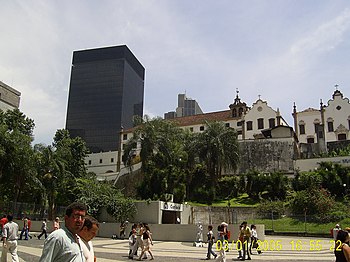
When shopping in street commerce, always bargain; this can lower prices considerably. Bargaining in stores and malls, though, is not welcome. But naturally merchants won't bargain unless you ask, especially if you are clearly a tourist. To tourists, items can easily be overpriced by a factor of 20% especially in highly informal markets such as Saara or on the beach.
For trinkets, your best bet is the "hippie fair" in Praça General Osório in Ipanema every Sunday.
Great bargains can be had on Brazilian-made clothing, as well as some European imports. Most imported items, however, such as electronics, tend to be insanely expensive due to protective import duties. For example, you will find digital cameras sell for about twice what they sell for in Europe or the U.S.
Store managers in Rio often speak some English, as this gains employees an almost-automatic promotion. But "some" can be very little, so it is useful to learn at least some very basic Portuguese. Just knowing basic greetings, numbers, and how to ask directions and prices will get you at least a "B" for effort, and despite finding that store clerks may know more English than you Portuguese, it can still come in handy to know a bit of the language. Don't be afraid to resort to writing numbers, pictures, or resorting to pantomime. Shop assistants will often tap out prices for you on a calculator. Visa and MasterCard are widely accepted in Brazil, with American Express to a slightly lower degree but this have been improving.
A great choice of gift, since they do not take much space in the suitcase back home, are bikinis, a trademark from Rio for its quality and fashion style.
Shopping malls can be found all over town, with the cheaper ones in the Zona Norte like Shopping Tijuca and Shopping Iguatemi and popular upscale shopping malls concentrated in the Zona Sul like Shopping Rio Sul and Shopping Leblon and São Conrado Fashion Mall and BarraShopping in Zona Oeste .
Organic Food
Organic food arrived in the Brazilian supermarkets but if you want to support local small scale farmers you might consider the following fairs of Circuito Feiras Organicas Carioca :
Ipanema, Praça Nossa Senhora da Paz, from 7h to 13h
Tijuca, Praça Afonso Pena, from 7h to 13h | LEBLON, Praça Antero de Quental, from 7h to 13h
Bairro Peixoto, Praça Edmundo Bittencourt, from 8h to 13h | GLÓRIA, Rua do Russel, from 7h to 13h | JARDIM BOTÂNICO, Praça da Igreja São José da Lagoa, from 7h to 13h
In Rio de Janeiro you can probably find something to fit any craving. A good approach to local food is "comida a kilo" - buffet style restaurants where you pay by the weight of the food on your plate. An excellent place to go with your friend or even with your partner is the Fellini restaurant. Located in Leblon, the place has a "pay for what you eat" buffet, with really good and beautiful food. Great for all tastes, it has even Asian food on the menu. Another one is Ming Yue, Rue do Lavradio 106, near Lapa. Ming Ye offers a wide range of Chinese stir-fry and delicious sushi, as well as Brazilian dishes for cheaper prices.
Don't miss the most famous Brazilian dish, feijoada (fay-zho-AH-da), a black bean stew filled with big chunks of meat, like sausage, pork and beef. Along with the "feijoada", you also get some colorful side dishes that come with it, such as rice, cassava (roasted manioc), collard greens, fried pork rinds, and some orange slices, to sweeten things up a bit. This is bonafide, authentic carioca culinary excellence, almost worth the trip alone! Best while sipping down a "caipirinha".
For the hungry, nothing beats a good rodízio (all-you-can-eat service). These are available in numerous types, although the most well-known are the churrascaria , all-you-can-eat grilled meats. Marius , in Leme has arguably the best churrascaria in town. Carretão has a good and cheap(er) rodizio. At various restaurants around town, you can also find rodízio style dining featuring seafood, pizza, or various appetizer-style snacks. The defining element of rodízio is that unlike an all-you-can-eat buffet, the servers continuously bring skewers of various meats.
If you like meat but want an alternative to the rodizios, a good place to eat at is Filé de Ouro (Rua Jardim Botânico, 731, Jardim Botânico; ☏ +55 21 2259-2396 ; see Google Maps for directions). The place is simple and cozy. During the weekends there are usually big lines, but the steak is delicious. Try "Filé à Oswaldo Aranha", with toasted garlic.
Brazil has the largest population of Japanese outside of Japan , and sushi has become widely popular in Rio too. If you are a sashimi and sushi lover, you will find a great deal of options in Rio de Janeiro. If you are in Ipanema or nearby, a great tip is Benkei [ dead link ] , that has an "all you can eat" buffet, with high quality products, great environment and staff for nice prices.
As a former ex Portugal colony, Brasil has maintained many influences of this country on its culinary. Therefore, you will find great authentic Portuguese restaurants in Rio. A good option, from the localization to the ambiance, and naturally the food, is the CBF Restaurant , in the Tiradentes Square, a lovely area full of antique architecture.
In Ipanema, Zazá Bistrô [ dead link ] is a trendy, sexy and exotic place with great South Asian dishes. Good to go as a couple.
Because its huge coast, many Brazilian specialties are in the seafood area. They are very rich in shrimps, lobster, calamaris, shellfish, clams, mollusks and many other tasty fishes. So, once in this land, don't miss the opportunity to order those lovely dishes.
The highest recommendation for a decently priced superb meal is at Sobrenatural , that has the some of the freshest fish in Rio. Go on Monday, Wednesday or Friday, when they have live samba and chorinho music by renowned artists. Try their moqueca dishes. It is located at Rua Almirante Alexandrino, 432 Santa Teresa.
For sophisticated people who enjoy simple life, Via Sete is in the heart of Ipanema, on Garcia D'Ávila. This grill restaurant offers a great bang for the buck: from their veranda you get to people-watch pretty Brazilians. There you can enjoy tasty wraps and sandwiches.
Travellers with fatter pockets may also splash out a bit at the Dias Ferreira street in Leblon, Rio's up-and-coming restaurant row.
There are many places to get pizza and lots of restaurants also offer pasta.
Rio is also famous for its pastries and street food, heritage from Portuguese and old European culture. In most cafeterias ( lanchonete ; lun-sho-NETCH) you can have a pastel (pahs-TELL) or salgado (saw-GAH-do; local pastry). Typical pastries are coxinha (ko-SHEEN-ya; chicken nugget shaped like a chicken leg), and unique Rio's joelho (zho-EH-lyo; rolled dough filled with ham and cheese). Also try pão de queijo (pawn-deh-KAY-zho; cheese baked dough), typical from Minas Gerais but very common in Rio as well, and tapioca (typical from Bahia ), a kind of crepe made out of manioca flour.
For drinking, ask for guaraná (gwa-ra-NAH; soda made from the seed of an Amazon fruit, also available as a strong drink), mate (MAHTCH; sweet ice tea; not like Rio Grande do Sul or Argentina 's hot and sour mate ), água de coco (ah-gwa-djee-KOH-ku; natural coconut water) or caldo de cana (caw-do-djee-KAH-na; sugarcane juice). There is also a common fruit called açaí (ah-sah-EEH), with a dark-purple pulp out of which are made juices, and ice-creams. Typical cariocas eat it like cream in cups or glasses, mixed with granola , oats or other flakes. The best place for such drinks are one of a number of Rio's open juice bars. Very often, these are located on street corners and have long, curved bars offering you juices from pretty much every fruit you can imagine. The best option is a small chain of juice bars called "Big Bi's" . The juices are astounding value alongside their good selection of salgados and sandwiches. Their açaí is one of the best in terms of value and taste and the staff are excellent. On top of all this, if you leave a tip, you get a big " Obrigado " from all the staff. For the best Big Bi's experience, try the Tangerina ao Limão juice along with the famous Bauru sandwich. Finish it all off with an açaí to go. Perfect. Big Bi's has a few branches dotted around Copacabana and Ipanema, one of which is on the corner of Rua Santa Clara and Rua Barata Ribeiro in Copacabana. If you then cross the road of Rua Barata Ribeiro, you will land at an exquisite ice cream parlour.
There are many specialized "health food" shops that offer an incredible variety of rich meat and vegetable sandwiches, plus an awesome variety of fruit juices, many of them delicious and usually unknown by foreigners. Among them are graviola, fruta do conde, jaca, açaí, guaraná, pitomba, mango, coconut, orange, lemon, papaya, melon, etc. (they make it as you ask and all food is 100% organic and fresh. The meal is often prepared as you wait, so you can ask them to mix whatever fruit you want and create a customized mix if you like). You must try açaí and guaraná, Amazon fruits which are famous to be the strongest energizers and anti-oxidants of the world. They also offer Brazilian snacks (including many Italian and Oriental delicacies), and other simple but delicious things to eat. I never got enough of them! These shops usually are cheap and hang many fruits at the entrance or somewhere visible to display their quality.
Warning: look for clean places, as hygiene can be poor in many street shops.
If your palate is homesick for more familiar tastes, Rio has most of the fast-food chains found around the world (McDonald's, KFC, Domino's, Outback, Subway, Pizza Hut and Burger King). Bob's and Habib's are the biggest national fast food chains.
Many foods that in other countries are simply picked up in the hands and eaten, are either eaten with knife and fork (such as pizza) or are picked up by wrapping a napkin around the food so that it is not touched with the hands (such as sandwiches). You will undoubtedly notice napkin dispensers on the tables in most restaurants for this purpose.
After Hours
Leaving a club or a bar, late in the night? The best option is Cervantes in Prado Júnior Street, in Copacabana. It closes only with the sun raising. The menu is composed by big sandwiches, with whatever you want: ham, salami, cheese, tenderloin and so on, with one home special ingredient: a big pineapple slice. It's a tropical taste to the end of your night. Look out for the legendary "Penguin Waiter", who've been working there forever. You won't have a problem to find out who he is.
- Botequim (pronounced 'boo-chi-KEEN') also well known as boteco - These quite unpretentious bars with simple appetizers and lots of ice-cold chope (draft beer) are everywhere and are almost inseparable from the carioca lifestyle. Try Bracarense ( 85, José Linhares street, Leblon ), one of the most traditional.
- Juice bars - Of particular note for an often hot and muggy city are the refreshing juice bars, found on nearly every corner in the city. Choose from dozens of freshly squeezed fruit juices - mix two or three fruits together or simply try the freshly squeezed orange juice. For a delicious Brazilian special try the açaí , a smoothie made from a deep purple fruit from the Amazon.
- Caipirinha , a drink made of cachaça (a Brazilian liquor made of sugarcane juice), lime, sugar and ice cubes.
- Kiosks along the boardwalk at Copacabana and Ipanema beach stay open all night.
- Devassa . Nine locations in Rio (and one in São Paulo), including Leblon (Rua General San Martin 1241, +55 21 2540-6087) and Jardim Botânico (Av. Lineu de Paula Machado 696, 021-2294-2915). Well-crafted microbrews, a tropical take of English ale styles.
Neighborhoods:
- Lapa - A good bet for Thursdays, several bars and clubs, but the party is in the street. There you will find people dancing and playing Samba, Choro (soft rhythm with flutes and mandolin), Reggae and Hip Hop, as well as ballroom dancing ( gafieira ), but no Rock (except for some underground, which doesn't happen often or in the same place, but usually in some less known places of Lapa) or Pop music. While drinks are sold in the bars and clubs, vendors also roam the streets wearing coolers full of beer for even cheaper prices. It can also be a very exciting and packed place on Friday and Saturday nights. Be sure not to bring valuables, as there are a lot of pick-pockets operating in the area. Don't take it for the neighborhood with the same name in São Paulo , which is totally different.
Samba clubs
Being in Rio and not going to one of the countless samba live music bars, certainly you've missed a lot on your trip. In Lapa , the nightlife district of Rio, there are many nice bars with great atmosphere where locals go for dancing and meeting people. There are a couple of them in the Zona Sul as well. Most of these bars work with a kind of consumption card, which is handed to you when you enter. Everything you consume is marked on this card, and losing it means you'll have to pay a really high fee! So take good care of it.
For those who like to go clubbing, Rio has some good options. You'll be seeing lots of flyers and talk about "raves" Usually Rio's raves are devoted to trance, which is pretty popular, especially with the upper-class youngsters, though some electronic parties do have good djs and live acts from around the world. The night in Rio is pretty much divided between mainstream and underground.
Mainstream would be such "raves" and big electronic festivals, as well a nightclubs like Zax Club (Barra da Tijuca), Baronetti (Ipanema) and Boate Praia (Lagoa) that are devoted to pop, dance and variations of house and trance. Those are not, however, places you go for the music. They are usually packed with "patricinhas" (tanned, long soft-haired girls with gym-built bodies) and specially "pitboys" (upper/middle-class boys, known for having various degrees of martial arts training and a certain tendency for violence). Yes, fights are one of the major problems with the mainstream clubbing scene in Rio. It's also fairly expensive.
Though with far less options, the underground clubbing scene is more available and interesting than the mainstream. Most of the underground clubs are on Zona Sul and offer different parties for each day of the week. The underground club scene has a more diverse public, from goths to punks also with strong hedonistic tints. It's very gay-friendly and most of the parties and clubs have almost the same m/f proportion. It is also far cheaper than the mainstream clubs. Some good alternative clubs are Fosfobox (Copacabana), Dama de Ferro (Ipanema) and Casa da Matriz (Botafogo).
For a real "carioca" experience, try Mariuzinn Copacabana. Brazilian Funk and electronic music, with an eccentric crowd. It just finishes when the last dancer gives up. Which means early in the morning. It will be an unforgettable experience.

In the Zona Sul , you will find Rio's fanciest and most popular hotels along the beaches of Ipanema and Copacabana, but there are lots of small, cheap, clean hotels around Flamengo and Catete. The street in front of the strip of tourist hotels in Copacabana can be seedy, due to both garishly-dressed tourists, and a few opportunistic locals ready to take advantage of them. The apart-hotels in Ipanema are a much more pleasant alternative, being both better appointed and in a nicer neighborhood with fewer tourists.
Accommodation in the lower Centro can be convenient for business travellers. The surrounding areas, however, are far from pleasant at night, being nearly deserted and lacking decent restaurants and leisure options. The central Santa Teresa neighbourhood, however, is quite departed from the city centre life and has plenty of pleasant bed and breakfasts and a significant nightlife.
Given Rio's rise as a fashionable destination with creative and fashion people, some hotels that cater to the design-conscious crowd have also been popping up at the most upscale neighborhoods. The city also has a large selection of apart-hotels , which provide apartment-style accommodations with kitchen facilities. Private condominium apartments can also be rented short-term at reasonable rates, and can be found on the internet. This is probably a preferable means of finding one of these than the notes that will be passed to you by anonymous persons on the street. These apartments generally have a one-week minimum, or two weeks during Carnaval or New Years holidays.
Accommodation in Rio is probably Brazil's most expensive . There is a relative shortage of hotel rooms on the cheaper range and booking in advance is recommended. Moreover, prices for most accommodation can more than triple during New Year's and Carnaval. Those are very busy periods and booking well in advance is recommended. Most hotels in tourist areas will only sell 4-day packages and charge in advance - even if you want to stay only for a couple of days during those events. Other than those, the busiest month is January - summer holidays in Brazil.
Motels, that you will see mainly on the outskirts of the city, are not motels in the North American sense. Rather, they are places you go with your lover for a few hours. One famous motel, overlooking the Sheraton in Leblon, was taken over by the US Secret Service when George Bush Sr stayed at the Sheraton. It is not recorded whether heart-shaped beds, mirrors on the ceiling and on-tap porno movies affected their work!
If hostel life is more your style, they are easy to find in Rio. The more expensive ones boast locations that are short walking distance to either Ipanema or Copacabana beach. However, if you prefer to stay in Lapa, Glória, Catete, and Botafogo, there are many other choices available. Hostelling has become increasingly popular in Brazil, and many of them are located at walking distance from hot spots. Beware, however, not to be taken to any fraudulent scheme - you might end up being robbed. Look for accredited places with Youth Hostelling International and similar franchises.
To experience Rio from another point of view, there's also the opportunity to stay in various hostels in one of the favelas. Due to presence of many police units (called Unidade de Polícia Pacificadora, UPP), it is reasonably safe to stay in some favelas. Ask your hosts about the actual situation, though. See for example Zona Norte for a stay in the Complexo do Alemão .
Stay healthy
Rio is vulnerable to epidemics of dengue fever , particularly during the late summer months of February and March. If an epidemic occurs, be sure to take the appropriate precautions by using insect repellant and, if you happen to be staying at a place with a balcony, make sure there is no standing water around.
As elsewhere in Brazil, some beaches in Rio are not suitable for bathing, and conditions can change from day to day. On the day of your visit, check the latest weekly bathing bulletin (in Portuguese, boletim de balneabilidade ) of the state's Environment Department (INEA). At the bottom of the page, there is a large ad for a mobile app called Partiu Praia Inea that provides you an up-to-date map of bathing conditions.
Use sunscreen, especially in your face and shoulders, to avoid having a bad experience with sunburns. Any common drug store sells a variety of sunscreen products, and even cocoa butter lip sticks, to avoid having little cuts after dry lips.
Here is a list of medical clinics and hospitals in Rio de Janeiro:
- Hospital Copa D’Or - Address: Rua Figueiredo de Magalhães, 875 – Copacabana, Rio de Janeiro – RJ, 22031-011 - Phone: +55 (21) 2545-3600
- Hospital Rio Laranjeiras - Address: R. das Laranjeiras, 72 – Laranjeiras, Rio de Janeiro – RJ, 22240-000 - Phone: +55 (21) 2555-2000
- Hospital Israelita Albert Sabin - Address: Rua Professor Gabizo, 319 – Maracanã, Rio de Janeiro – RJ, 20271-065 - Phone: +55 (21) 2176-8800
- São Lucas Hospital-Copacabana - Address: Condomínio de Hemodinamica – Tv. Frederico Pamplona, 32 – Copacabana, Rio de Janeiro – RJ, 22061-080 - Phone: +55 (21) 2545-4000
- Hospital Samaritano Barra - Address: Av. Jorge Curi, 550 – Barra da Tijuca, Rio de Janeiro – RJ, 22775-001 - Phone: +55 (21) 3263-1000
- Ibogaina Rio de Janeiro - Address: R. Bom Pastor, 295 – Tijuca, Rio de Janeiro – RJ, 20521-060 - Phone: +55 (21) 2159-2300
- Hospital Unimed Rio - Address: Av. Ayrton Senna, 2550 – Barra da Tijuca, Rio de Janeiro – RJ, 22775-003 - Phone: 0800 031 3861
Public Hospitals of the State of Rio de Janeiro
- Hospital Estadual Getúlio Vargas - Address: Av. Lobo Júnior, 2293 – Penha Circular, Rio de Janeiro – RJ, 21070-061 - Phone: +55 (21) 2334-7856
- Hospital Universitário Pedro Ernesto - Address: Boulevard 28 de Setembro, 77 – Vila Isabel, Rio de Janeiro – RJ, 20551-030 - Phone: +55 (21) 2868-8000

Rio De Janeiro's reputation as a dangerous city was cemented internationally by the critically acclaimed movie Cidade de Deus — a reputation that's not entirely unwarranted, but most visitors to the city have a great time with no incidents.
Still, Rio can be dangerous . As a traveler, even if you don't leave the "Zona Sul" (which includes Copacabana, Ipanema, Leblon, Gávea, Jardim Botânico, Flamengo, Laranjeiras, Botafogo, Urca) or Western Suburbs (Barra, Recreio), you may experience a palpable tension over security.
Generally, tourists (also called "gringos," which is not derogatory but means "outsiders") and teenagers are considered "easy" targets for criminals. Day-to-day living has also been affected by this. For example, regular banks all have fortress style security doors and armed security men. Rio can be a dangerous city and it is wise to follow these rules even if they seem exaggerated.
In order to fully enjoy your trip the traveler should pay attention to simple things. Avoid the downtown area, especially Saara , after dark. Although downtown is a relatively safe place during the day, after-dark all the people who work there have already gone home. If you are going to a theater or a show, it's all right; but do not wander in those dark streets by night. It is better to take a taxi/Uber direct from your hotel to your final destination and back rather than go around seeking for public transport. Go to Ipanema beach, which is relatively safe at night as long as you don't stand out as an obvious tourist. In general, crowded areas with good lighting are safer, and you should avoid dark, empty places.
On Sunday, most shops are closed and their security guards are absent, so the neighbourhood Centro is not safe in the daytime. Also, even the bigger streets in Copacabana are less safe after dark so the beach walk is probably the best option.
Should you find yourself being mugged, the normal advice applies:
Don't resist or do anything to aggravate the muggers. Try not to stare in their faces as they might think you are memorizing their appearance. Eyes to the ground is probably your best bet. Let them take anything they want (keep your arms limp). Afterwards, leave the scene quickly but calmly (don't run in panic screaming for the police).
In the morning, especially before the police arrive, if you are walking or jogging on, Copacabana should be considered unsafe. Even with people around, joggers are popular targets for mugging. If you plan on jogging make sure not to wear anything that may tempt a mugger (watch, iPod etc.) and if you can, wait until after 10AM.
Don't walk along the banks of the Rodrigo de Freitas Lagoon (South Zone) after dark, you might get robbed.
When in downtown during the rush hour, be aware of pickpockets as in any other big city centre. The difference in Rio is that the pickpocket can often be a bit violent: one of them pushing you forward in the bus or to the ground in the street while another one takes your wallet and runs away. It's not that usual or as bad as it sounds, but try to avoid being in real danger by reacting strongly as these guys often operate in armed groups (2-5 people), some unnoticed by you.

In the area around Copacabana beach (and maybe in the city centre), the tourist should be aware of a shoe shining scam. The tourist will be approached by a shoeshiner and to his astonishment discover a large, dirty blot on his shoes (which is actually shoe polish or mustard but looks like quite something else). The tourist is typically shown to a chair and has his shoes or sandals cleaned in the best manner. Only after this service is rendered, the outrageous price of somewhere around R$1000 or more is revealed. At this point, muscular friends of the shoeshiner typically appear to "oversee" the completion of the transaction.
The subway is very safe, so it is recommended to use it if you want to go from one place to another.
The suburban rail is generally not useful for tourists. If you do take it, note that trains may not come all that frequently, especially on weekends, and they tend to be filled with hawkers selling various cheap goods and sometimes evangelical preachers. Although the trains themselves are generally safe, a lot of the stations aren't, especially on the Belford Roxo (purple) line. Avoid photography on the suburban rail system.
Buses on the South Zone are fairly safe as well, but they can be quite crowded. Inside a bus, being mugged is always a threat: less so but still possible in the South and tourist zones. Don't use a phone while sat next to an open window since it can get snatched from your hand. Remember that Bus 174 movie. It happens so often that they don't even go to the news (only homicides or big cases where the police got involved such as this Bus 174 go to the news). In the subway, it is very unlikely though, which is one extra point to the subway!
Don't walk around with lots of money in your pocket. ATM's are everywhere (prefer the ones inside shopping centres) and credit/debit cards are widely accepted. But don't walk around without any money: you may need something to give to the bad guys in case you are mugged. Not having money to give a mugger can be dangerous as they may get angry and resort to violence. An excellent idea is to buy a "capanga" (literally meaning bodyguard), that is, a small frontal unisex pouch, normally used to carry your wallet, checks, money and car keys.
Avoid wearing jewelry or other signs of wealth (iPods, fancy cell phones/mobiles, digital cameras, etc.) if possible, at any time of the day, as these attract attention. Thieves have been known to run past targets and tear off necklaces, rings, and earrings without stopping. Earrings are particularly dangerous as tearing them off often harms the owner.
There are around 700 favelas in the city and some of them can potentially be unsafe in Rio: and there is always one near you (by a couple of miles or just a few yards). These are easily recognized by their expansive brick walls, and are often on a hillside. The slums grew from being impoverished neighborhoods. They were known for being ruled by drug lords prior to a concerted effort to retake them by the police. For the more adventurous, some favelas are amazingly huge, and a new experience for some—there are some travel agencies who take people on tours there. The tour operators have "safe-conduct pacts" with the local drug dealers. If you try to get a tour without using one of those agencies think carefully about whether your guide is reputable. Despite the pacifying efforts, most favelas do not have a permanent police presence, so there is often no recourse for a traveller who is ambushed by a drug baron's guards.
In Brazil, every state has two police forces: the Civil ( Polícia Civil ) and Military ( Polícia Militar ). Only the latter wear uniform (in Rio, it is navy blue). The city of Rio also has an unarmed Civil Guard, dressed in khaki. Policemen can usually be trusted, but corruption in Brazil is still rampant and a few officers may try to extort you or demand a little bribe. When this happens, it is usually very subtle, and the officer may typically say something about "some for the beer" ( cervejinha ). If you are not willing, refuse and ask for another officer. Don't ever try to bribe a policeman on your own—most of them are honest and you might end up in jail.
The local emergency dial number is 190 .
At night, especially after traffic has died down, you may hear what sounds like fireworks and explosions. This is not as menacing as it sounds, though it is still indicative of somebody up to no good. These are often firecrackers set-off as signals in the favelas. It might mean that a drug shipment has arrived and is in-transit or that the police are making a raid into the favela. It is a signal to gang operatives who act as lookouts and surrogate police to be extra-vigilant. However, real shoot-outs may occur, especially on weekends. If you are on the street and you hear a shooting, find shelter in the nearest shop or restaurant.
For your safety, cross at the crosswalks, not closer to the corner, and watch for cars regardless of traffic lights.
Carjacking can be a threat too, especially if you are outside the tourist areas and after dark. It is perfectly acceptable (even if not exactly legal) not to stop at the traffic lights if there is nobody else on the street and you feel it's okay to go (if there are no other cars). You will see even police doing this. Some major motorways such as Linha Amarela (Yellow Line: connects the west zone( Barra da Tijuca ) to the north zone - may be your way to Norte Shopping for example) and Linha Vermelha (Red Line - the main connection from the International Airport) are strongly avoided late at night. Both motorways are surrounded by favelas, so carjacking is usual and shoot-outs may occur between rival drug lords or between drug lords and the police. If you rent a car, be aware of all these issues. As a tourist, it may be better not to rent one anyway, as if you get lost and go to a bad neighbourhood (and again, there will always be one near you), you will most likely be in trouble.
If you want to go to a traditional escola de samba (samba school), Mangueira is a good place. This is close to a favela, so you should go with a guide accordingly. If you do have a trustful Brazilian friend that can take you, that's excellent. Ask the friend to take you to Maracanã as well to watch a football (soccer) match! Yet exercise great caution if you go by yourself especially if two of the local Rio teams are playing (Flamengo, Fluminense, Botafogo, and Vasco). These matches can be very exciting but also very dangerous especially if between Flamengo and Botafogo or Vasco. If it looks like the team for which the fans around you are cheering is losing, it is wise to leave the stadium before the match ends. You don't want to be in the middle of a very angry bunch of football fans when they all cram out of the stadium.
The Rio Times is the only English language news publication dedicated to the English speaking foreign community living and traveling in Rio de Janeiro, Brazil. They have been publishing weekly online since March 2009, covering Rio Politics, Business, Real Estate, Sports, Entertainment, Travel, as well as offer Classifieds and a daily Rio Nightlife Guide.
- Lavamaq's , Praia do Flamengo, 118 - Flamengo ( two blocks south of Metro Catete ), 21 2557–5965. Self-service laundry, R$25 wash and dry.
Consulates General
- Niterói – 15 km from downtown . It has a wonderful unique view of Rio and an intriguing contemporary art museum, which looks like an UFO (designed by famous architect Oscar Niemeyer). Also, it has one of the state's most beautiful beaches, Itacoatiara, which can be reached by the bus # 38. From Rio to Niterói it's a short ferry ride or you go by bus.
- São Gonçalo – 25 km from downtown. The biggest city of the Leste Metropolitano region, with the second largest population in the state .
- Duque de Caxias – 20 km from downtown. The largest city of Baixada Fluminense , neighboring to the Rio de Janeiro's North Zone.
- Maricá – 55 km from downtown. The last municipality on the sea coast of Grande Rio to the east. It has several lagoons and a single strip of sand that extends along almost the entire shoreline of the municipality.
- Rio Bonito – 75 km from downtown. A peripheral municipality, with a small population and wide rural areas with lots of nature. It is the easternmost municipality in the metropolitan area of Rio de Janeiro.
- Cachoeiras de Macacu – 90 km from downtown. The most northeastern municipality of Rio metropolitan area, it is another peripheral municipality which has become an attraction for trekking, mountaineering, rappelling and other types of extreme sports and ecotourism. Part of the Três Picos State Park is in the municipality. There are dozens of waterfalls of extraordinary beauty. The bus company 1001 goes for around R$45.00 (Sep 2023), departing from the Rio's long-distance bus station ( Rodoviária Novo Rio ).
- Guapimirim – 75 km from downtown. The most northeastern municipality in Baixada Fluminense, at the foot of the mountain range known as Serra dos Órgãos , a section of a longer mountain range called Serra do Mar .
- Paracambi – 70 km from downtown by railway (80 km by road). The most northwestern municipality of Baixada Fluminense and of the metropolitan area, at the foot of Serra das Araras , a more western section of Serra do Mar . The bus company UTIL has a route to the municipality for around R$40,00 (Sep 2023) departing from Rodoviária Novo Rio .
- Itaguaí – 70 km from downtown. Another peripheral municipality, bathed by the Sepetiba Bay, it is the last coastal municipality of the metropolitan agglomeration of Rio to the west.
On the southeastern coast of Rio State
- Saquarema – 110 km. A predominantly tourist city with beautiful beaches, in the lakes region. It is known as "The national surfing capital". Further attractions are waterfalls, cascades, mountains and an archaeological site.
- Búzios – 170 km. It's a small peninsula with several nice beaches, an abundance of night clubs and the lowest rainfall in the state of Rio. It's nickname is "Saint-Brazilian Tropez".
- Cabo Frio – 170 km. A popular tourist destination. It's famous for its beautiful beaches with fine white sand and crystal clear waters.
- Arraial do Cabo – 170 km. It's a small town near Búzios. Its beaches have the most beautiful turquoise waters of Rio de Janeiro state. Beaches like Forno and Prainhas do Atalaia are surrounded by virgin lush green coastal vegetation and have clear blue waters similar to the Caribbean ones.
In the northwest
- Miguel Pereira – 120 km. It's famous for its exuberant nature, cool climate and tranquility, for those who want to escape the hussle of big cities. One of the most visited spots is Lake Javary, where you can ride a pedal boat and breathe the fresh mountain air. The intercity buses of Util have rides for around R$40 (Dec 2021).
In the north
- Petrópolis – 70 km. In the mountains outside and a good place to cool down when Rio becomes too hot. It's known as an "Imperial City", the place chosen by Brazil's Royalty to spend the summer. There's a nice imperial museum. The city also hosts one of Brazil's first breweries which can be visited.
- Serra dos Órgãos National Park , Parque Nacional da Serra dos Órgãos — National park in the mountains.
- Teresópolis — Another mountain town, near Petrópolis.
In the west
- Ilha Grande – 180 km. It's noted for its scenic beauty, unspoilt tropical beaches, luxuriant vegetation and rugged landscape. You will enjoy hiking.
- Has custom banner
- Huge city articles
- Has mapframe
- Maps with non-default size
- Airport listing
- Listing without plain text name
- Has map markers
- Articles with dead external links
- Move listings to districts
- See listing with no coordinates
- Do listing with no coordinates
- Drink listing with no coordinates
- Has caution box
- Has caution box with out of date warning
- Listing with multiple email addresses
- Has routebox
- Usable cities
- Usable articles
- City articles
- Cities with categories
- Has Geo parameter
- All destination articles
- Pages using the Kartographer extension
Navigation menu

Rio De Janeiro
With a harbor punctuated by granite monoliths, a laid-back cosmopolitan lifestyle, and famous black-and-white-tiled sidewalks, Rio de Janeiro attracts more than two million visitors each year. The perfect day here starts on the beaches of Leblon; includes a trip up to Christ the Redeemer, one of the seven new wonders of the world; and ends in the early morning at the samba clubs of Lapa. Along the way, eat your weight in grilled meat and Amazonian fruits, taste drinks made from sugarcane liquor, and shake hands with some of the most beautiful and friendly people on the planet.
- Copy Link copied

Photo by Agustin Diaz Gargiulo/Unsplash
Can’t miss things to do in Rio De Janeiro
Hugging the sea, cradled by mountains, and neighbored by rain forest, Rio is blessed with some of the most beautiful natural scenery in the world. For the best views of the dramatic landscape, head to the Mirante Dona Marta lookout point, where you can see Christ the Redeemer guarding the city, and the prehistoric spine of Sugarloaf Mountain. Keep an eye out for monkeys in the trees around you and lizards as long as laptops. To get better acquainted with the local environment, explore the 300-plus acres of Amazonian and tropical plants at the Jardim Botânico, or take a 30-minute drive to Tijuca National Park.
Food and drink to try in Rio De Janeiro
No visit to Rio is complete without trying feijoada , a stew of black beans, meat, and garlic accompanied by rice, kale, and orange slices. Heavily influenced by Brazil’s African and Portuguese roots, feijoada is a Saturday lunch staple. Piping hot pão de queijo (cheese bread) and bolinhos de bacalhau (fried codfish balls) are snacking standbys. Wash everything down with a glass or three of chope , Rio’s ubiquitous draft beer. A more potent potable is the caipirinha, a cocktail made from muddled lime, sugar, and a cane liquor called cachaça. If you drink one too many, a cold plate of açaí from any of the city’s juice stands is a popular—and effective—hangover cure.
Culture in Rio De Janeiro
Cariocas , as residents of Rio are called, know that a good life is one spent outdoors. They eat their breakfast at sidewalk tables, drink their beer in open-air bars, and hold impromptu dance parties on moonlit cobbled streets. Spending time on Rio’s beaches is the best way to appreciate the spirit of acceptance and expression that birthed the hip-shaking moves of samba and the skin-baring costumes of Carnival. The body is celebrated here, and the come-as-you-are vibe of the beaches spills onto the city’s sidewalks, where you’re just as likely to encounter board shorts as you are business suits.
There’s more to Rio than epic views. To experience the city like a local, hit the streets. Grab a suco (fruit juice) from your choice of juice bars then pop into a restaurant to cheer during a football game and down a few glasses of chope , Rio’s light draft beer. Take a walking tour of the city’s favelas, or shanty towns, with a Rio-based group like Favela Adventures. For dinner, follow the locals to Bar Do Mineiro in the bohemian Santa Teresa neighborhood. Don’t worry about trying to translate the menu; just close your eyes and point. After dinner, grab a street-side table at the Bar Veloso boteco in Leblon for more chope and people-watching.
Practical Information
The high season in Rio runs from December through March. May through September brings thinner crowds and lower prices. Most visitors arrive at the Galeão-Antônio Carlos Jobim International Airport, which has several transfer options into the city. People of many nationalities must obtain a visa before entering Brazil. Rio is huge and thus best explored via metro, bus, and taxi. Brazilian Portuguese is spoken here, and locals appreciate a few greetings and pleasantries spoken in the native language. English menus are available at the more popular restaurants, and tips are usually included in the bill. The Brazilian real is the only currency accepted, though many businesses take credit cards.
Guide Editor
Helen Anne Travis

Rio de Janeiro Travel Guide

Courtesy of Anna Gibiskys | Getty Images

Why Go To Rio de Janeiro
Known as the Cidade Maravilhosa (Marvelous City), this glimmering Brazilian metropolis has certainly earned its title. Resting at the mouth of a bay harbor, the city is lined with white-sand beaches and surrounded by staggered green mountains covered in a lush tropical forest, Rio de Janeiro boasts dramatic views from nearly every angle. From the slopes of Corcovado Mountain, you'll admire the striking 124-foot-tall Christ the Redeemer , who overlooks Rio's pristine beaches. And from the shores of Copacabana and Ipanema , you'll marvel over the picture-perfect backdrop that has charmed Cariocas (native Brazilians born in Rio de Janeiro) and visitors alike for more than 500 years.
But there's much more to Rio than scenic vistas, tropical forests and cerulean seas. Here, diversity, exuberance and a laid-back attitude dominate the city's character. Stroll along Avenida Atlântica in Copa, and you'll find a city brimming with bikini-clad beachgoers. The city is also known for its love of sport. From Maracanã Stadium (home of the 2014 World Cup finals and the 2016 Olympic Games) to beach volley at Flamengo Park (known as Aterro do Flamengo ), the city is alive with activity. At night, you'll hear the energizing beats of samba pulsating through the city streets in Lapa . And if you visit in February — just in time for Carnival — you'll witness Brazil's vibrant parades and heaving blocos (street parties) that draw revelers from across the globe.
Note: Rio de Janeiro isn't without its share of problems, although most violent crime occurs on the outskirts of the tourist areas. In general, low-income urban areas, known as favelas , should be avoided due to gang-related violence. However, Vidigal, a favela near to Rio's affluent neighborhood Leblon, is a popular tourist spot and is widely considered safe (you will have to go through Vidigal to reach the entrance to the very popular Dois Irmãos (Two Brothers) hike, which dozens of tourists do daily, often without a guide). Visitors should consult the U.S. Department of State's website for the most up-to-date travel advisories.
Find Flight and Hotel Deals
Navigate forward to interact with the calendar and select a date. Press the question mark key to get the keyboard shortcuts for changing dates.
Navigate backward to interact with the calendar and select a date. Press the question mark key to get the keyboard shortcuts for changing dates.
- # 8 in Best Places to Visit in Central and South America
- # 9 in Best Summer Vacation Spots in the World for 2024
- # 9 in Best Places to Visit in February
See All 7 Rankings
Best of Rio de Janeiro
Best hotels in rio de janeiro.
- in Sofitel Rio de Janeiro Copacabana
- in Sheraton Grand Rio Hotel & Resort
- in Belmond Copacabana Palace

Best Things to Do in Rio de Janeiro
- # 1 in Christ the Redeemer
- # 2 in Tijuca National Park
- # 3 in Jardim Botânico

Popular Tours

Full Day: Christ Redeemer, Sugarloaf, City Tour & Barbecue Lunch
(2407 reviews)
from $ 72.00

Rio's Full Day: Selarón Steps, Christ & Sugarloaf – Tickets & Lunch Included
(1727 reviews)
from $ 137.24

Full Day in Rio: Christ by Train, Sugarloaf, Selarón & Barbecue
(541 reviews)
from $ 75.00
Rio de Janeiro Travel Tips
Best months to visit.
The best time to visit Rio is between December and March, when the weather is warm and sunny enough to hit the beaches, although there may be quick but heavy downpours in the evenings. The city's seductive samba beat and incredible panoramic views last year-round, but arrive in February to experience Carnival. This five-day festival leading up to Fat Tuesday brings tens of thousands of visitors and locals to the streets for parades and parties. Finding an affordable place to stay during Carnival can be difficult; you should consider booking your hotel and flight up to a year in advance. Between January and March, daytime temperatures can sometimes surpass 90 or 100 degrees Fahrenheit. If you prefer more moderate conditions, visit during autumn (April and May) or spring (October and November), when temps fall back to the 70s and low 80s during the day and the 60s at night.
Weather in Rio de Janeiro
Data sourced from the National Climatic Data Center
What You Need to Know
Using ATMs Most ATMs accept international credit and debit cards. Most ATMs in banks, supermarkets and shopping malls are open from 6 a.m. to 11 p.m., and on holidays and Sundays, ATMs close at 8 p.m. Airports and some gas stations and hotels have 24/7 ATMs. If you use cash, make sure you have small bills (ideally less than 50 reais) to make getting change easier.
Cards are accepted Contactless payments are available throughout Rio. When paying by card you need to specify if it's debit or credit; sometimes, a debit card will only work when processed in the card machine as a credit card. American Express may not always be accepted.
Uber is popular Although public transport will get you to all corners of Rio, Uber is a quick and relatively inexpensive way of getting around. It usually works out much cheaper than a taxi and you can get Uber from Rio's airport via the app.
How to Save Money in Rio de Janeiro
Grub by the pound Rio de Janeiro is full of buffet-style restaurants that charge by the kilo. Look for signs that say "por kilo" and then pile your plate – it's a great way to try a selection of typically Brazilian foods, too.
Visit Samba do Trabalhador Although Lapa is known as the vibrant neighborhood for nights out, enjoy an inexpensive evening out at Samba do Trabalhador, a popular event venue among locals for live music every Monday.
Bed down at a pousada Hotel prices are notoriously expensive in the city, especially in beachside neighborhoods. To stay within budget, search for pousadas — the bed-and-breakfasts of Brazil that often include a morning meal in their rates.
Get outside Rio is famous for its dazzling hikes and the tropical Atlantic Forest that carpets the city's mountainous skyline. Best of all, entry into the forest is free. Hikes in Tijuca Forest are well sign-posted and tend to be well-trekked, making most of them safe to go without a guide for a cheap day out.
Culture & Customs
Cariocas (native Brazilians born in Rio de Janeiro) are known for their easy-going demeanor. Friendly, hospitable and always up for a celebration, Cariocas relish eating late, dancing late and dressing up in glittery costumes for Carnival — Rio's most riotous and colorful party.
Portuguese is Brazil's official language. While there are some English speakers near tourist attractions, it's helpful to bring a Portuguese phrasebook. We also recommend writing down the addresses of attractions you want to visit for taxi drivers.
You'll fit in by wearing shorts, T-shirts or a vest top and cover-ups or dresses while walking along the beaches. The classic string bikini is the typical attire on the beaches, but there's no need to feel shy – Rio celebrates all body types and there's zero judgment. Being topless is strictly prohibited on the beach, except for one designated nudist beach called Praia de Abricó. Dress code is usually casual in restaurants and along the main streets in the Zona Sul district. However, it's not unusual to spot lavishly dressed locals rummaging through clothing racks in São Conrado Fashion Mall's high-end stores or in top-end restaurants and bars in neighborhoods Leblon and Jardim Botânico .
As far as tipping goes, it is considered polite to add gratuity; however, most restaurants already include a 10% service charge on the bill. Most restaurants accept credit cards.
The real (BRL) is Brazil's official currency. The favorable exchange rate makes this South American city affordable for U.S. travelers. Check what the current exchange rate is before you go.
What to Eat
Rio de Janeiro is a culinary paradise. Its food scene reflects the city's diverse culture and demographics, blending Indigenous, Portuguese, African and immigrant influences with a mix of traditional and new to create a unique gastronomic experience.
To start your day and finish off your meals like a local, drink an espresso sweetened with heaps of sugar. A must-have dish is feijoada , the iconic black bean stew infused with pork, sausage, and herbs. Modern versions cater to vegetarians, replacing the meat with hearty root vegetables. Seafood lovers will love moqueca , a fragrant fish stew cooked in coconut milk and dendê oil, a staple of Bahian cuisine with a distinct African flair.
A popular dining experience is the all-you-can-eat meat option, called rodízio , where you can indulge in an endless stream of skewered meats. Must-tries include picanha , a prime cut of beef, and chicken hearts, which feature at every Brazilian barbecue.
Truly Brazilian street food includes pastels (deep-fried pastries that can be savory or sweet) served with ice-cold sugarcane juice; coxinhas , deep-fried dough filled with shredded chicken; and pão de queijo , cheese bread made with cassava. On the beach, sip iced tea ( mate ) and lemonade paired with the airy crunch of Globo cassava-based biscuits.
Brigadeiro , chocolate truffles rolled in sprinkles, or a bowl of açaí mixed with your choice of toppings will satisfy a sweet tooth. Don't forget to wash your food down with a classic Brazilian beer served extra cold or a caipirinha, a potent yet refreshing cocktail made with sugarcane liquor ( cachaça ), lime and sugar and poured over heaps of ice.
The tourist area – known as Zona Sul (the South Zone) – is generally safe, although exercise caution when walking around at night, especially downtown (Centro), Santa Teresa and Lapa . In all areas of Rio, remain vigilant with valuables due to pickpocketing, and keep in mind that some tourists have been involved in armed robberies (in these cases, always hand over your belongings). Carnival street parties can be a hotspot for petty theft, so keep your possessions zipped away in a secure belt bag and leave at least one backup bank card at your accommodation. Although rare, robberies have been reported on the city's hiking trails, so consider going with a reputable guide (such as Hike in Rio) or in a group, especially during the week when the hikes are quieter.
Favelas are misunderstood places, and some are perfectly safe to visit (such as Vidigal), or with a guide, such as Rocinha. That being said, most favelas are not tourist-friendly and are best avoided. If you do visit one, be respectful at all times, especially when taking photos (after all, these are people's homes), and avoid straying off the main road. Visit the U.S. Department of State's website for more details.
Getting Around Rio de Janeiro
The best way to get around Rio is by foot, subway or taxi or Uber. Major attractions – such as Lapa , Santa Teresa and other popular sites – can easily be reached by Uber or a taxi, which are not difficult to hail on the city's main streets. The beaches are easy to reach on foot and a cycle path follows the coastline from the neighborhood Glória to Leblon. For a hassle-free means of transportation from Rio de Janeiro International Airport (GIG), you'll want to get an Uber or taxi. The subway is another affordable and safe way to get around the most popular neighborhoods in the South Zone. City buses are also convenient, but unfamiliar riders can be thrown off by the non-English-speaking bus drivers. Renting a car isn't the best mode of transportation around the city, as traffic is heavy and the roads are packed with disorienting street signs and pedestrians.
Entry & Exit Requirements
United States citizens must bring a valid passport and will be granted a visa upon entry, although these rules will change on Jan. 10, 2024, when U.S. citizens will be required to obtain a visa from the Brazilian Embassy or closest Consulate before entering Brazil. A standard visa enables visitors to stay in Brazil for 90 days, which can be extended to 180 days. For more information on entry and exit requirements, visit the U.S. Department of State's website .
Most of the beaches in the city offer spectacular views of the famous mountains.
Explore More of Rio de Janeiro

Things To Do
Best hotels.

You might also like

Miami Beach
# 2 in Best Spring Break Destinations

# 1 in Best Places to Visit in March

If you make a purchase from our site, we may earn a commission. This does not affect the quality or independence of our editorial content.
Recommended
16 Top Adults-Only All-Inclusive Resorts in Mexico
Christina Maggitas|Rachael Hood|Catriona Kendall September 13, 2024

The 26 Best Beach Resorts in the World
Marisa Méndez|Erin Vasta|Rachael Hood|Catriona Kendall September 5, 2024

30 Fun Fall Weekend Getaways for 2024
Holly Johnson August 29, 2024

The 19 Best Fall Family Vacations for 2024
Amanda Norcross August 27, 2024

The 28 Best Water Parks in the U.S. for 2024
Holly Johnson|Timothy J. Forster May 8, 2024

The 18 Best Napa Valley Wineries to Visit in 2024
Lyn Mettler|Sharael Kolberg April 23, 2024

The 25 Best Beaches on the East Coast for 2024
Timothy J. Forster|Sharael Kolberg April 19, 2024

The 50 Best Hotels in the USA 2024
Christina Maggitas February 6, 2024

The 32 Most Famous Landmarks in the World
Gwen Pratesi|Timothy J. Forster February 1, 2024

9 Top All-Inclusive Resorts in Florida for 2024
Gwen Pratesi|Amanda Norcross January 5, 2024

Rio the Guide
The insider's guide to rio de janeiro.

Arriving in Rio
Arriving in Rio by air
Rio’s current international airport was once one of the largest and most important in Latin America when it opened in January 1977 and added a second terminal at the end of the 1990s. It fell out of favour during the late 1990s as more direct international services moved to São Paulo, but now under new ownership (Odebrecht TransPort and Changi Airports International), it is bouncing back and is on its way to being one of the world’s best and most user friendly.
It is the largest airport by area in Brazil with the country’s longest runway, and the second largest international airport in Brazil and the fourth largest in terms of cargo.

Past immigration you descend into the baggage claim area on the first floor where the Duty Free stores are also located. Rio is one of the few airports in the world to offer duty free goods on arrival and you will be allowed, on presentation of your passport and ticket, to currently purchase up to US$1000 worth of duty free products which can include 24 units of alcohol, 200 cigarettes and 25 cigars and 250g of tobacco, 10 toiletry items including cosmetics and three of the following: watches, toys, games or electronic items.The shop staff is bilingual and will help with any questions.

Visitors to Brazil over 18 years of age arriving by air have the right to bring in articles up to the value of $500 not bought in the duty free shop, although the limit is two liters of alcoholic beverages. Prohibited imports include toy, replica and imitation firearms, illegal drugs, cigarettes and drinks manufactured in Brazil intended for sale abroad, unlicensed wildlife species, and counterfeit and pirated goods.
Customs formalities are quite strict in Brazil and customs officials normally inspect the baggage of a number of incoming passengers. Customs, however, are not generally interested in foreign visitors so unless you are carrying something very strange you should have no problems. Customs are strictest on electronic equipment or anything linked with computers, especially if they think you are bringing them in to sell or to be passed on to a resident Brazilian. If you do have any problem, leave the item(s) with the customs official – make sure you get a receipt – and collect them when you leave. A genuine visitor should have nothing to worry about.
The airports in Brazil operate a Green and Red channel system for customs clearance with the difference being that if you choose the Green Channel you may be challenged.
Once you have negotiated customs, you have arrived. Welcome to Brazil.

After leaving the relative sanctuary of the customs hall and duty free stores you will see a balcony representing the main radio taxi companies. The joy of these taxis is that you pay the fare before leaving the airport and this is posted on a board above the taxi company’s desk. You do not run any risk of being taken for a lengthy ride or any of the other tricks that normally greet foreign visitors at airports. If you speak Portuguese you can take the white Radio Taxis outside and pay what is on the meter. This can be a false saving, however, because if you catch the morning rush hour, when journey time will be closer to one hour rather than the norm, which is about 30 to 40 minutes, you may end up paying more.
The main radio taxi companies are Cootramo (tel: 21 3976-9944), Coopertramo (tel: 21 2209-9292),and Transcootur (tel: 21 2590-2220).
Given how quickly the airport is changing and improving it is worth checking the official guide to the airport.
Getting into Rio from the airport is relatively simple even if you don’t take a taxi. An executive airport bus (2101 / 2145) links the international airport with Santos Dumont Airport in downtown Rio, 20 kms away, or you can take a similar bus (2018 / 2918) that passes all the main oceanfront hotels in Copacabana, Ipanema and São Conrado.

If you do not have a hotel reservation or need any other information go to the Riotur or TurisRio desks that are operated by the city and state tourism authorities. These are not commercial concerns, so they will provide the best and safest information. Avoid the other counters that try to pass themselves off as official looking bodies. The only relevant ones should be Riotur (City of Rio Tourist Board), Rio Convention & Visitors Bureau, TurisRio (State of Rio Tourist Board), and Embratur (Brazilian Tourist Board), or the information desks operated by the airport.
Of the airport’s four levels you will be on the first floor with only the car park below. Above are the departure areas and shops.
Do not be put off by the fairly unattractive drive into the city from the airport. The only other time that you will be back in this part of town is when you return to the airport or are driving off to visit Petrópolis or Teresópolis.
If you are flying on to another destination within Brazil you will either transfer directly within the airport or you will have to go to the departure desks on the second level and re-check in your bags. Recomended minimum connecting time are 100 minutes for international to domestic; 60 minutes from domestic to international; 45 minutes for international to international; and 30 minutes for domestic to domestic.
Worth noting that there is a hotel airside at Galeão, close to the VIP lounges. Aerotel can be a good option if you arrive late and fly out early. There is also a larger airport, Linx, located landside, and close (500m) to the terminal buildings with free transfers offered.
There is also a Premium Lounge landside on arrival equipped with shower rooms, Private Relaxation Suites, VIP room and meeting rooms. Ideal for travelers, who need a power nap or catch up some work while waiting for their next flights or recovering from their overnight flight and killing time before their hotel is ready for them. The company also operates lounges in the international and domestic departure areas that can also be booked in advance.

If you are one of the few people to arrive in Rio by sea – possibly during carnival – your ship will dock at a berth close to the new Praça Mauá on Pier Mauá , at the top end of Avenida Rio Branco in downtown Rio. The facilities are adequate, but have improved greatly since the Olympic games. Your entry to the docks, or to Brazil, will be through the Touring Club do Brasil’s building. The docks, part of the Olympic Boulevard, are quite safe during the day and are home to a number of events and the outstanding Museu de Arte do Rio and Museu do Amanha .
The whole area is being totally redeveloped under the ambitious Porto Maravilha (Wonderful Port) project.

- Already have a WordPress.com account? Log in now.
- Subscribe Subscribed
- Copy shortlink
- Report this content
- View post in Reader
- Manage subscriptions
- Collapse this bar
- South Africa
- Afghanistan
- North Korea
- Adventure + Outdoors
- Amusement Parks
- Backpacking Trips
- Boating + Cruises
- Budget Travel
- Bus + Train Travel
- Coasts + Islands
- Country Trips
- Fall Vacations
- Family Vacations
- Green Travel
- Heritage + History
- Honeymoons + Romance
- Inspiration + Guide
- Landmarks + Attractions
- LGBT Travel
- Markets + Bazaars
- National Parks + Reserves
- Nature + Wildlife
- Parks + Gardens
- Pets + Animals
- Photography
- Airlines + Airports
- Budgeting + Currency
- Business Travel
- Celebrity Travel
- Customs + Immigration
- Deals + Rewards
- Family Travel
- Hotels + Resorts
- Luggage + Packing Tips
- Offbeat News
- Photography Tips
- Responsible Travel
- Solo Travel
- Tech + Gear
- Travel Etiquette
- Travel Warnings
- Bars + Clubs
- Celebrity Chefs
- Restaurants + Cafés
- Wine + Vineyards
- Beach Hotels
- Boutique Hotels
- Hotel Openings
- Hotel Reviews
- Luxury Hotels
- Mountain + Ski Resorts
- Spa Resorts
- Vacation Rentals
- Asia Cruises
- European Cruises
- Festivals + Events
- Museums + Galleries
- Style + Design
- Travel’s Best
- Hotel with Agoda.com
- Hotel with Booking.com

14+ best places to visit in Hamburg

Hamburg travel blog — The fullest Hamburg travel guide to the…

14+ best places to visit in Luxembourg

Luxembourg travel blog — The fullest Luxembourg guide for a great…

The complete Seoul subway guide: How to use, lines, fares for…

How much does it cost to travel to Korea? Tips on…

The ultimate guide to NETS FlashPay Card: What is it, how…

How much will it cost to go to Singapore? Tips on…

13 best, most famous & popular bubble tea in Taiwan

Where to eat in Penang? 17 best places to eat &…

Best bubble tea in Taiwan — Top 11 most famous &…

29+ must-try foods in Thailand

11+ best homestays in Kuala Lumpur near famous tourist attractions

Mövenpick Resort Kuredhivaru Maldives reviews. The detailed review of my vacation…

Hyatt Regency Danang Resort and Spa reviews. The resort is highly…

+7 luxury resorts you must stay in Danang, Vietnam

10 must-know things for your best first time European river cruise

Top 3 best luxury cruises in Halong Bay, Vietnam


Cherry blossom festival Korea 2024 — Top 5 cherry blossom festivals…

Ghibli museum blog — The fullest Ghibli museum guide for first-timers

Kyoto festival — Top 10 best events & most famous festivals…

National Palace Museum Taipei blog — What to see in National…

Japanese waterfall — Top 10 most beautiful waterfalls in Japan in…

19+ most beautiful towns in Europe every tourist need to visit…

Georgia travel photos — 20+ captivating photos show Georgia is heaven…

Explore Damnoen Floating Market — The oldest floating market of Thailand

Visiting Fenghuang Ancient Town — One of the most charming ancient…

Mekong Delta travel blog — Beyond rivers of Southwestern Vietnam

14 reasons why you should travel when you are young

Shigaraki Tanuki – An animal symbol of good luck in Japan

Living in the charms of cave houses in Andalucia, Southern Spain

20+ jaw-dropping tiny homes around the world
Rio de janeiro travel blog — the fullest rio de janeiro travel guide for first-timers.

Rio de Janeiro has beautiful natural scenery, stunning tropical beaches with fine white sand and warm waters, sparkling golden sunshine. Rio de Janeiro also has a unique culture, vibrant festivals, laidback and friendly people. Tourists also call the city’s name Rio for short. With a typical tropical climate, wonderful landscapes, vibrant street festivals and top-notch matches, etc., Rio de Janeiro is one of the most famous and attractive tourist destinations in Brazil as well as around the world. So, is Rio de Janeiro worth visiting, what to do and how to plan a perfect budget trip to Rio de Janeiro for the first-time? Let’s check out our Rio de Janeiro travel blog (Rio de Janeiro blog, Rio travel blog, Rio blog) with the fullest Rio de Janeiro travel guide (Rio de Janeiro guide, Rio travel guide, Rio de Janeiro tourist guide, guide to Rio de Janeiro) from how to get there, best time to come, where to stay, best places to visit, what to eat and top things to do to find out the answer!
- What to buy in Brazil? — 18+ must-buy souvenirs & best things to buy in Brazil
- Exploring Recife — The “Venice” of Brazil
- 10 best places to visit in Rio de Janeiro Brazil
Hamburg travel blog — The fullest Hamburg travel guide to the 2nd largest city of Germany
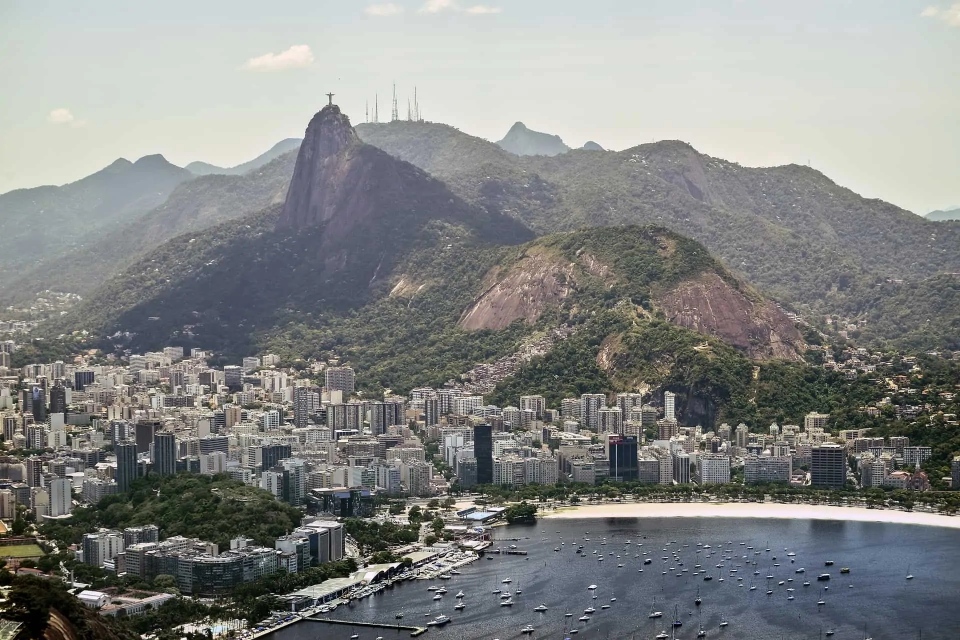
Rio de Janeiro travel blog: Overview of Rio de Janeiro
Rio de Janeiro is a city in the south of Brazil. Traveling to Brazil without visiting this magical city is not complete. Rio de Janeiro covers an area of about 1,200 km² km2 with the current metro area population of nearly 13.7 millions people (2022), famous for its magnificent scenery, carnival festivals, samba and other unique types of music.
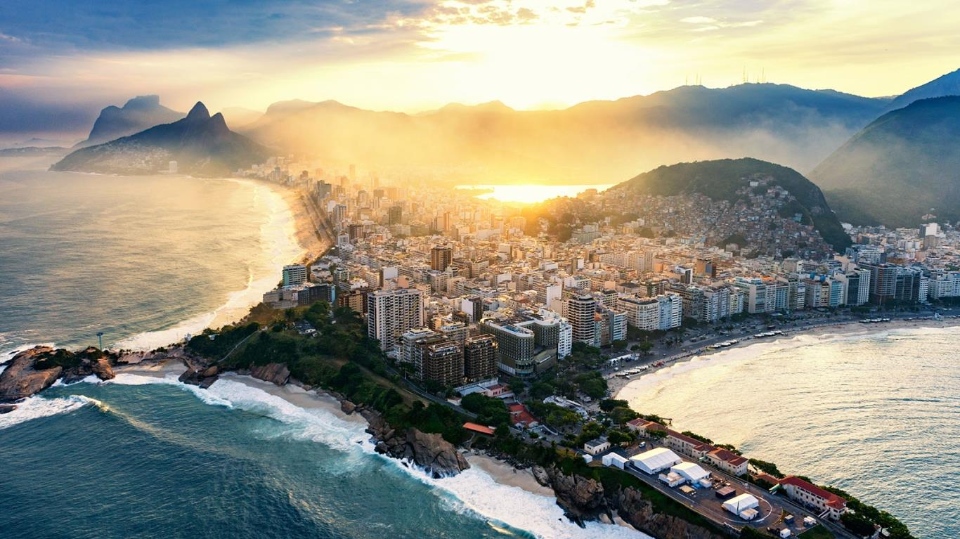
The name Rio de Janeiro in Portuguese means “River of January” and is often referred to as Rio. This city was once the capital of Brazil in the period of 1763 – 1960 and of the Portuguese Empire from 1808 – 1821. Referring to tourism in Rio, people often remember the vibrant samba dances, colorful and vivid carnival festivals, romantic stretches of beach. There is a statue of Jesus standing on the top of a mountain facing the sea that has become the symbol of the city of Rio.

In the early 19th century, Rio was once a city of slaves. In 1840, the number of African slaves who arrived in Rio was 220,000. The port of Rio de Janeiro was also the largest slave port in the Americas. Since Brazil’s independence in 1822, people in Rio de Janeiro have lived mainly on sugar cane farming and coffee farming in the valleys. The population that immigrated to Rio was mainly the poor of the empire, who later got rich quickly through industry and small business in Rio de Janeiro.
As a political center of Brazil, Rio de Janeiro has witnessed many historical periods and the heroic past of its nation and country. UNESCO recognized Rio de Janeiro as a world heritage site in 2012 (Exactly for a Carioca landscape area between the mountains and the sea). Today, Rio is a must-visit destination of any visitor when they traveling to Brazil.

Rio de Janeiro blog: When is the best time to visit Rio de Janeiro?

Rio is located on a stretch of the Atlantic coast, belongs to a tropical savanna climate, so the rainy season lasts from December to March next year, the temperature sometimes reaches the peak of 40 degrees Celsius in the summer, however, the annual average temperature ranges from 21 to 27 degrees Celsius. Rio often effected by cold air waves from Antarctica, so the autumn and winter weather is also colder, but compared to other European and Northern America countries, it is insignificant.
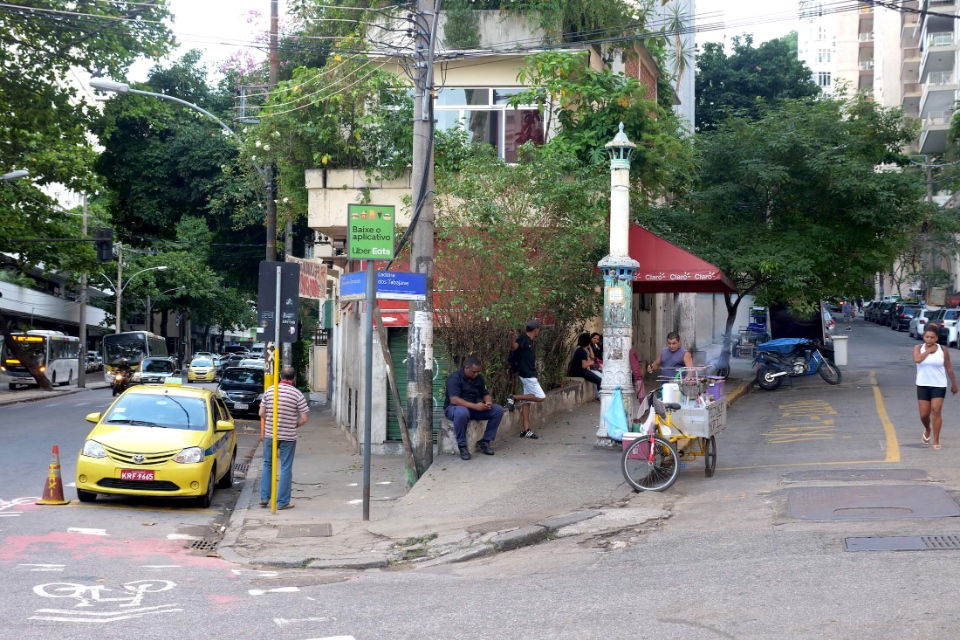
In inland areas, the temperature on summer days is usually above 40 degrees Celsius although it is rare for long periods, there are days when the temperature is just above 27 degrees Celsius. In general, the climate in Rio de Janeiro is quite dry and hot all year round. Therefore, if you plan to travel to Rio de Janeiro, do not forget to bring sunscreen.
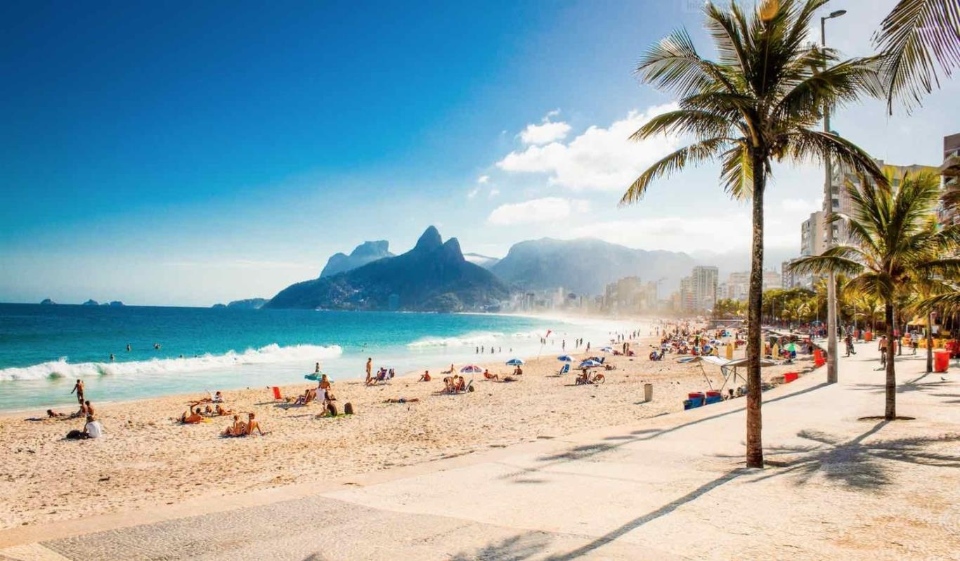
The most ideal time to travel to Rio de Janeiro is during the Carnival season in February every year, when the weather is quite cool, pleasant, convenient for walking, sightseeing and participating in outdoor activities. This is also the time when the very fascinating and exciting Carnival festival will take place in Rio, attracting hundreds of thousands of people from all over the world to participate. This is the most attractive carnival of the year, also known as the festival of love. When participating in the Rio Carnival, people will dress up in splendid and colorful costumes, especially colorful feather headdress. It will not be difficult for you to join the parade dancing around the streets with fiery dancers in a colorful space and vibrant, bustling atmosphere.

Rio de Janeiro travel guide: How to get to Rio de Janeiro?
Currently, to getting to Rio de Janeiro, the best way is travel by plane. However, currently from Vietnam, there are no airlines that open direct flights to Rio de Janeiro. You are forced to transit at 1 or 2 locations. There are many airlines to choose from such as Qatar Airways, Hong Kong Airlines, Vietnam Airlines. However, to save traveling costs, you can choose 1 of 2 low-cost carriers: Iberia (transit in Madrid) or TAP (transit in Lisbon) and land at Galeão International Airport (IATA: GIG, ICAO: SBGL).
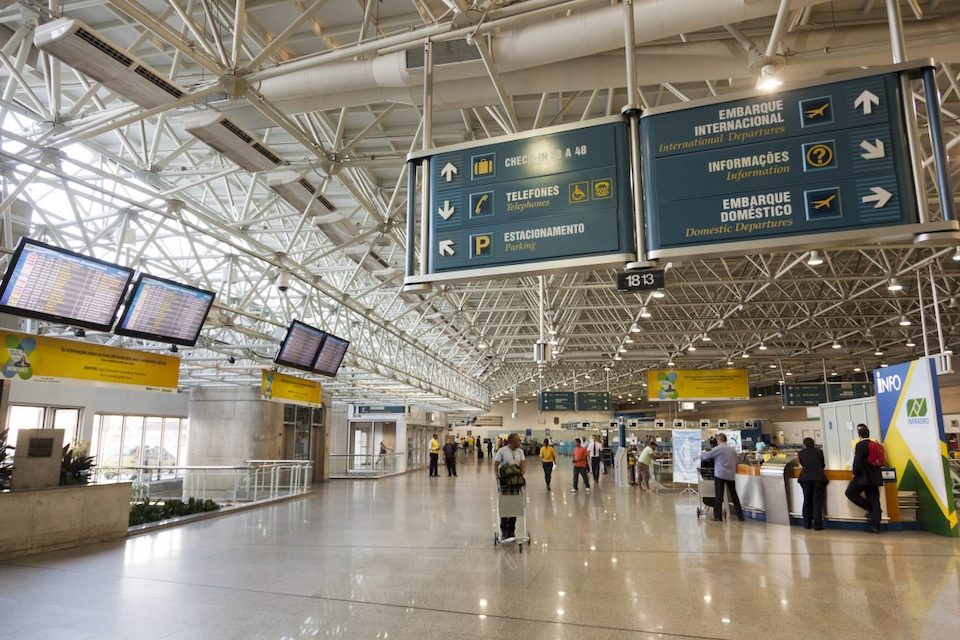
For visitors which depart from other cities around the world, you can access Google Flights , SkyScanner or Kayak to find best flights with suitable routes and cheap airfares.
For other ways to get to Rio, you can refer here .
Rio de Janeiro guide: Getting around Rio de Janeiro
When you arrive at the airport, you can take a taxi or take the subway to get to the city center. However, to save money you should go by subway because the taxi cost here is quite expensive. In Rio de Janeiro, traveling by subway is safe, convenient and clean. Train ticket price is only around 3.2 Reais (equivalent to about $0.61).
The subway is very safe, clean and fast, and the fare is also cheap, saving you money.

Traveling between famous attractions, you can use a bus, rent a bicycle, a long-distance taxi or a kombi (the Volkswagen Microbus). There are more than 60 bicycle rental stations in Rio de Janeiro, so you don’t have to worry about not knowing where to rent a bike. As for remote destinations, you should use a kombi because this vehicle is small, cheap and going faster than a bus.
If you want to visit places to visit, you can go by bus, or rent a bicycle or motorbike taxi. A type of vehicle commonly used by tourists in Rio de Janeiro is a bicycle and it is not difficult to rent.

Rio de Janeiro travel blog: Where to go, what to do in Rio de Janeiro?
Statue of christ the redeemer.
Address: Parque Nacional da Tijuca – Alto da Boa Vista, Rio de Janeiro – RJ, Brazil Hours: 8AM–7PM

Statue of Christ the Redeemer is a famous religious symbol of the city of Rio, located on the top of the mount Corcovado with 700m high, facing Guanabara Bay. The statue was recognized one of the new 7 wonders of the world and is known as the world’s most famous statue of Christ. The statue is 30m high, placed on an 8m high pedestal, has a 28m arm span, weighs about 635 tons, is the world’s 5th largest statue of Christ. The statue is made of reinforced concrete and metamorphic rock (steatite or soaprock), construction started in 1922 and completed in 1931.

The statue of Christ the Redeemer, designed with open arms, is a symbol of peace, becoming a cultural icon for the whole city of Rio de Janeiro in particular and Brazil in general. The statue of Christ is made of reinforced concrete and metamorphic steatite, the largest art deco style ever.
Visitors can take the train, car, taxi or cable car to reach the top. However, you should experience with train to admire the heavenly landscape of Tijuca National Park. In 2007, the statue of God was honored as one of the new 7 wonders of the world by the New7Wonders organization.
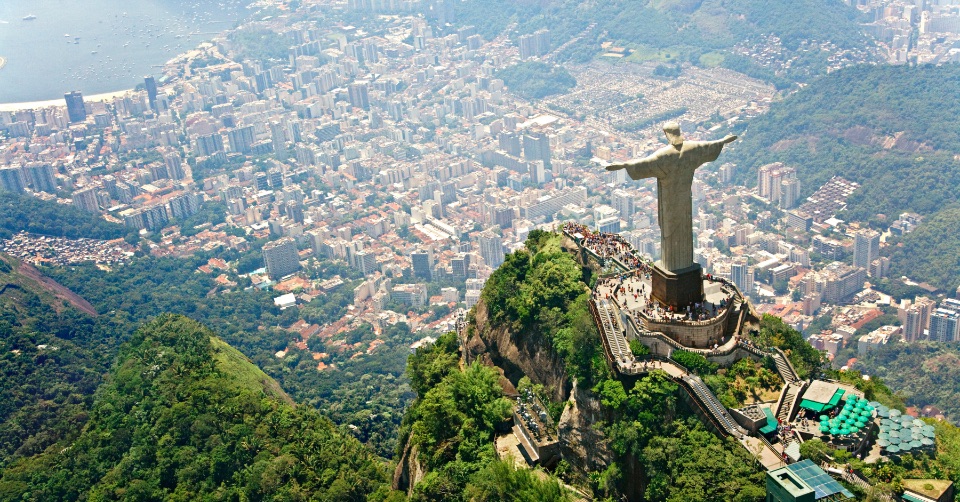
Paradise Beaches
Rio De Janeiro owns 80 km of coastline with warm water all year round. With an average temperature of 21 degrees Celsius, Rio de Janeiro is an ideal destination for those who love to relax on the beaches at any time of the year.
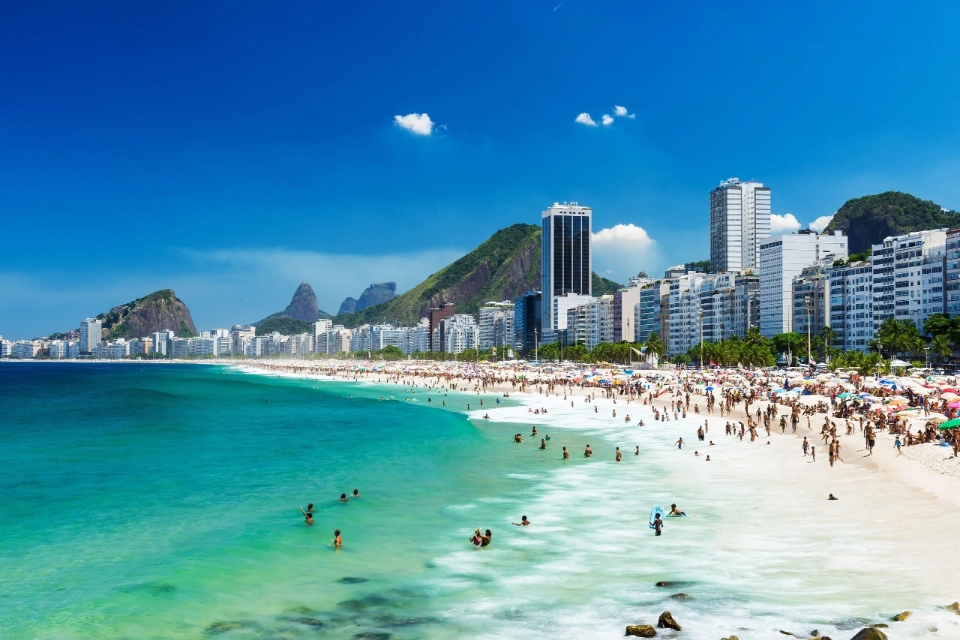
The beaches in Rio are clean, beautiful, the water is clear and quite warm. In particular, Copacabana is the most famous beach of this city. Copacabana stretching about 4.5 km, surrounded on both ends by towering mountains. This is also considered the most luxurious resort paradise in Rio city.
Along the beach is Atlantic Avenue running along the coast, between the avenue and the beach is a great seaside promenade, where you can go for a relaxing walk here. The beach area of Rio is very bustling all year round, you can see many tourists coming to swim, sunbathe, participate in beach sports activities, go for a walk or shop, watch movies, eat and drink…

Another beach that is as famous as Copacabana is Ipanema. Ipanema is a gathering place with the most young visitors. Coming here, you will join the local people to participate in beach sports activities such as swimming, surfing, paragliding, canoeing, soccer, volleyball, futevolei, to sports that combine volleyball and soccer…

The Grumari beach is the best windsurfing spot in Rio De Janeiro. Grumari has big waves that are most suitable for windsurfing. This beach with golden sand is surrounded by rocky mountains, located almost isolated, giving visitors a very interesting rural experience.
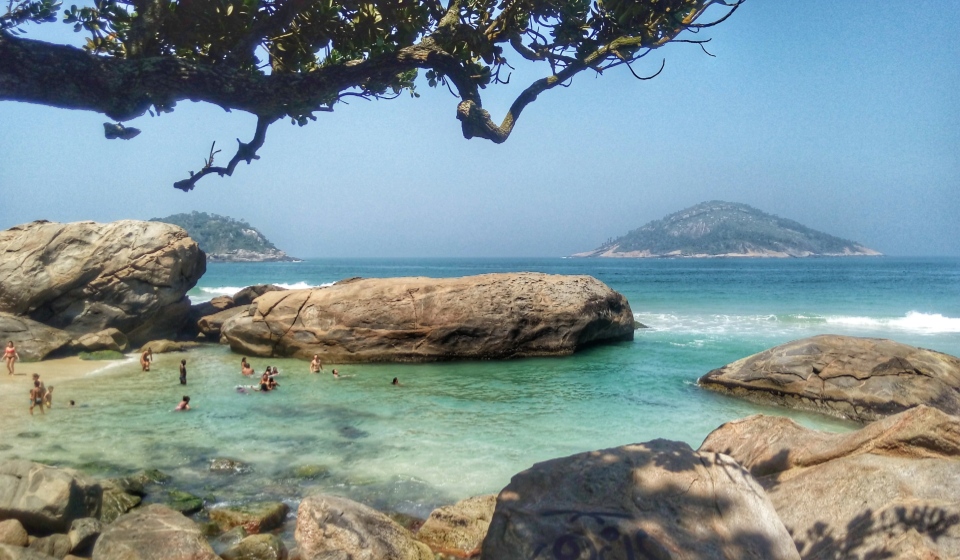
Located between Copacabana and Ipanema, this is the best place to watch the sunset over the cloud-covered mountains along the Arpoador coast. The scene will become fanciful and magnificent when the sun has just disappeared behind the peaks, leaving red streaks on the white clouds. At this moment, you can see surfers lounging on the beach resting while enjoying the picturesque scenery of Arpoador.
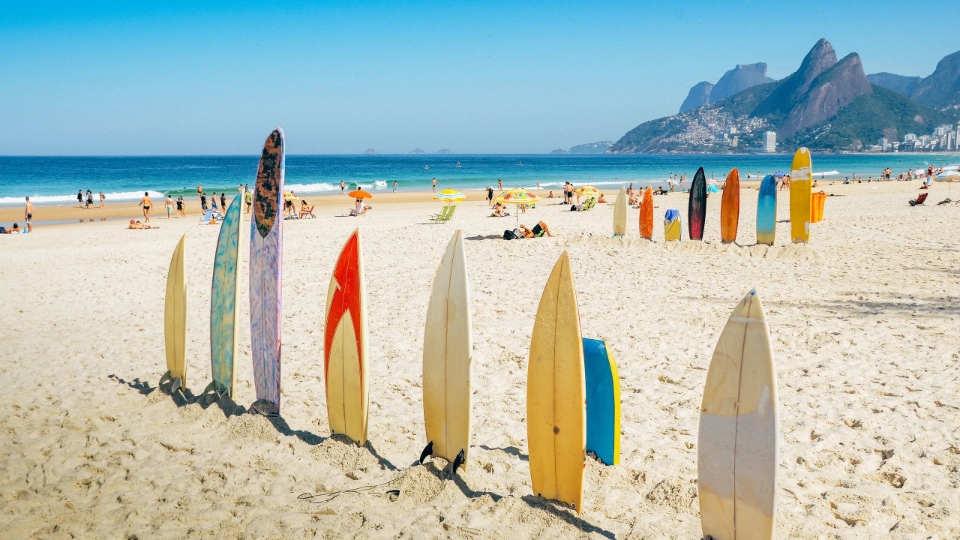
Prainha’s crescent-shaped sandy beach surrounded by mountains with crystal-clear blue sea water will captivate any visitor coming here from surfers, to families who want to enjoy the poetic beach, private and quiet. Here, there are many convenient stores selling food and drinks.
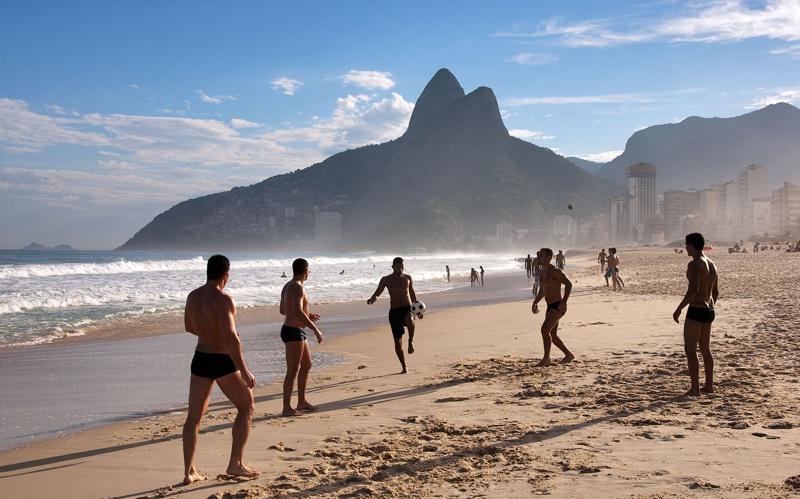
Barra Da Tijuca
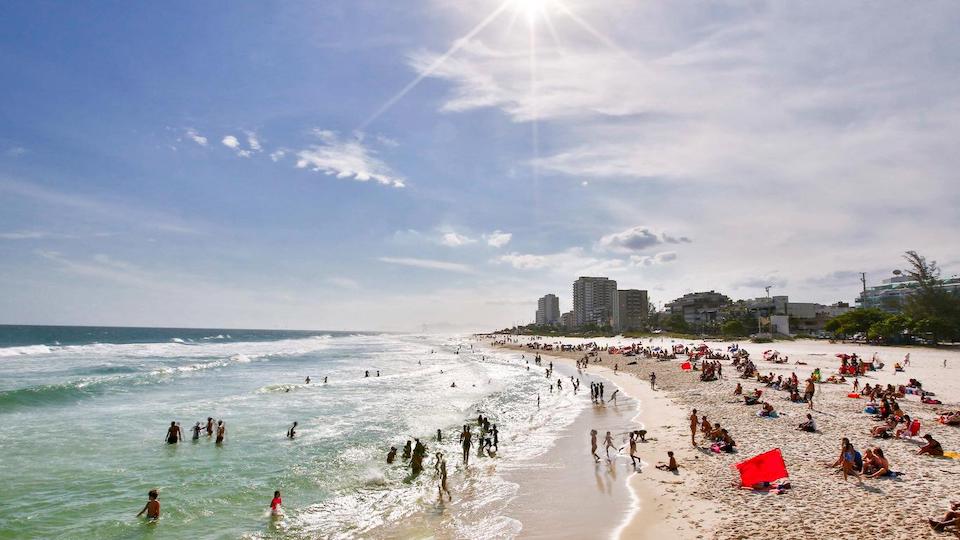
The longest beach in Brazil, Barra Da Tijuca is nearly 18km long. During the 2016 Olympic Games, the Barra Da Tijuca beach was the venue for many sports events such as longboarding, shortboarding, windsurfing, kitesurfing, windsurfing, etc. due to the weather and water conditions here very favorable for these sports. Along the coast there are quite a few schools that teach these sports for you to join.
Rio Carnival

Rio Carnival is the most famous street festival in Brazil, held annually in the Sambodromo neighborhood, with the focus of samba parades of famous dance schools in Brazil. Participating in the carnival, people will dress up in splendid costumes and accessories, join the street parade, admire the fiery performances of dancers, dance to samba tunes. Busy and immersed in the colorful space in the city of Rio de Janeiro.

The Rio Carnival event held at the Sambadrome streets with many parades of famous dancers has attracted millions of domestic and foreign visitors.
The Metropolitan Cathedral of Saint Sebastian

This church has a strange but modern architecture, designed by architect Edgar Fonceca, built from 1964 to 1979. This church has 4 huge doors, about 64 m long and hundreds of stained glass mosaic windows. Located in the heart of Rio, Metropolitan Cathedral of Saint Sebastian has the architecture like a pyramid in Egypt. The church can accommodate up to 20,000 people and is a religious site that attracts foreign tourists when visiting the city of Rio.
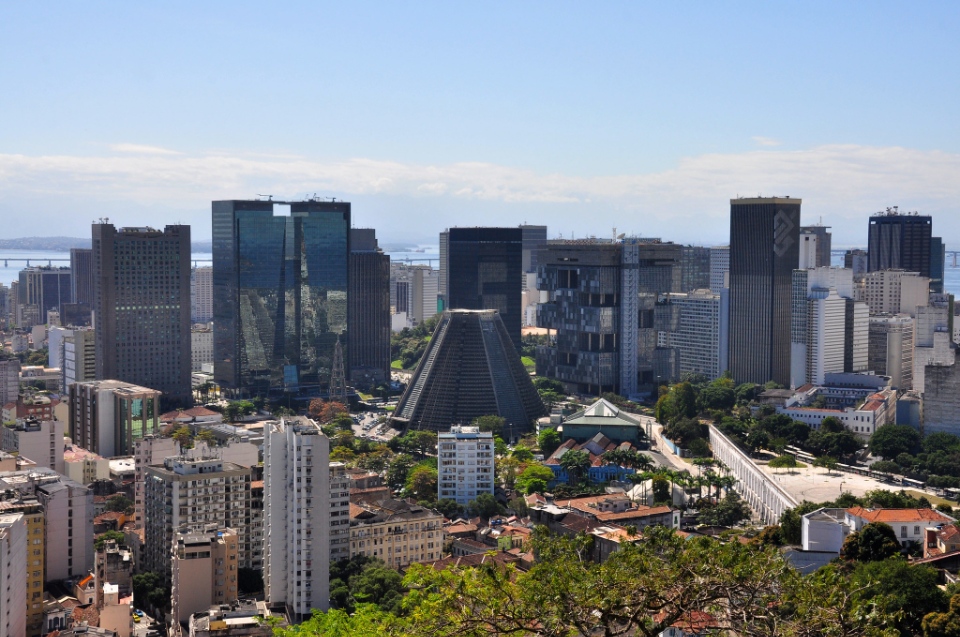
Maracana Stadium
Address: Av. Pres. Castelo Branco, Portão 3 – Maracanã, Rio de Janeiro – RJ, 20271-130, Brazil
Maracana is a major stadium and the venue for important sporting events in the world. This place stores images of Brazilian football talents through the ages, as well as a place to honor the country’s illustrious football background. This is the mecca of “soccer” in the world as well as in Brazil. The stadium is not only the largest in the world, but also a place to save unforgettable memories for Brazilian football when the national team lost to Uruguay in the 1950 World Cup final.
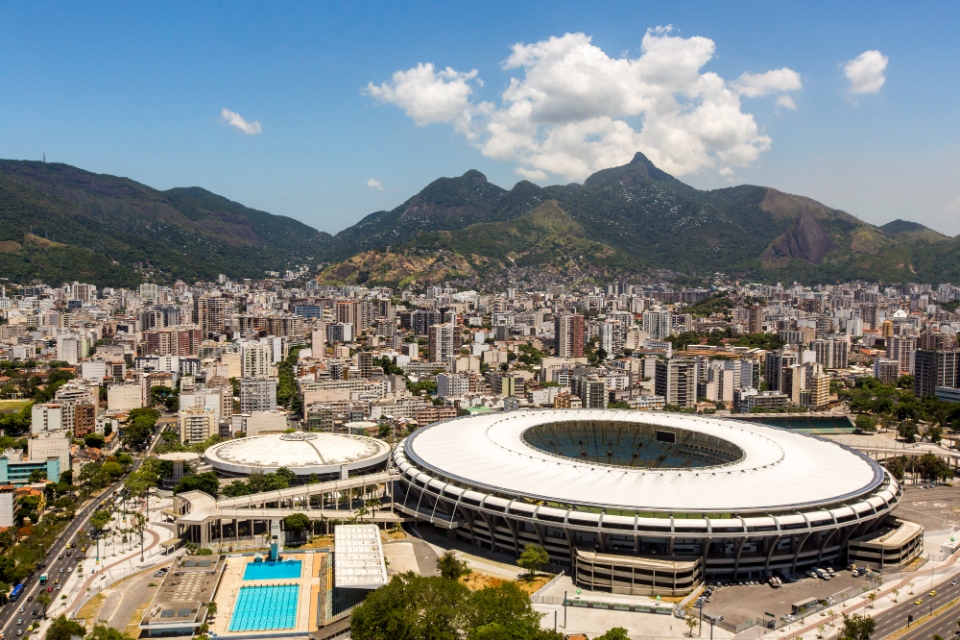
Inaugurated in 1950 when the 4th World Cup was held in Brazil, Maracana is the pride of Brazilian people in general and Rio de Janeiro in particular. This stadium has a capacity of nearly 200,000 people, but after many renovations, that number has been reduced to half. Currently, Maracana is mainly used for football matches between major football clubs in Rio de Janeiro.

Experience the cable car ride up Sugarloaf Mountain

You can take a cable car ride to go up the mountain, enjoy the panoramic view of the city located on the coast, surrounded by romantic green mountains. At the top of the mountain there are many restaurants, cafes, souvenir shops, and many benches for visitors to enjoy the views and relaxing. This is where you can watch the spectacular sunset over Guanabara Bay.

Santa Teresa Old Quarter
Peace and joy are the first impressions that visitors will feel when coming to this old quarter. At the same time, visitors will also encounter ancient churches standing firmly on high mounds, imbued with the culture of the people here.
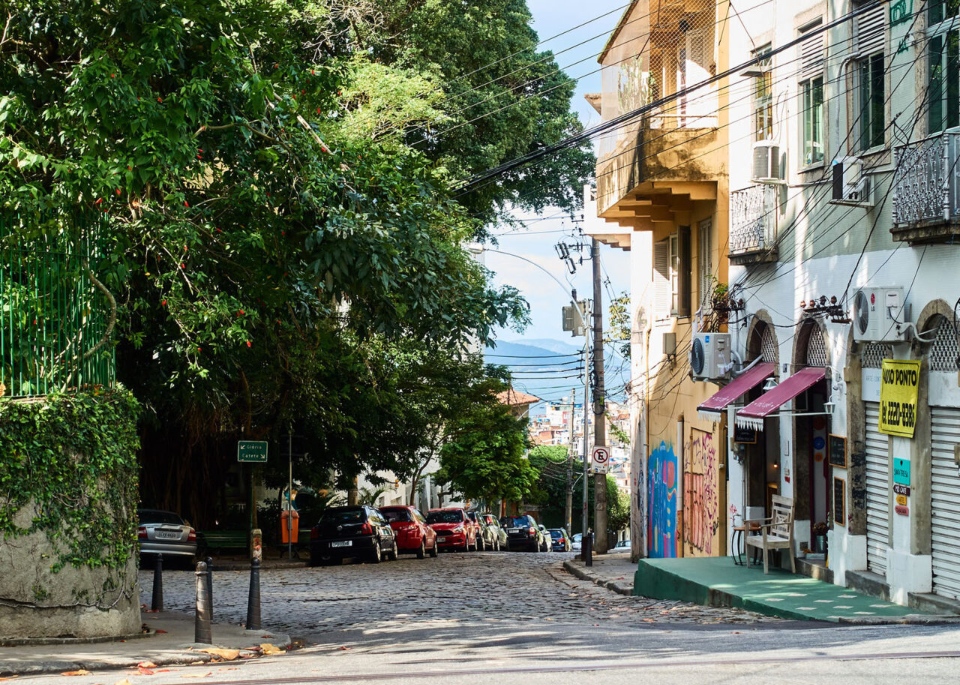
The pretty little streets paved with crushed stone or cobblestoned roads will lead visitors to the lovely old houses that are winding gently along the hillside. Most of these houses were built in the 19th century, so it always evokes a very unique nostalgia about a land rich with unique cultural features. This is also one of the place for festival lovers because the great festivals of Brazil are often held here.
Escadaria Selaron
Address: R. Manuel Carneiro – Santa Teresa, Rio de Janeiro – RJ, 20241-120, Brazil
The project started construction in 1990 with the original name of Rua Manuel Carneiro. The work is a staircase consisting of 250 steps and 125 m high. Originally, Escadaria Selarón was built by a painter and sculptor who came to live in Rio de Janeiro in 1983. He created colorful paths with ceramic tiles right in front of his house.
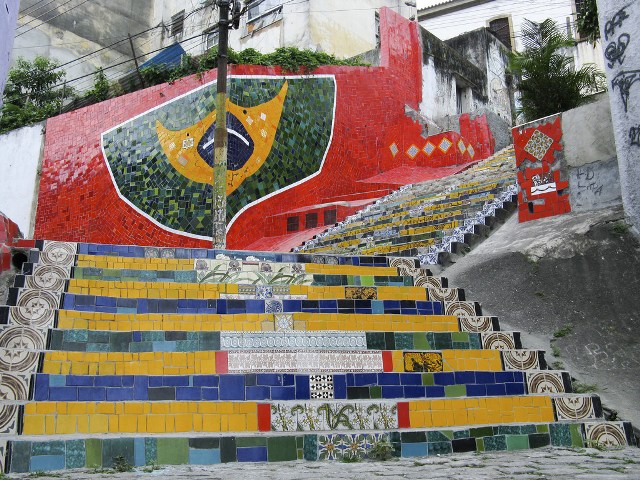
Because the neighborhood is located on a hill, most of the roads here are quite steep. Some small paths are only for walkers, so they are mainly built in the form of steps. He got money by selling his paintings and works to collect thousands of ceramic tiles from more than 60 countries around the world, mosaic for Escadaria Selarón into one giant picture.
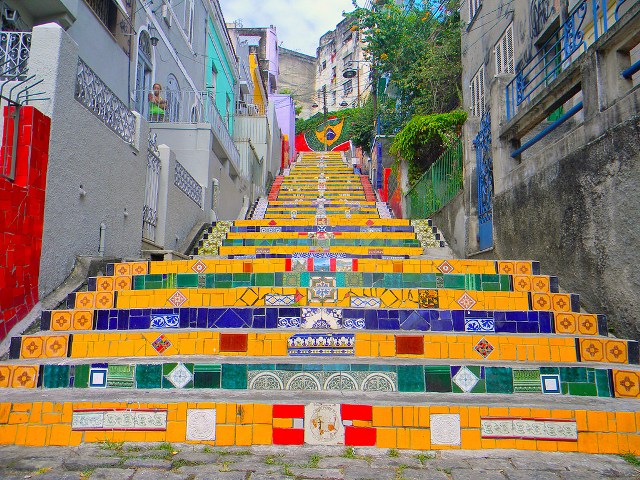
Since its completion in the early 2000s, the Escadaria Selarón steps has captured the world’s attention, appearing on the covers of famous international magazines such as National Geographic and Time. Escadaria Selarón today has become a tourist attraction, especially for photographers who are passionate about colorful, hot colors.
Rio de Janeiro Botanical Garden or Jardim Botânico
Address: R. Jardim Botânico, 1008 – Jardim Botânico, Rio de Janeiro – RJ, 22460-030, Brazil Hours: 8AM–5PM

If you are a nature lover, when coming to Rio de Janeiro, you should not miss the opportunity to come to the Jardim Botanico garden. Here, visitors will admire the wonderful natural scenery with more than 5,000 rich plant species, including those dating back to the Jurassic period. Besides, Tijuca Forest is one of the city’s largest forests in the world.
Tijuca National Park
Address: Estr. da Cascatinha, 850 – Alto da Boa Vista, Rio de Janeiro – RJ, 20531-590, Brazil Hours: 8AM–5PM
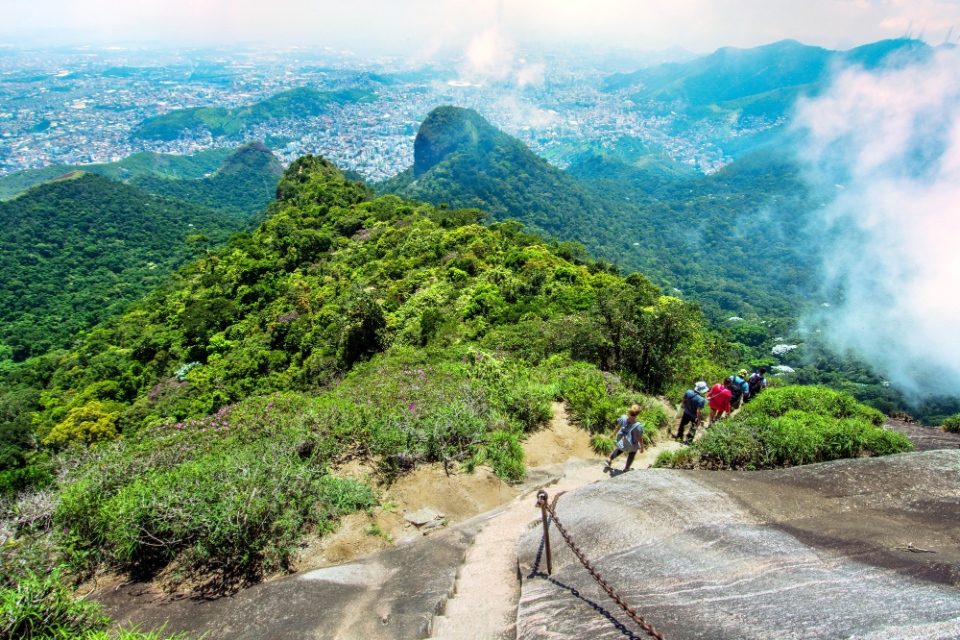
Tijuca forest is a primeval forest in the heart of the city of Rio De Janeiro and is the largest forest in the heart of the city in the world. Tijuca forest is about 120km2 wide, it will be an interesting place for those who like to walk under the jungle canopy, enjoy adventure when crossing bumpy paths, majestic waterfalls and mingle with animals…
Fort Copacabana and enjoy a cup of Brazilian coffee
Address: Praça Cel. Eugênio Franco, 1, Posto 6 – Copacabana, Rio de Janeiro – RJ, 22070-020, Brazil Hours: 10AM–7PM/Monday: Closed
Located south of Copacabana beach, the fortress is a military base built on an excess of Copacabana beach. In 1908, the Brazilian military began construction of a modern coastal defense fortress to protect Copacabana beach and the entrance to the city’s harbor.
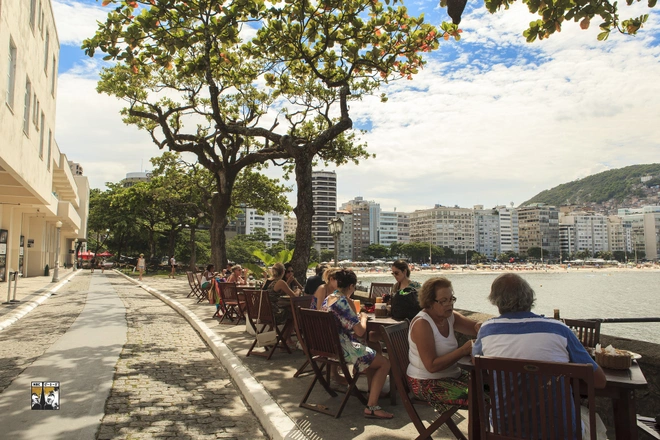
Today, visitors often come to the fortress, in addition to visiting the Brazilian military history museum, and also enjoy a romantic sunset at the beach with a cup of Brazilian coffee with a characteristic aroma. Summer 2016 Olympic Games hosted 2 long distance swimming and triathlon starting at this fortress.
Cruising around Guanabara Bay

In 1502, Portuguese explorers landed at Guanabara Bay. They mistook this for a river. It was January, so they took the name Rio (river) and Janeiro (January) to put together Rio de Janeiro for the city name. The name of Guanabara Bay is translated quite poetically: “the breast of the sea”. In addition, Rio is also nicknamed Cidade Maravilhosa – the marvelous city. Taking a cruise on the bay, visitors will immerse themselves in the modern works of Rio city such as the 13.2 km long Rio-Niterói sea bridge, Santa Cruz fortress and panoramic view of Santos Dumont airport located in the heart of the city. city.
Rio-Niterói Bridge

The longest bridge in the southern hemisphere is the Rio-Niterói, connecting Rio de Janeiro and Niteroi in Brazil, with a length of more than 13.3 km. The bridge is a typical Brazilian architecture that is ranked in the top of the most magnificent bridges in the world.
Rio de Janeiro travel blog: What to eat?
In addition to famous tourist attractions, the great food in Rio de Janeiro is also something you should not miss. The cuisine here is a unique combination of the cuisines of many famous countries such as Japan, Chile, and Spain. You can even find Vietnamese dishes such as Pho (beef noodle soup), spring rolls, braised fish…

Coming to Rio de Janeiro, you can try to enjoy dishes like Feijoada, a signature traditional Brazilian dish made from black beans stewed with meat.

Churrasco barbecue is one of the most typical dishes of this South American country. The type of meat to grill can use beef, pork, chicken marinated in spices and skewered on each skewer. You will come across grilled meat skewers stalls right on the streets, the sweet aroma seducing all visitors.
Pao de Queijo

This is a cake with a crispy golden outer shell combined with a soft inner filling made of greasy butter, condensed milk and guava powder. Pao de queijo is a very popular snack in Brazil.
Tapioca crepe
This is a popular breakfast in Brazil made from pancake shells and sandwiched inside sweet, fatty avocado and banana slices.

Some other unique and famous dishes you should try such as: Acai, Coxinhas, Brigadeiro, Pastel Frito de Frango, Feijoada, Beijinho de Coco, Creme de Papaya, Empadão, Churros, Empanada…
Rio de Janeiro blog: What to buy?
Coming to Rio de Janeiro, visitors can shop for souvenirs very typical of a South American country. Some items you should buy as a gift when traveling in Rio de Janeiro are sarongs, goiabada (guava paste) which is a preserve made simply from guava and sugar), Sugar Loaf mountain miniature souvenirs, small statues of Christ the Redeemer, “I Love Rio de Janeiro” t-shirts, a pair of authentic Havaianas Flip Flops…

Visitors can also go to the Hippie fair in Ipanema to choose from creative and unique gifts for loved ones or simply a souvenir for yourself. You can wander around the market and pick up beautiful handcrafted jewelry, clothes or bags. Be sure to look out for the weekly stalls that sell handmade boxes with wooden linings or the stalls that sell bowls and coasters made of dried beans and plastic. These will be very unique gifts!
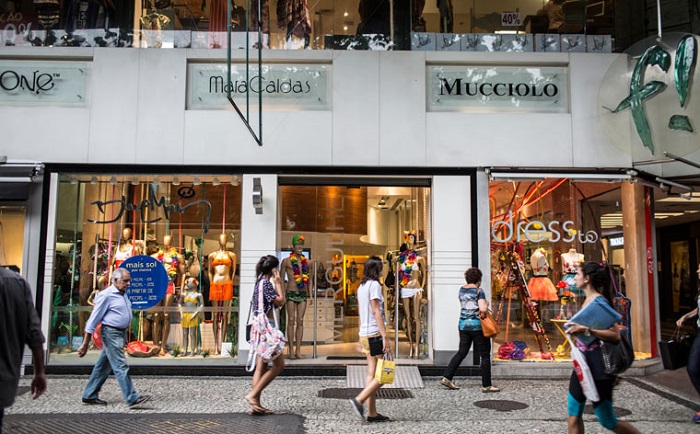
Read more: What to buy in Brazil? — 18+ must buy, top Brazilian souvenirs & best things to buy in Brazil .
Rio travel blog: Where to stay?
Below we recommend more best budget, mid-range and upscale hotels with good ratings and reviews you can refer to.
- Riale Brisa Barra Hotel ( Agoda , Booking )
- Rio Othon Palace Hotel ( Agoda , Booking )
- Miramar Hotel by Windsor ( Agoda , Booking )
- Ibis Rio de Janeiro Santos Dumont ( Agoda , Booking )
- Orla Copacabana Hotel ( Agoda , Booking )
- Hilton Barra Rio de Janeiro ( Agoda , Booking )
- Sheraton Grand Rio Hotel & Resort ( Agoda , Booking )
- LSH By OWN ( Agoda , Booking )
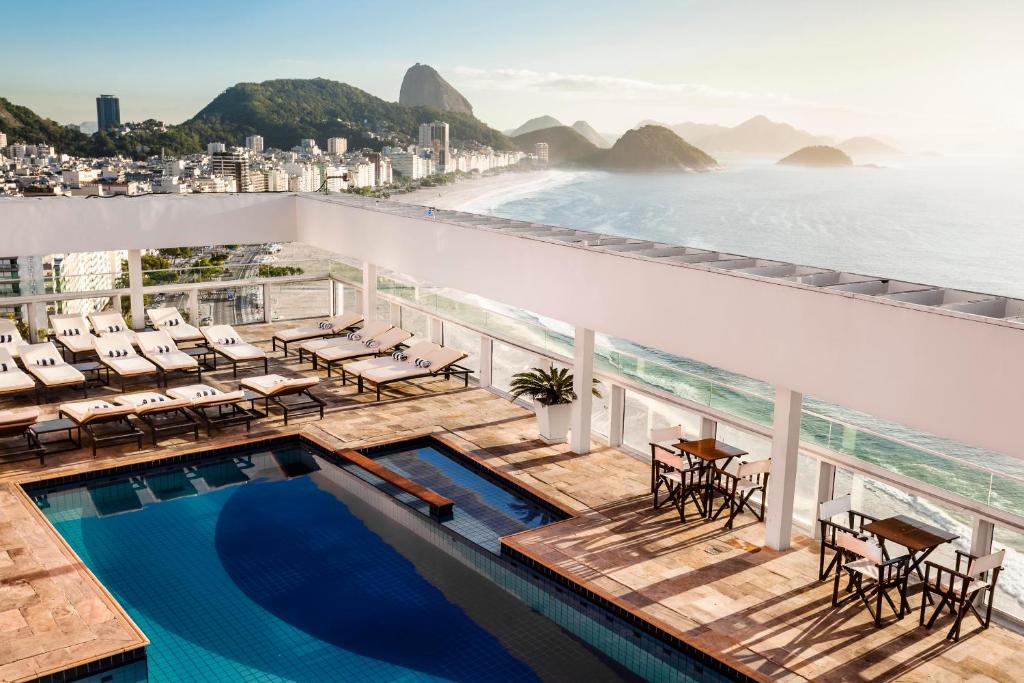
Check out more top and best hotels in Rio via Agoda.com or Booking.com .
Rio de Janeiro guide: Some things to note before traveling to Rio de Janeiro
- If possible, learn some basic Portuguese words and phrases to communicate when needed because the Rio people speak English with a bit difficult to understand. In your luggage, remember to prepare a pair of slippers or spacious shoes for comfort when walking.
- The slums in Rio de Janeiro, Brazil are also one of the interesting places to visit once when coming to Rio. However, you should be guided by a local and should not bring valuables.
- Be careful with money and personal belongings when going out on the street or in crowded places, because pickpocketing in Rio de Janeiro is quite serious.
- Copacabana has a separate bike path. If walking, you should follow the right footpath, because driving in Rio de Janeiro is quite reckless.
Some best day tours, trips, activities and transfer services, tickets in, from and to Rio de Janeiro you can refer to
- Rio: Christ the Redeemer Official Ticket by Cog Train
- Rio de Janeiro: Sugarloaf Cable Car Official Ticket
- Rio: Maracanã Stadium Official Entrance Ticket
- From Rio de Janeiro: Angra dos Reis Boat Trip with Lunch
- Rio: Christ the Redeemer, Sugarloaf, & Selaron Day Tour
- Rio De Janeiro: Half-Day Rocinha Favela Walking Tour
- Rio de Janeiro: Sunset Sailing Tour
- Rio de Janeiro: Favela Santa Marta Tour with a Local Guide
- Rio de Janeiro Hang Gliding Adventure
- Rio de Janeiro: 30 or 60-Minute Highlights Helicopter Tour
- Rio de Janeiro: Carnival 2023 Samba School Parade Ticket

Happy traveling! Read more Brazil guide here .
Related articles
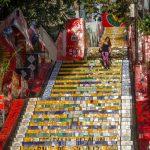
RELATED ARTICLES MORE FROM AUTHOR
Luxembourg travel blog — the fullest luxembourg guide for a great trip for first-timers.

Kuala Lumpur itinerary 5 days. How to spend 5 days in KL with friends

Seoul autumn foliage 2024 forecast — The timeframe & 13+ best places to see autumn leaves in Seoul

Busan fall foliage forecast 2024 — When & 6+ best places to visit in Busan during autumn

Jeju fall foliage forecast 2024 — The timeframe & 6+ best places to visit & top things to do in Jeju autumn foliage season

Taiwan fall foliage forecast 2024 — When & 9+ best place to see autumn leaves in Taiwan
Editor picks.

Hamburg travel blog — The fullest Hamburg travel guide to the...

POPULAR POSTS

What to buy in USA? — 17+ must buy in USA...

What to buy in Korea? — Top +23 cheap, famous &...

Must buy souvenir in Taiwan — Top 17+ most famous, cheap...
Popular category.
- Inspiration + Guide 1532
- Trip Inspiration 468
- Food + Drink 223
- Thailand 217
- Coasts + Islands 202
- South Korea 179
- Vietnam 172
- Travel Photos 144
- Work for Us
- Terms & Conditions
- Privacy Policy

Welcome to the official site of Costa Rica
Welcome to Costa Rica! This beautiful country is known for its stunning beaches, lush rainforests, and incredible wildlife. Whether you’re looking for adventure or relaxation, Costa Rica has something for everyone.
Some of the top attractions include Arenal Volcano, Manuel Antonio National Park, La Paz Waterfalls, Papagayo Peninsula, Tamarindo beach, Rio Celeste, Monteverde Cloud Forest and Corcovado National Park.
You can enjoy activities such as surfing, snorkeling, fishing, ziplining and hiking. Costa Rica is also home to many unique and diverse animal species such as sloths, monkeys, birds, turtles and more. We hope you enjoy your stay!

The Costa Rica Essentials
Essential Costa Rica is about promoting organic ingredients, unspoiled nature and authentic experiences.

Fill your calendar with the most wonderful natural and wildlife events.

Sun and Beaches
Costa Rica occupies a privileged spot with beaches in the Caribbean Sea and the Pacific Ocean.

Costa Rica is a land of volcanoes, rainforests and cloud forests, huge waterfalls and mighty rivers.

If stress is a part of your daily life, Costa Rica is the cure.

Costa Rica has a great place to experience nature’s wonders with your children; the country is a must for families!

Costa Rica is considered one of the most bio-diverse regions in the world.

Costa Rica in English, means rich coast. Every cruise ship visiting Costa Rica understands why.
Costa Rica has a wholesome environment and is an excellent place for families.

The richness of Costa Rica stems from the cultural diversity of its people.

Honeymoon & Weddings
Costa Rica is waiting for you to live this experience.

Where to Go?
Located on the central Pacific coast, the Puntarenas region extends from Punta Conejo south to Puerto Caldera to the mouth of the Bongo River. The region’s rich coastline overlooks small islands, inlets, beaches and beautiful natural wonders. The port town of Puntarenas serves as the center of the region and is home port to a ferry that carries visitors over to the tip of the Nicoya Peninsula.

South Pacific
The combination of breath-taking white-sand beaches, sweeping mountain views and an ideal tropical climate has made Guanacaste one of Costa Rica’s most popular regions. It boasts many of the country’s popular beaches, including Playa del Coco, Playa Flamingo, Playa Conchal and the Papagayo Peninsula. By day visitors can challenge themselves with a surf lesson, cool off under a waterfall at Rincón de la Vieja National Park, discover the craters of an active volcano with the same name and more before enjoying the active nightlife in Tamarindo.

Northern Plains
Recognized as home of Arenal Volcano National Park, which boasts 75% of Costa Rica’s bird population, the Northern Plains present endless activities for visitors. Excursions range from hiking and waterfall rappelling to canopying and exploring via a hanging bridge tour. Those looking for activities on the water will find that Lake Arenal is an ideal location for canoeing, fishing and kite surfing.

Central Valley
Those in search of cultural and natural attractions will find both in the Central Valley region. Home to the destination’s capital city, San José, many of Costa Rica’s most popular museums can be found in this urban setting including the Gold Museum, Jade Museum, National Museum and Children’s Museum, in addition to the architectural jewel of San José, the National Theatre.

Central Pacific
Beautiful beaches, wildlife sanctuaries, lagoons, rivers and waterfalls make the Central Pacific region an ideal destination for visitors in search of variety. The region stretches from the city of Puntarenas to Dominical de Osa and is made up of some of Costa Rica’s most visited areas including Monteverde, Quepos, Jacó, Bahía Ballena and Manuel Antonio. The region’s climate creates a unique landscape that transitions from tropical wet forest to tropical forest to tropical dry forest, providing the opportunity to observe a wide range of plants and animals.

The diverse coastline of the Northern Caribbean region attracts anglers, naturists and water enthusiasts in search of unique experiences. The North Caribbean region is famous for its interconnected canals and for Tortuguero National Park, where visitors have the opportunity to witness green turtles nesting. Limón City, the largest city on the country’s Caribbean coast, is perched in the center of the coast. The Southern Caribbean boasts some great beaches and picturesque parks, which are complemented by the area’s inviting culture.
Planning your Trip to Costa Rica
Suggested itineraries
Accommodations
Restaurants
Other Activities
Local Travel Agencies
Travel Tips

Costa Rica Blog
Latest news and articles about costa rica.

Costa Rica National Parks
Explore our world famous national parks.

Costa Rica's traveler tips
First hand information for your dream vacaction, #essentialcostarica, share your experience, .

The Unknown Enthusiast
22 Rio de Janeiro Travel Tips: Things to Know Before Going to Rio in 2024
Heading to Rio soon? You’re in luck! I’ve got the best travel tips for Rio de Janeiro to prepare you for a great vacation in Brazil.

Our six days in Rio de Janeiro were really like a dream – so many interesting things to see, do, and eat. I was really blown away by just how much I loved the city! For me, I think it was a combination of loving a bustling city, but also loving nature and beautiful viewpoints – and Rio delivers both in such a unique way!
However, being a country in South America, there are a lot of differences between traveling in Rio compared to traveling in the United States.
In this Rio de Janeiro travel guide, I want to talk about the best travel tips and important things to know before going to Rio de Janeiro, based on our experience there, and the advice given to me by my brother, who lived there for several years.
This post may contain affiliate links or refer a friend links. When you buy through these links, I may earn a bonus at no additional cost to you. Thank you for your support!
Rio de Janeiro Travel Tips
You’ll be on your way in no time! Let’s get into my 22 most important travel tips for a Rio de Janeiro vacation:
1. Purchase an E-Sim Card Before You Go
I’ve recently found a new way to get inexpensive, high speed data while traveling (something I love to have but has been annoying, expensive, or ineffective to procure).
Instead of purchasing a local SIM card (or renting a mobile hotspot) when arriving in a country, I’m now using an e-sim card from Airalo. I’ve used a lot of different methods in the past to get data when traveling internationally, and let me tell you, buying an e-sim card is EASILY the most affordable, fast, and convenient option.
E-sims are a relatively new thing, so before you purchase, you’ll need to contact your cell phone provider and have them unlock your phone for e-sim use.
Before you leave on your trip, purchase the amount of data that you need from the Airalo website . Then download the app, and when you arrive, toggle on the e-sim card, and that’s it! You can check how much data you’ve used in the app, and top up with more if necessary.
One of the most important things to know before going to Rio de Janeiro are some safety tips for the city. Safety was a big concern for us as we prepared to visit Rio. I’d often heard Rio described as an unsafe city, and I had talked extensively to my brother, who lived in Rio for a couple of years, about safety concerns.
Honestly, I had a decent bit of anxiety the 2 weeks before we left about our vacation. I was extremely worried about our phones getting snatched out of our hands, getting pickpocketed, getting my purse slashed, getting mugged, and just generally running into a lot of unsafe or unsavory situations.
I will say that we exercised much more caution than we normally do when traveling in Rio, and were a lot more aware than usual about our surroundings (of course, we’re always taking precautions and being aware, but it was definitely heightened in Rio), but we almost always felt perfectly fine and safe as we toured the city .
Still, learning about what precautions to take is an important thing to know before going to Rio de Janeiro and we’ll cover several safety topics in this Rio de Janeiro travel guide.
These are the safety travel tips for Rio I would recommend:
2. Avoid the Favelas…Unless You’re in a Tour
Favelas are crowded, very poor neighborhoods, usually built up into the hillsides of Rio. Favelas are all controlled by gangs or the mafia, where they sell drugs and machine guns are carried openly.
While doing a guided tour of a favela is totally safe (and was a really interesting and positive experience in Rio, I highly recommend it – read our full review of it here ), and the favelas in general can be relatively safe during the daylight hours, I would definitely still avoid them if you aren’t with a tour.
Gang invasions, shootouts, or police raids could take place during any time, day or night, and you’d have no idea it’s coming. The tourist favelas avoid this during the day because of the tourism, but any other favela is free game any time any day. So, outside of a tour, just play it safe and avoid the favelas!
My recommendation: Tour of the Dona Marta Favela (I would highly, highly recommend doing a guided favela tour during your time in Rio – it was safe and so interesting)
3 . Be Off the Streets After Dark

In general, don’t be walking on the streets after dark (which is about 6pm year round). As an international tourist, a good rule of thumb is if you need to go somewhere at dark, take an uber or taxi, or the metro if you’re walking less than a block to/from the stations to your destination.
Now, if you are in an area that is well lit and well-trafficked with people, then that is probably okay to be out and walking around. For example, one night after dinner we wanted to walk several blocks to a grocery store around 9pm.
At first, I was hesitant to be out walking, but then saw that our route was along a road with lots of cars, lots of light, and many other pedestrians out and about. That was a fine situation.
Conversely, another night we thought we’d do the same thing because it was only about a 10 minute walk to the restaurant we were going to. This time though, there was very little traffic and very few pedestrians, although it was well-lit and not that late (only around 7pm).
I felt like this situation was less safe and in retrospect would’ve gotten an uber (although we did walk right past the police precinct, so that did give some peace of mind).
4. Be Aware of Pickpockets and Phone Snatchers
Be very aware of pickpockets (or thieves snatching your phone out of your hand), particularly in areas like Copacabana, markets, or other touristy spots. If you are in a taxi or uber and your window is down, be aware that passing pedestrians, bikers, or men doing sales in the street when cars are stopped will sometimes grab phones right out of your hands in the car.
In general, just be careful with your phones. Ideally, don’t pull them out on the street. However, because we were always wanting to take pictures, we had our phones out a lot, and here’s what we did to try to be safe:
If we were walking around, I often kept two hands on my phone and kept it in front of my body. I also put a hand wrist strap lanyard on my phone case that went around my wrist, so it was somewhat attached to my body.
We tried to pay attention to our surroundings and not have the phones out conspicuously when there were people right by us.
As we were touring around Centro in particular, we saw a lot of police cars/officers out around the area, just parked and monitoring the area. This is for safety reasons, as a deterrent to crime, and we felt more secure walking around with that security present.
5 . Be Careful of Hiking Trails and Paths
Gangs will sometimes take over nature trails, and for a while the path from Parque Lage to the Christ the Redeemer statue had a whole bunch of muggings, so it was definitely a place to avoid.
When we visited Parque Lage, we noticed that there was a police officer at the trailhead, so that trail may be safer now, but I would still exercise a lot of caution if you plan to do any trails, never be out after dark, and ideally be in a group.
6. General Awareness
When traveling to Rio de Janeiro, it’s a good idea to generally be aware of your surroundings, keep a close eye (and hand) on your belongings, and just pay attention to what and who is around you.
Now, with all that said, I don’t think you need to be scared of Rio (the way I kind of was, haha). For example, I had read a couple of accounts where people said they didn’t go more than 10 minutes without running into a group of people or a scenario where they felt uncomfortable.
That was not our experience. In fact, we generally felt very safe as we walked around and toured Rio, particularly because we were following our safety guidelines. And the few times I did feel a little uncomfortable, we were able to quickly get somewhere I did feel safer.
I think that one of the good things to know before going to Rio is that, despite its reputation, with a few precautions you can have a safe and enjoyable trip.
Be situationally aware, have a plan of how you will get around and where you will be, and follow the above suggestions to maximize your chances of a great, safe trip.
7. Don’t Forget Travel Insurance
Securing some travel insurance is an important part of prepping for any international trip – you never know when something might happen, and your regular insurance generally won’t cover you overseas. Costs for a medical emergency on vacation can add up extremely fast, so it’s just better to be safe than sorry.
I felt a lot of peace of mind booking some travel insurance for Rio – I knew that even if something happened, we would still be covered.
I like booking insurance at Insure My Trip , as they offer a variety of plans with different coverages to choose from, so you can find the right option for you. Plus, they have great customer support if you need help before, during, or after your trip.
>> Check rates and get a no-hassle quote at Insure My Trip here!
8. Toilet Paper
One of the very important things to know before going to Rio de Janeiro is that the sewage system in Brazil (like many countries in south and central America) is not set up to handle toilet paper.
Instead of flushing it, you just stick it in the bathroom trash can.
9. Electricity
Brazil uses two types of electrical plugs: types C and N. Plug type has two round pins, and is also commonly used in a lot of Europe. Plug type N has two round pins plus a grounding pin. If you’re traveling to Rio de Janeiro from the US, you will need an adaptor to charge your electronics.
👉 My recommendation : I always travel with and recommend this type C plug adaptor set – it’s an inexpensive price for a 3-pack.
Brazil operates on a 127/220V supply voltage and 60Hz. We did not need to use any electrical converters for our electronics in Brazil (just the adaptors), as all our electronics are dual voltage rated. Most electronics these days are dual-rated, but if yours are not and you’re traveling from the US, you’ll also need a converter.
10. The Architectural Style of the City
Architecturally, Rio de Janeiro has a lot of variety. Centro is the historic center of the city, and you’ll see a lot of 19th century buildings with pretty design features.
Rio was the capital of Brazil for a few centuries and was the hub for the Portuguese crown before Brazil gained its independence from Portugal, So a lot of the architectural style comes from the European influence from Portugal during that time.
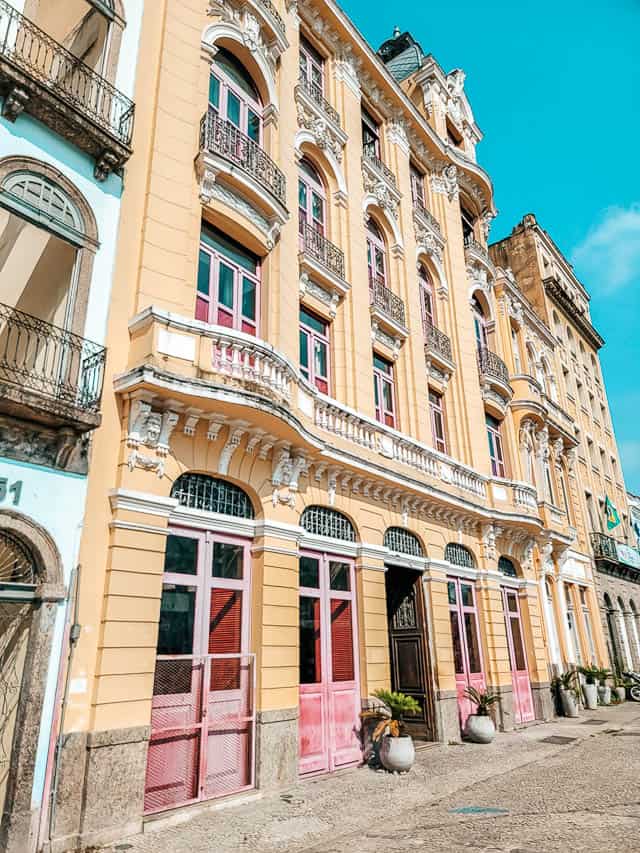
The Theatro Municipal was based off of the theater in Paris, for example. But there are also modern, futuristic designs as well, in the Museum of Tomorrow and the Metropolitan Cathedral.

Throughout Rio you’ll find colorful painted buildings.
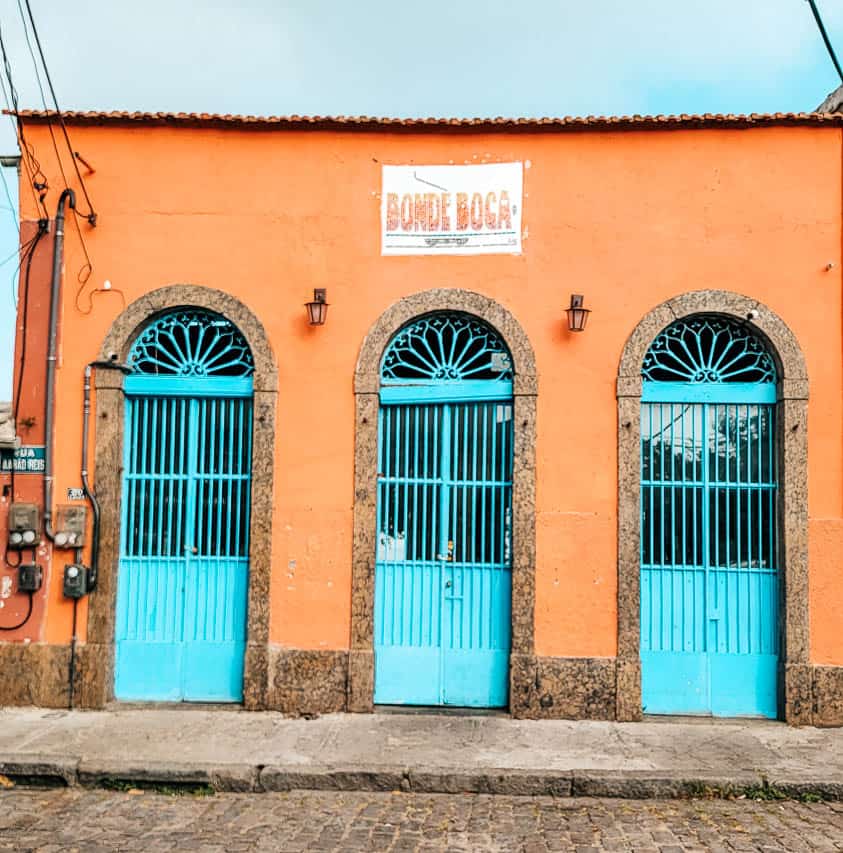
You’ll also find plenty of stark buildings or non-descript high rises.
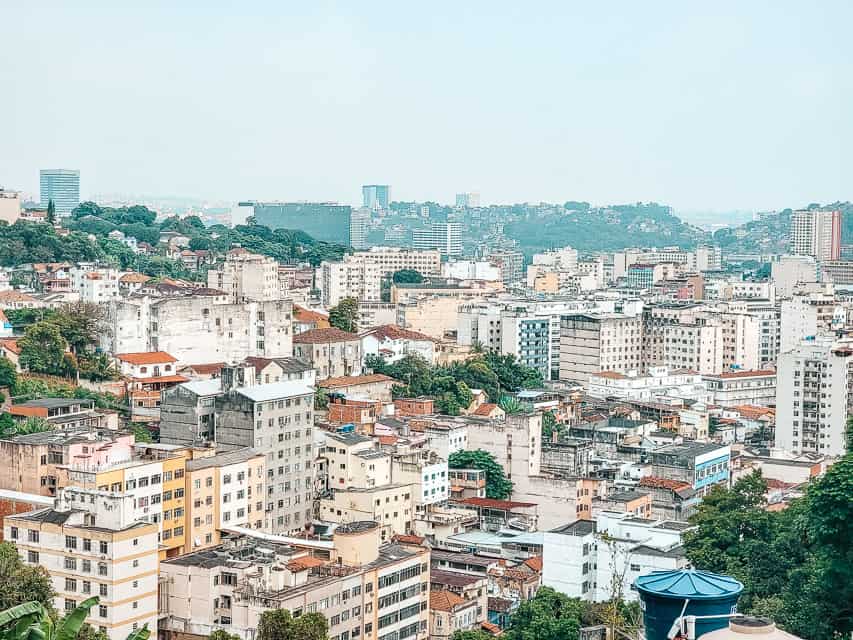
There are areas with a lot of graffiti, and some buildings have barbed wire around the exterior walls.

The Santa Teresa neighborhood is unique in Rio, with a very Bohemian vibe, tons of street art and the trolley that winds its way to the top of the hill overlooking the city.
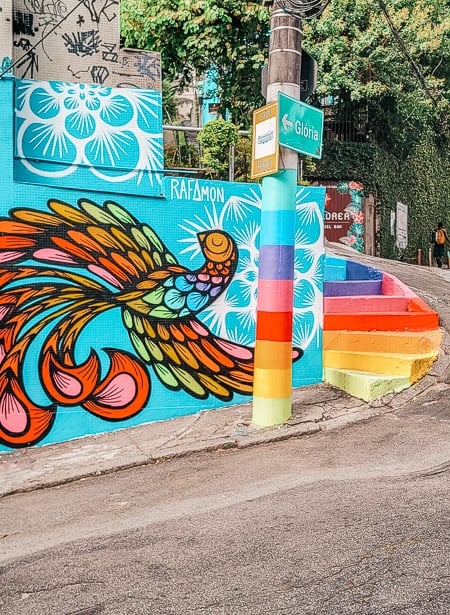
The favelas have their own style as well, with small, squat, painted houses stacked closely together as they climb up a hill.

And be sure to look down, too. There are frequent cobblestone streets and tiled sidewalks to enjoy.

You really get a range of so many styles in Rio! One of my favorite travel tips is to pay attention to all the different types of architecture you’ll see in Rio!
11. The Size and Geography of the City
One of the things to know before you go to Rio de Janeiro is that it is a very big city (over 450 square miles), and it feels particularly big due to its geography. Rio is right on the coast, but the coastline isn’t straight; you have curves and jutoffs and sudden turns.
Additionally, there are a TON of hills and mountains in the city, and the city just builds around (and sometimes up!) them.

So, you do have some navigating around hills to get places, or driving up the mountain to visit certain spots. The twists and turns (and density of the city) can make for slower transit at times.
12. Go to a Futbol Game… with a local!
Brazilians LOVE their futbol (soccer) and Rio de Janeiro has one of the biggest and most famous stadiums and futbol rivalries in the world. Going to a game at the Maracana stadium was high on our Rio bucket list, and I’m so glad we were able to do it.

My biggest travel tip for going to a futbol game in Rio is to go with a local! However, I will say, we got kind of lucky for getting to go. Despite our many attempts, we could not find a game schedule online, or information about where and how to get tickets.
We ended up just stumbling on a situation in Rio where a new, local friend we had met offered to let us come to the game with him, and he would help arrange the logistics.
This ended up being one of the craziest and most exciting travel experiences we’ve ever had. We joined up with all the friends of this Brazilian and the whole group went into the hardcore fan section that sits behind the goals.
People were packed in tight, standing up singing and cheering literally non-stop, drums beating, flags waving. It was a whoooole vibe, and we loved it.
Basically, I would highly recommend you go with a local, who will take you to the pre-party outside the stadium, and help you have the best experience during the game. Good news is this is an “excursion” you can actually arrange ahead of time! ⚽ Check prices and availability for this futbol match experience here!
13. Brazilian Coinage
Brazil’s currency is the Real, which is pronounced “hay-ahl”. The plural of real (reais) is pronounced “hay-ize.” The emphasis is on the last syllable (the “ahl” or “ize” part).
At the time of writing, one US dollar is worth about 5 reais. Most places around the city take card, but I would still plan to have cash on hand for things like bus fares, street food, or taxis.
14. Withdrawing Money
Be careful at ATMs on the street and exercise caution if there are other people around.
I would recommend withdrawing some money at the airport, but find the ATMs, not the exchange centers. We did try the exchange centers by baggage claim, but one only took cash (we only had our debit cards), and the exchange rate from the other one was basically highway robbery.
Quick Travel Tip : At the airport exit doors where you can get a taxi into Rio, there are some escalators that will take you up a level, and at the top there are some ATMs. These machines will give you a much better exchange rate, and you can use your debit card instead of cash. You can ask any employee or taxi driver where the ATMs are.
General Travel Tip: Whenever traveling in a foreign country, always have cashiers run your credit card in the local currency, not dollars (or whatever your home currency may be).
Sometimes you are given the option to choose between the two currencies on the screen if you are inserting the card yourself. You will get a better exchange rate by having your bank convert it, not the store.
Wondering what it costs to visit Rio? Check out our detailed Rio de Janeiro trip costs post here !
15. Best Areas to Stay in Rio de Janeiro
Figuring out the best area to stay is an important part of planning a trip to Rio de Janeiro, since, as we mentioned earlier, the city is very spread out, and some areas of the city are decidely more safe than others.
There are a few good areas that I would recommend to stay in Rio, based on where we stayed, what we experienced there, and other extensive research.
➡️ Santa Teresa
This was the area we ultimately ended up staying, and I was extremely happy with this choice. Santa Teresa is a quiet, artsy neighborhood that extends up a hill overlooking the city. There was a ton of street art and brightly painted houses in Santa Teresa, and the area felt very residential, and safe during the daytime hours.
The traffic was never bad in this neighborhood, and it was a quick and easy (and cheap) ride down into Centro, where a lot of sites are.
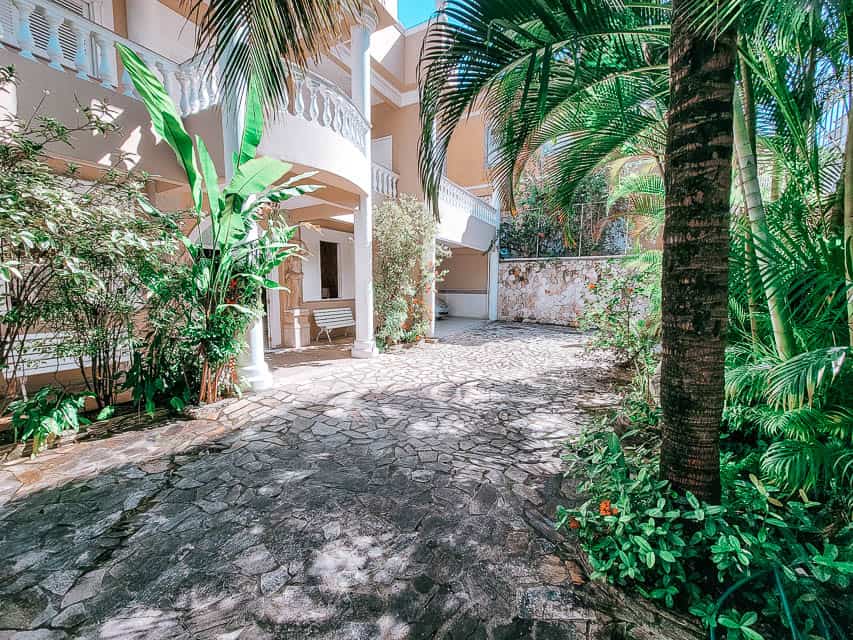
Recommended Hotel: Villa Franca I can highly recommend Villa Franca in Santa Teresa. It had a secure entrance, a beautiful courtyard, and a very relaxing lobby entrance that really felt more like the living area of a villa than a hotel reception area. The rooms were large and decorated nicely, and, very importantly, the wifi and air conditioning were strong, and the rooms had a good size mini-fridge. Check current rates for Villa Franca here!
➡️ Centro
Centro is a great area to stay in. It is more the “business” district of Rio, but it also has a lot of buildings that are beautiful, historic, and/or colorful.
There are a TON of things to see and do in Centro, and so staying in this area will be very convenient, as you’ll be able to walk to a lot of spots. It is a safe area, especially during the day. I would be careful and exercise caution at night, as there are some areas with more homeless people.
Lapa is the neighborhood right next to Centro, although we found the Lapa area to be just a little bit more dilapidated, and is known for having more crime. So while you can and should visit the sites in Lapa, just exercise a little more caution here.
Recommended Hotels: Windor Asturias Hotel This is a very comfortable hotel in the Centro district, not far from the Lapa attractions. It is within walking distance of many sites in the area! In addition, the hotel has a rooftop bar and pool, with beautiful views out over the bay. You’ll enjoy an extensive breakfast buffet every day, and of course, comfortable rooms and a helpful staff. Check current rates for the Windsor Asturias Hotel here!
➡️ Copacabana and Ipanema
Copacabana and Ipanema are the best areas to stay in Rio de Janeiro if you want to spend more time at the beach. Copacabana is a little more centrally located, while Ipanema is generally considered a nicer beach.
However, we found the beach at Copacabana to be really nice! I had heard that it was a pretty crappy beach, but I think it got cleaned up quite a bit before the Olympics in 2016. The water was nice and the sand, while there was some trash here and there, did not feel particularly dirty or gross. I would hang out at Copacabana again, no problem.
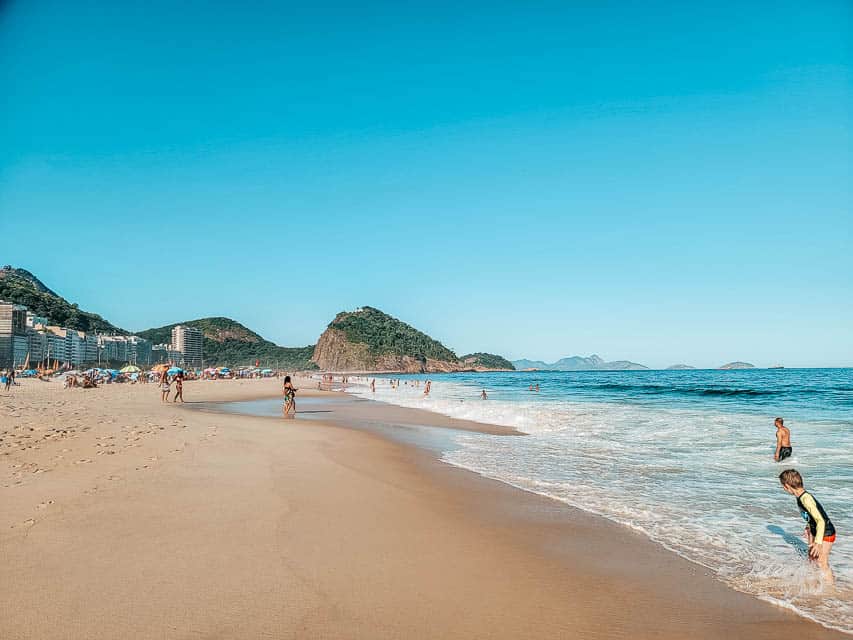
Ipanema is considered to be a more expensive area in the city, and also generally considered to be a little nicer than Copacabana.
Note that we did find the traffic to be heavier in this area (but as noted above, it is on a metro line, which is a plus).
Recommended Hotel in Copacabana: Velinn Reserva Copacabana The Velinn Reserva Copacabana is in an awesome location if you are wanting plenty of beach time, as it is just a couple blocks from both the Copacabana and Ipanema beaches. The hotel is clean and the staff is friendly, and the rooftop breakfast is a big highlight. Check current rates for the Velinn Reserva here!
➡️ Botafogo
Botafogo is a lively area situated between Copacabana and Centro. It’s a good, central location and generally considered a safe area to stay and visit in Rio. This neighborhood sits right on Guanabara Bay and at the foot of the super cool Sugar Loaf mountain.
We came to this area a few times for dinner and really liked it!
Recommended Hotel in Botafogo: O Veleiro Bed and Breakfast I love the cozy interiors in this B&B and the absolutely gorgeous garden courtyard area (with pool!). It’s a perfect retreat from the hustle and bustle of the city. The bedroom design feels like you’re visiting an old friend in Rio instead of staying in a hotel, and the views over the hills are excellent. Make sure you book a standard room (not economy) for the AC. Check current rates for O Veleiro here!
➡️Leblon
Leblon is the best area to stay in Rio de Janeiro if you want to be close to the beach, but in a nicer and quieter area than either Copacabana and Ipanema. The downside – it is a pricier area and farther away from many attractions. It can be a beautiful spot, though!
Recommended Hotel in Leblon: Sheraton Grand Rio Resort and Hotel If you’re staying in Leblon, it’s probably because you want that upscale beach experience, and the Sheraton Grand Rio definitely delivers. With an absolutely gorgeous pool and lush grounds directly overlooking Leblon Beach, you’ll enjoy luxury beach and pool days, with several on-site restaurants and spacious rooms with balconies overlooking the beach. Check current rates for the Sheraton Grand Rio here!
16. The Language
Portuguese is the official language of Brazil, and unlike many other tourist destinations in Europe, not many Brazilians speak English, even in tourist-facing locations. While there were some people who spoke English, most people did not.
We did learn a few Portuguese words and got along fine, but I do wish we had learned a few more common words and phrases before traveling in Rio de Janeiro (please, thank you, hello, goodbye, where are the bathrooms, I don’t speak Portuguese, the numbers 1-10, etc are some good ones).
Knowing some basic phrases before you go is a really useful step for visiting Rio de Janeiro.
I would also try to look up and practice pronunciation of any words you’ll learn, because pronunciation in Portuguese is not always how you think it’d be (we were really surprised with some of the pronunciation rules!)
A big travel tip for Rio : Plan to use Google Translate a lot!
Despite a big language barrier, we found that people were still very nice and willing to work with our pointing/miming/google translating. Most of the Brazilians we interacted with were extremely friendly!
17. Weather in Rio de Janeiro
Weather in Rio is either hot or VERY HOT. As Rio de Janeiro is in the southern hemisphere, seasons are opposite the US, with December being summer and June being winter.
Thus, hottest months in Rio are December, January, and February, with temperatures almost always above 100 degrees Fahrenheit (plus humidity!) Coldest months are June, July, and August, with average highs in the upper 70’s.
The rainy season is from December to March and the dry season from May to October, with April and November being transitional months. During the rainy season, you can either get rain showers in the afternoon (the kind of rain very common in tropical areas) or you can get all day downpours.
When we visited in the middle of March, the forecast showed high chances of rain and thunderstorms every day we would be there, but we ended up barely even having any clouds in the sky and no rain at all.
The average relative humidity stays very constant throughout the year, at about 78 to 80%. This is EXTREMELY humid!

18 . What to Wear in Rio de Janeiro
One of the big travel tips for visiting Rio de Janeiro is to plan on wearing wickable, breathable fabrics as you explore the city.
In hot weather, I prefer wearing breezy dresses (less things to stick to my body!). These are the ones I wore in Brazil:

This is the same dress in two different prints . I love it so much! It’s light and airy and perfect for Rio.

This red dress is amazing – it’s flowy and I’ve worn it all over the world. It’s available in a ton of colors.
This blue dress was a new purchase and I was so happy to inaugurate it in Rio.
A few other travel essentials for Rio include:

Super comfortable sandals : These are THE perfect travel sandal – cushy and with arch support, and feel great right out of the box. I have the “gold cork” option. My feet are always so happy in these shoes. Definitely worth the money!

Faux leather white sneakers : While you should break them in before your trip (ask me how I know that…), once broken in, they are a great walking shoe for long travel days. I’ve been extremely happy with these shoes.

Don’t forget to put on sunscreen everyday! The sun is intense in Rio, even if you’re not at the beach. With my acne-prone skin, I always wear t his sunscreen for sensitive skin , but Matthew likes using this sunscreen stick .

Portable Power Bank : This is an essential piece of gear for any travel day. You’ll certainly take plenty of pictures and videos as you explore Rio, and you don’t want your phone to die! This power bank charges 4 times and tells you the exact percentage of power left in the bank.
19. Tipping

Tipping is not expected or customary when traveling in Rio de Janeiro. A tip is already included in the bill.
20. Bottled Water vs Tap Water
One very important thing to know before going to Rio is that while the cleanliness of tap water in Rio has come a long way, it is still not guaranteed safe to drink. (We did use the tap to brush our teeth, and had no problems).
Bottled water is easy to find around the city, as there are stands, or even just people with a cooler, set up all over the city.
A more environmentally (and cheaper) option is to bring and use a water bottle with a built in filter, as you can refill from any faucet (or even a lake or stream) and have safe drinking water.
>> My recommendation : The Sawyer Filtered Water Bottle This bottle holds a good amount of water (34 oz) and is one of the absolute best and highest-rated water bottles. It filters out 99.99999% of bacteria and protozoa, and 100% of microplastics!
21. Sample Local Cuisine

Rio de Janeiro (and Brazil in general) has some unique and delicious cuisine that you should definitely try when visiting the city. Yes, the mainstay of Brazilian food is rice and beans, but dang those rice and beans are gooooood!
Brazil also has an abundance of unique, tropical juices, the most juicy pineapples I have ever tasted, and the most succulent, juicy barbecue I’ve ever had the pleasure of eating. And definitely don’t forget the pão de queijo!
>> Need some tips on what to eat in Rio? Get all the details on foods to eat and restaurants to try in Rio de Janeiro here!
22. How to Get Around
Having a plan for how to get around is another one of those important things to know before going to Rio. Thankfully, there are a lot of possibilities for transportation, and they are all very affordable.
Attractions are pretty spread out around the city, so we had to get transportation several times a day.
➡️ Metro

Rio’s metro system is very nice. One ride costs R$5 ($1), which is good for transfers within the metro system. I will say that the metro system does not go everywhere in the city, which is a big limitation.
But if you are close to a metro line, the metros are air-conditioned and clean, and it is a cheap, convenient, fast, and safe way to get around the city.
We only ended up taking the metro twice, as our hotel in the Santa Teresa neighborhood was not really close to any metro station.
However, if you are staying in Copacabana, I would definitely take the metro more frequently, as traffic seems to be worse in that area, and there is a line that takes you directly between Copacabana and Centro, where a lot of attractions are.
You can buy a ticket from the kiosks at the station. You can either buy a single ticket, or a longer term pass.
➡️ Bus
We only took the bus once, but it is another cheap and easy way to get around. The bus has many more routes than the metro does, but do beware – grab and run situations can happen on buses more, so just watch your stuff and phones closely.
We did find that taking the bus down from the Dona Marta viewpoint was necessary, as Ubers do not like to come all the way up to the summit for pickup. For this viewpoint, we took an Uber up, and then walked about 20 minutes back down the mountain to the bus stop, and took the bus back into the city.
You can pay with cash for a bus ride. One ride costs R$4.05 (<$1).
Quick Travel Tip: In Rio, when waiting for the bus, you’ll need to wave it down to stop for you.
➡️ Uber

We took a LOT of Ubers during our week in Rio – 30 to be precise. With an average cost of $4.30 per ride (and a total cost of $130 for the whole week), it was a very cheap and convenient way to get around.
In general, when traveling to Rio, I would recommend taking Ubers the most, with the exception of if you are right on a metro line, and then I would opt for metro over Ubers more often.
➡️Taxi
While the taxi fare quoted to us at the airport was a lot higher than what we paid for the Uber at the airport (more than twice the cost), we found that the two times we took taxis in the city, it ended up being about the same cost that was quoted to us by Uber (we did a quick check in the cab).
Still, I preferred the convenience of Uber a little bit more than taxis, as we put the address into the app, didn’t need cash, and didn’t have to try to hail a cab (not difficult, but still felt more convenient).
Just make sure that the cab resets the meter when you go and have cash on hand. The meter resets at R$5.90.
➡️ Light Rail
Rio has a brand new light rail system that debuted just ahead of the 2016 Olympic games. To date, there are 3 lines on the light rail. One ticket costs R$3.60 (about .72 USD)
One crazy thing is that the light rail runs right down a street that has some street market stalls on it. (I don’t think its exactly a part of the Uruguiana market, but it was adjacent to it).
We were in front of a table looking at some candy and, I kid you not, the light rail came less than a foot from where we were standing. I was literally like ‘Matthew do not move backwards at all or you will die.’
You can find a map of the public transport in Rio here .
➡️ Walking
You can definitely walk around parts of Rio during the day, but note that a lot of things are very spread out. There are, however, a lot of attractions in the Centro/Lapa areas that you can walk between, and you can certainly walk around Copacabana and Ipanema.
➡️ Biking

There are bike rental stands throughout the city, but I would hesitate to recommend biking solo in most parts of Rio, as the traffic is kind of crazy. On Copacabana and Ipanema, there is a dedicated bike lane separate from the pedestrian sidewalk and the road, and biking along there is really fun!
Download the Bike Itau app to locate and rent bikes throughout the city – you put your credit card information in, and then it’s an easy scan and go situation at the bike stations.
Final Thoughts on the Rio de Janeiro Travel Tips
I absolutely loved Rio de Janeiro – the bustling, vibrant city, the mountains and hills all around, the street food everywhere, the beaches and friendly people. My biggest Rio travel tips are to really enjoy the city and all the surrounding nature – Rio is such a fun and unique city!
Liked This Rio de Janeiro Travel Guide? Check Out These Other Articles:
- A Rio de Janeiro Travel Budget: What Does a Trip to Rio Cost?
A Rio de Janeiro Favela Tour Review
Pin for later.

Stephanie is the author of The Unknown Enthusiast. She's visited 21 countries and 37 of the 50 US states (but her first love will always be France). When she's not traveling, she enjoys reading, taking naps, playing games, eating popcorn, and spending time with her husband (Matthew) and 4 daughters. Stephanie lives in Alabama, USA.
Similar Posts

Rio de Janeiro Travel Budget: What Does a Trip to Rio Cost? (2024)

A Guide for Visiting Sugarloaf Mountain in Rio de Janeiro: 4 Different Options

17 Most Instagrammable Places in Rio de Janeiro, Brazil

16 Incredible, Best Tours in Rio de Janeiro, Brazil

22+ Best Foods in Rio de Janeiro to Eat, Plus Best Restaurants

IMAGES
VIDEO
COMMENTS
Events calendar, tourist information, where to stay and where to eat in Rio de Janeiro. Visit.Rio! ... RIOTUR - CITY OF RIO DE JANEIRO TOURISM AUTHORITY. Presidente Patrick Corrêa. x. downloads. Send by email.
September 09, 2024. Visiting Rio de Janeiro for the first time is an exhilarating experience that will leave you with unforgettable memories. This vibrant city is famous for its stunning landscapes, iconic landmarks, and an atmosphere that pulses with energy and warmth. From the sun-soaked beaches to the lush green mountains and the lively ...
Rio de Janeiro. Brazil, South America. Golden beaches and lush mountains, samba-fueled nightlife and spectacular football matches: welcome to the Cidade Maravilhosa (Marvelous City). Best Time to Visit. Best Things to Do. Attractions.
Things to Do in Rio de Janeiro, Brazil: See Tripadvisor's 1,417,600 traveler reviews and photos of Rio de Janeiro tourist attractions. Find what to do today, this weekend, or in September. We have reviews of the best places to see in Rio de Janeiro. Visit top-rated & must-see attractions.
610,505. Rio de Janeiro, RJ. With its pretty beaches, dramatic mountains, and soundtrack of samba and bossa nova humming in the background, Rio de Janeiro casts a spell. Famed Ipanema Beach is still the place to stroll, sunbathe, and be seen. The largest Art Deco statue in the world, Christ the Redeemer, calls visitors to Corcovado Mountain.
The date of 12th of October of 1989 marks the beginning of Bank of Brazil investing in culture through the creation of CCBB-RJ, a symbol of revitalization in the historic center of the city of Rio de Janeiro and the appreciation of art and culture in the country. With more than 30 years of history and more than 58 million visitors throughout ...
Rio de Janeiro Travel Guide - Forbes Travel Guide. Video By Sharecare Windows. It is no overstatement to say that Rio de Janeiro is one of the most gorgeous cities in the world. Parts urban sprawl, beach paradise and tropical rainforest, the city and its mountains, shores and lake make up an incomparable natural landscape.
Rio Grande County. Just Imagine… your days in Rio Grande County enjoying Colorado's bluebird sky sunshine, where you can spend the morning taking photographs of waterfowl at the Monte Vista Wildlife Refuge, visit Alligators at Colorado Gator Farm. experience the heart pounding thrill Mountain Biking and Hiking the trail systems like Del ...
Rio Beaches. The beaches of Rio you are most likely to explore during your visit to Rio are Leme, a quieter and more visited by families, Copacabana, mostly frequented by tourists, Ipanema, Leblon and Barra. The most popular beaches are Copacabana and Ipanema, but there are other beaches you should consider such as Recreio and Praia da Reserva.
Rio de Janeiro is the second largest city in Brazil, on the South Atlantic coast.Rio is famous for its breathtaking landscape, its laid-back beach culture and its annual carnival. The "Carioca Landscapes between the Mountain and the Sea" has been inscribed on the UNESCO World Heritage list.. The harbour of Rio de Janeiro is comprised of a unique entry from the ocean that makes it appear as the ...
There's more to Rio than epic views. To experience the city like a local, hit the streets. Grab a suco (fruit juice) from your choice of juice bars then pop into a restaurant to cheer during a football game and down a few glasses of chope, Rio's light draft beer.Take a walking tour of the city's favelas, or shanty towns, with a Rio-based group like Favela Adventures.
RIOTUR - City of Rio de Janeiro Tourism Authority At: Praça Pio X 119, 9th floor, Centro, Rio de Janeiro, 20040-020 Tel: (21) 2271 7000 email; Tourist Information. Central de Informações - Information center At: Rua da Ajuda 5, 6th floor, Centro, Rio de Janeiro Tel: (21) 2333 1037
Christ the Redeemer. This iconic landmark is a must-see attraction in Rio. Recognized as one of the New Seven Wonders of the World, this statue of Jesus Christ stands with arms outstretched to the ...
Note: Rio de Janeiro isn't without its share of problems, although most violent crime occurs on the outskirts of the tourist areas. In general, low-income urban areas, known as favelas , should be ...
Rio Grande County Tourism Board. 925 6th Street, Del Norte, CO, 81132. Website. Overview. Amenities. Located in the San Luis Valley. Monte Vista hosts the annual Crane Festival in March & the oldest pro rodeo in Colorado in July. From agriculture to a wildlife refuge, golf course & Drive-In Movie Theater, there is something for everyone.
Find the top-rated and best-reviewed tours and activities in Rio de Janeiro for 2024. From prices and availability to skip-the-line options and mobile tickets, get all the information you need to make the most of your trip to Brazil. ... Board the next cable car up the mountain, riding in the fully-enclosed cabin as you take in panoramic views ...
The only relevant ones should be Riotur (City of Rio Tourist Board), Rio Convention & Visitors Bureau, TurisRio (State of Rio Tourist Board), and Embratur (Brazilian Tourist Board), or the information desks operated by the airport. Of the airport's four levels you will be on the first floor with only the car park below. Above are the ...
Discover the treasures of the heart and soul of the Caribbean. Rich history and culture, exceptional food and cocktails, pristine beaches, majestic mountains, and experiences that nourish body and soul — all packed into one sun-kissed Caribbean paradise. Puerto Rico is full of people who are welcoming and buena gente (which is Boricua lingo ...
Referring to tourism in Rio, people often remember the vibrant samba dances, colorful and vivid carnival festivals, romantic stretches of beach. There is a statue of Jesus standing on the top of a mountain facing the sea that has become the symbol of the city of Rio. ... Board walk | rio travel blog Ipanema | rio de janeiro travel blog. Another ...
Some of the top attractions include Arenal Volcano, Manuel Antonio National Park, La Paz Waterfalls, Papagayo Peninsula, Tamarindo beach, Rio Celeste, Monteverde Cloud Forest and Corcovado National Park. You can enjoy activities such as surfing, snorkeling, fishing, ziplining and hiking. Costa Rica is also home to many unique and diverse animal ...
» RIO BY VLT. VLT stands for Veículo Leve sobre Trilhos, which translates to Light Rail. Travelling by VLT is an easy way to get around the Centro area of Rio, or if you're arriving into Santos Dumont Airport, or at the main inter-city bus terminal Rodoviária Novo Rio. It follow the cities streets and is super easy to jump on board.
On this Tour you will know the Main Tourist Points of this Marvelous City! Enjoy a full day tour in Rio de Janeiro visiting all the must-see attractions in a single day: Cristo Redentor statue at the top of Corcovado, Sugar Loaf, Selarón Staircase, Maracanã stadium, Sambódromo and Metropolitan Cathedral. The tour includes lunch with Free Buffet.
Tipping is not expected or customary when traveling in Rio de Janeiro. A tip is already included in the bill. 20. Bottled Water vs Tap Water. One very important thing to know before going to Rio is that while the cleanliness of tap water in Rio has come a long way, it is still not guaranteed safe to drink.